|

|
 |
|
- |
|

Email us at
info@coastal181.com
|
|
 Previous
Photos of the Day - PAGE 7 Previous
Photos of the Day - PAGE 7
 Previous
Photos of the Day - PAGE 6 Previous
Photos of the Day - PAGE 6
 Previous
Photos of the Day - PAGE 5 Previous
Photos of the Day - PAGE 5
 Previous
Photos of the Day - PAGE 4 Previous
Photos of the Day - PAGE 4
 Previous
Photos of the Day - PAGE 3 Previous
Photos of the Day - PAGE 3
 Previous
Photos of the Day - PAGE 2 Previous
Photos of the Day - PAGE 2
 Previous
Photos of the Day - PAGE 1 Previous
Photos of the Day - PAGE 1 |
|
|
|
 |
|
#1700 - From “Grand Prix,”
published in the 1960s by Charlton Comics.
|
|
A |
|
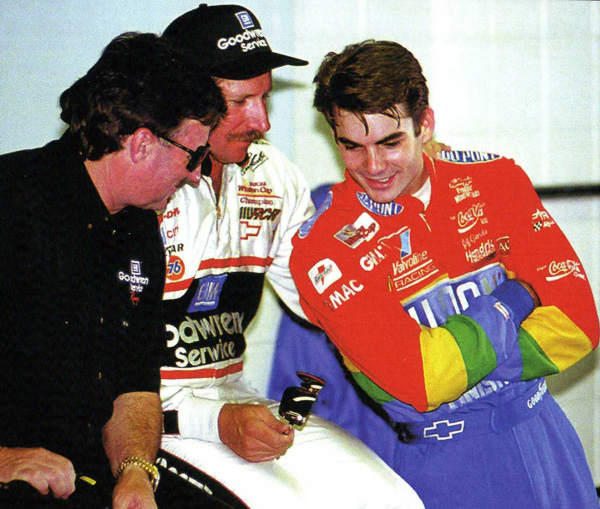 |
|
#1699 - Dale Earnhardt: “I get
along with Jeff, but we don’t travel in the same
circles. He plays video games, I go big-game
hunting. He wears athletic shoes, I wear
boots. What we have in common is that we love to
race.” Photo and quote from
DALE EARNHARDT:
The Pass in the Grass, Edited by
Joseph J. Bannon, Jr., (Christopher A. Record
Photo) |
|
a |
|
 |
|
#1698 - In the fall of 2000
things were looking pretty bright for Kevin
Harvick. He had just ended up a remarkable
rookie season in the Busch Series as part of the
Hendrick organization. He got three wins and a
third-place finish in the standings. From
SECOND TO NONE: The History of the NASCAR Busch
Series, by Rick Houston (Phil Cavali
Photo) |
|
A |
|
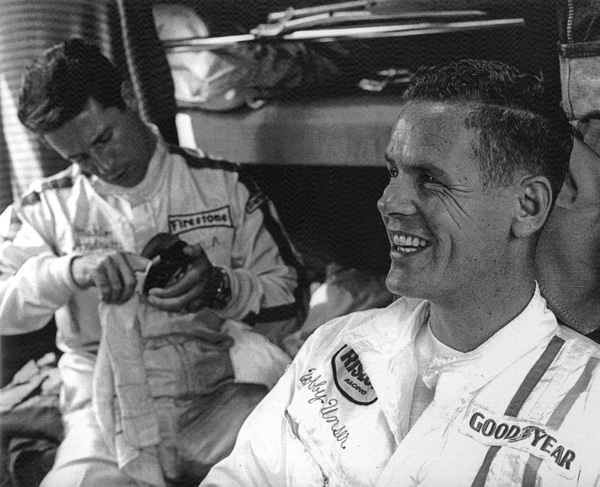 |
|
#1697 - This is a follow-up
to Photo of the Day #1652.
It seems that Bobby Unser was with Mario
Andretti on an incredible weekend that was
actually in 1968, not 1971. Here are the two at
Monza on a Friday, getting ready to practice for
the Italian Grand Prix. Afterwards, they hustled
back over the Atlantic to run the Hoosier
Hundred on Saturday and then it was back to
Europe for the Formula 1 event. But there was a
rub. The FIA would not let them run because no
driver was supposed to compete in two racing
events in a 24-hour period. Here’s what Bobby
had to say: “That was all political stuff, the
crap they pulled on us at Monza. They let us fly
all that way for nothing. And then, we drove all
the way from the airport like idiots, maniacs,
trying to make it. I risked both Mario’s and my
life just getting to the race track. We ran on
sidewalks through towns, Italian cops were
wavin’ their arms and yellin’ at us, we just
went and went. Mario read the signs, tell me
where to go, and I’m drivin’. Stupidest thing
I’ve ever done. And all the time, we wasn’t
gonna have a chance to run anyway.” From
THE AMERICAN LEGACY IN FORMULA 1. |
|
a |
|
 |
|
#1696 - Before the merger
with Mercedes, Karl Benz hired Hans Nibel to
revise some of his designs. This car didn’t look
like much, but it did win the 1908 French Grand
Prix. (Note the below level pits!). It was
actually pretty rugged. It won the St.
Petersburg to Moscow race that year when Victor
Hemery hustled it over 429 miles of what were
called “virtually non-existent roads” at an
average of 51 mph. From THE BOOK OF SPORTS
CARS, by Charles Lam Markmann and Mark
Sherwin (Photo Courtesy of Daimler-Benz A.G.) |
|
a |
|
 |
|
#1695 - Some days are
diamonds, some are stones, according to crooner
John Denver. Bill Vukovich would likely have
agreed. Here he surveys the situation in 1940 at
California’s Atlantic Speedway, on land that is
now the Long Beach Expressway. From
DISTANT THUNDER: When Midgets Were Mighty,
by Dick Wallen (Dick Wallen Collection) |
|
a |
|
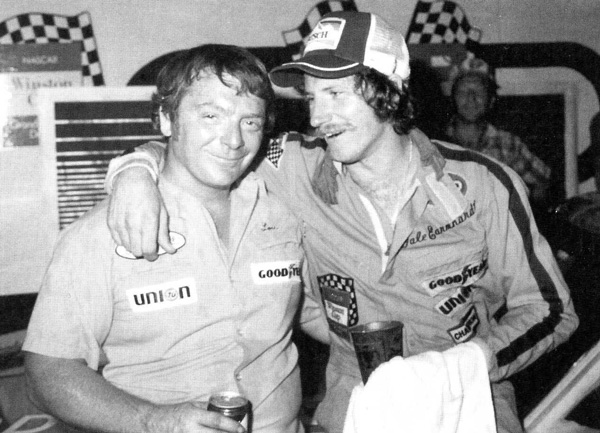 |
#1694 - It was season’s end
37 summers ago. Dale Earnhardt had just won the
Rookie of the Year award for 1979. Here he
conferred with motor man, Lou LaRosa. He said
about the award, “That ain’t shit. I don’t care
about that. I want to be Winston Cup champion
next year.” That worked out just fine. Photo and
Quote from THE LAST LAP, by Peter
Golenbock. (Lou LaRosa Collection)
|
|
A |
|
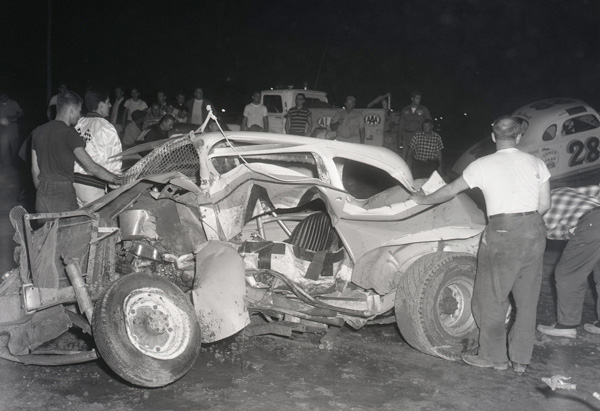 |
|
#1693 - It was dirt days at
Stafford Speedway, on the backstretch just
outside the pit area, September 4, 1964. Gene
Bergin got sideways in Sharkey Gaudiosi’s
Plymouth coach and was drilled big time by Don
Rounds and Dick Bundy. All three drivers were
injured, Gene most seriously. It is thought that
the only thing that saved him was the center
seating, and it was a year before he climbed
into another race car. It was a tough night for
Sharkey, too. That’s him in the white T-shirt
thinking about all the work he has to do. From
A HISTORY OF AUTO RACING IN NEW ENGLAND
by the North East Motor Sports Museum. (Shany
Lorenzet Photo) |
|
A |
|
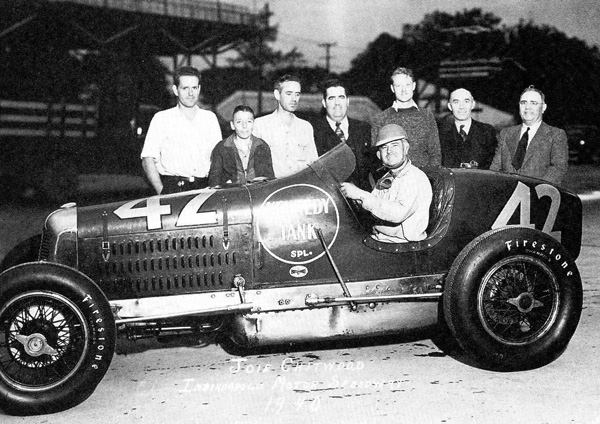 |
#1692 - This was Joie
Chitwood’s first official photo at Indy. It was
taken in 1940. But it was the next year that he
made history at the Brickyard. He became the
first person to run the 500 with a seatbelt. In
his words, “A lot of guys didn’t use seat belts
in race cars. They wanted to get thrown out if
the car crashed. Rex Mays and Wilbur Shaw were
head of AAA Drivers’ Association and they had a
rule that at Indianapolis seat belts would not
be used. I couldn’t hold my foot on the
accelerator because I was bouncing up and down
so much. I tried to get the owner to change the
car and he said ‘No, if you don’t want to drive
it, we’ll get someone else.’ So I went out to my
dirt track car and got my seat belt and put it
in. When Rex Mays and Wilbur Shaw found out
about it, they came to me and tried to stop me
from using it. I told them, ‘I’m doing this so I
can stay in the car and drive it. I won’t be
able to qualify if I don’t.’ They finally let me
use it after I promised to release the belt if I
thought I was going to crash, something I never
did at Indy. In fact, I never spun at Indy or
was I involved in any of the wrecks.” From
SAFE AT ANY SPEED: The Great Double Career of
Joie Chitwood, by Jim Russell and Ed
Watson.
|
|
c |
|
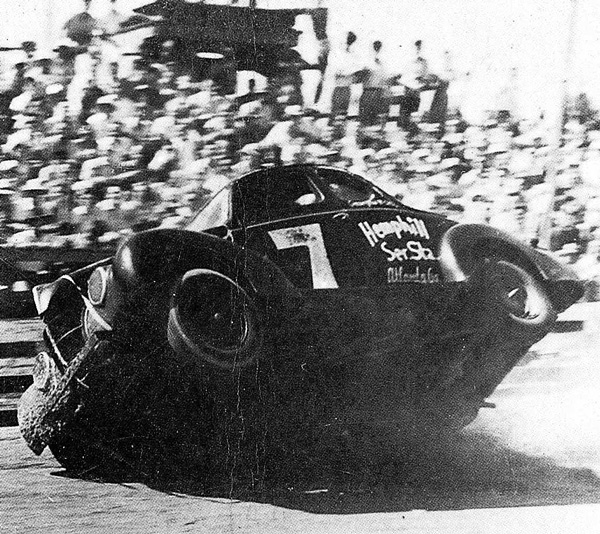 |
|
#1691 - This was Lloyd Seay
not exactly tiptoeing his way around the North
Turn of Daytona’s Beach Road track. He was
full-time spectacular, as was acknowledged by
Bill France Sr., who called him “the greatest
stock car driver who ever lived.” In one feature
the Dawsonville driver was said to have flipped
twice and still finished fourth. On August 24,
1941, he swept the Daytona field (which included
his cousin Roy Hall, about whom Jim Croce sang
the song “Rapid Roy the Stock Car Boy”). Seay
led every lap of the 160-miler. But just eight
days afterwards, he was shot to death by another
cousin, Woodrow Anderson, following a dispute
about moonshine. Quote and photo from
NASCAR: The Complete History, by Greg
Fielden |
|
a |
|
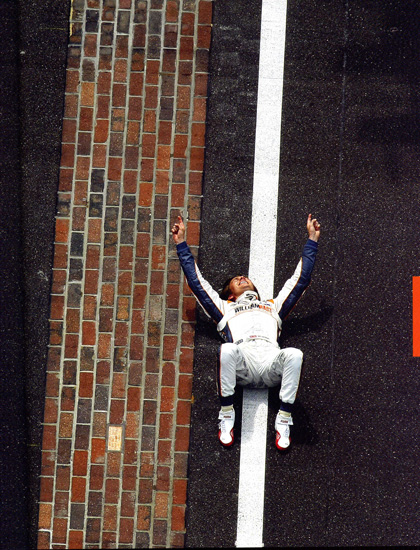 |
|
#1690 - The finish of the
2011 Indy 500 could only be described as drama
on steroids. An articulate young racer from
California surprised everyone by leading the
very end of the race only to go wide off the
fourth turn, brush the wall, and end up second.
The winner, the late Dan Wheldon was taken
aback: “I just felt so much relief. Obviously I
knew he was okay because I could see him moving.
I’ve been runner-up for two years before this
and I never gave up. I mean Kanaan nearly put me
in the wall going into three which was very,
very interesting but there’s a lot of great
storylines today….It’s just an incredible day.
I’m taking my kids to Disney, baby; I’m taking
my kids to Disney.” Quote and Photo from
LIONHEART: Remembering Dan Wheldon, by
Andy Hallbery and Jeff Olson. (Dan Helrigel/IMS
Photo) |
|
a |
|
 |
|
#1689 - Those are IMCA
Modifieds off the fourth turn on the third-mile
dirt of Boone Speedway in Iowa. Doesn’t the
flagman look a little nonchalant to you? From
RACING THROUGH TIME: A History of Automobile
Racing in Iowa, by Bill Haglund. (Bruce
Badgley Photo) |
|
a |
|
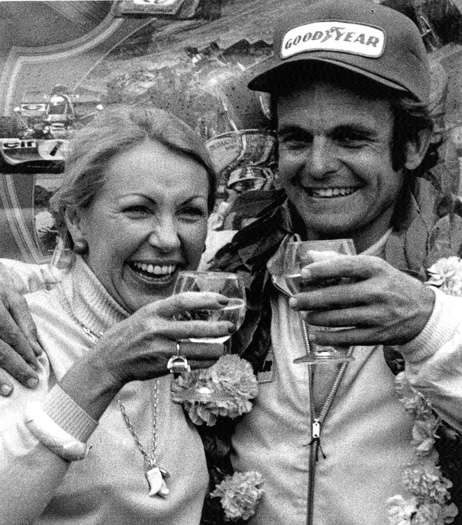 |
|
#1688 - Here’s star-crossed
American Peter Revson in arguably his finest
moment. Celebrating with Joan Cahier, wife of
the famous French motorsports photojournalist
Bernard, Revson had just won the July 14, 1973
F1 event at Silverstone in England. The handsome
Revson was heir to the Revlon Cosmetics fortune,
but passed it all up to become a road racer. He
spoke of how “my old man was secretly hoping I’d
fail and return home.” Unfortunately he died
eight months later testing in Kyalami, South
Africa. His brother, Douglas, had died in 1967
in a race car in Denmark. Quote and Photo from
THE AMERICAN LEGACY IN FORMULA 1, by
Philip van Osten. (Cahier Archive Photo) |
|
a |
|
 |
|
#1687 - Hector “Pappy”
Honore, out of Pana “the City of Roses”
Illinois, had an amazing 32-season career with
open-wheelers. Initially a driver himself,
Honore turned to the wrenches before the war and
won a championship on the MDTRA “Kerosene
Circuit” with Cliff Griffith at the helm. By the
end of the 1967 campaign, Honore had had enough
of the road, having towed an estimated 1,100,000
miles to fairgrounds far and wide. With over 20
wheelmen in the chair – including Spider Webb,
Bobby Grim, Pete Folse, Scratch Daniels, and Don
Branson, Honore and his “Black Deuce” Bardahl
Special racked up 432 wins and is said in
Wikipedia to be the winningest Sprint Car in
history. Photo from
RACING THROUGH TIME: A History of Automobile
Racing in Iowa, by Bill Haglund. (Leroy
Byers Photo) |
|
A |
|
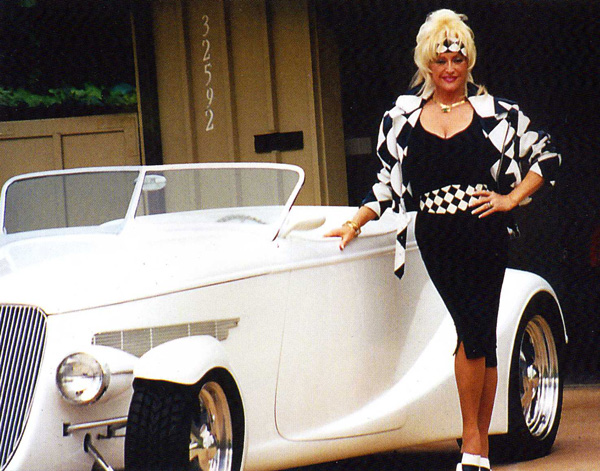 |
|
#1686 - “In my driveway at
home with my hot rod Lincoln. I built the
Lincoln with my boys: Guy Caldwell and Edsel
Ford got me the engine, a 32-valve V-8 from a
Lincoln Mark VIII mounted in the back like a
Ferrari. Gene Winfield painted it, and Carroll
Shelby finished it up for me. We made the SEMA
Car of the Year the same year as the Plymouth
Prowler. We built a hot rod that was affordable
for people to power with either a Ford, Chevy,
Cadillac, Oldsmobile, or any engine. I wanted to
have something affordable for American engines.
I tell women when it’s at a show, ‘There sits my
facelift, tummy tuck, my swimming pool, and my
fence around my house!’ It took nine months to
build so it was like giving birth, but I’m glad
I built it. My boyfriend Greg Chamberlain took
the photo.” From
LINDA VAUGHN: The First Lady of Motorsports,
by Linda Vaughn with Rob Kinnan. |
|
a |
|
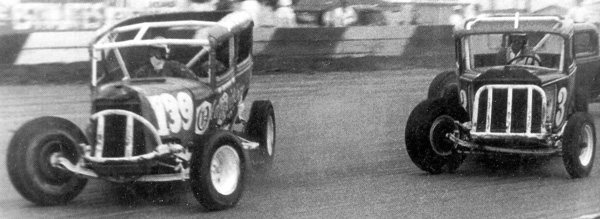 |
|
#1685 - It was first-turn
action at Gardena (CA) Stadium in the 1950s with
the notorious California Jalopy Association.
That was quite a popular spectacle back then in
Southern California, as often 100 cars would
turn up to try to qualify for the main. Parnelli
Jones commented, “Take it from me, the
competition wasn’t just fierce, it was like a
war.” Perhaps it was just the result of survival
in the rough and tumble era, but it sure seems
these two cars had far better cages than the
typical coupe or coach would have looked east of
the Rockies. Quote and photo from MEMORIES
OF THE CALIFORNIA JALOPY ASSOCIATION, by
Thomas D. Luce. (Dick Barry Collection) |
|
a |
|
 |
|
#1684 - Standing tall over
his roadster at the Brickyard in 1956 was Frank
Kurtis, all 6’ 4” of him. The 1956 “500E” was
lower and lighter than previous versions. Johnny
Boyd was in the cockpit, while George Bignotti
turned the wrenches. Unhappily, they sprang an
oil leak after 35 laps, and that was the name of
that tune. From INDY
CARS of the 1950s, Ludvigsen Library
Collection. |
|
a |
|
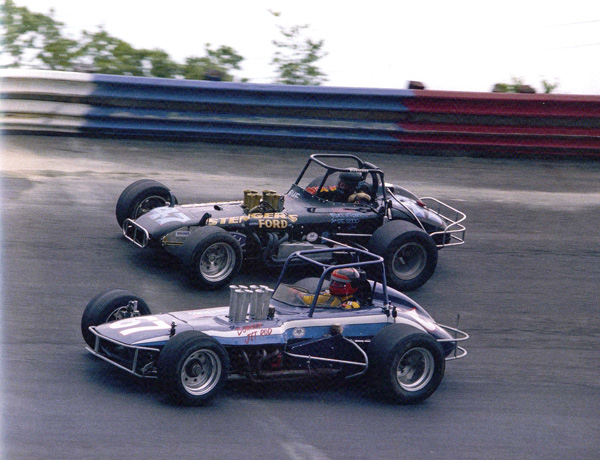 |
|
#1683 - Beautiful “roadster”
Sprinters. Marvin Carmen in the Jet Engineering
Special has a slight lead over Jeff Bloom in a
USAC show at Dayton, Ohio, July 1, 1979. From
UNITED STATES AUTO CLUB: Fifty Years of Speed
and Glory, by Dick Wallen. (Armin
Krueger Photo) |
|
A |
|
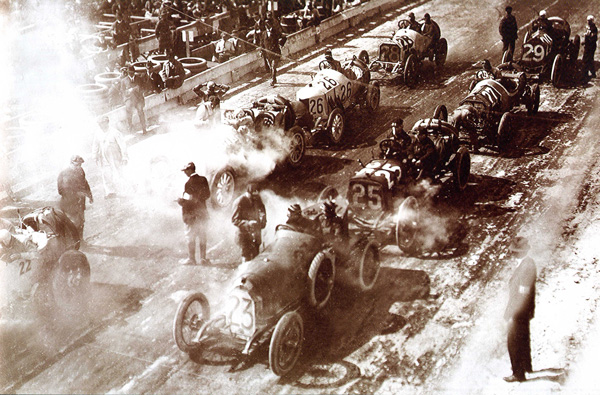 |
|
#1682 - Mercifully, the EPA
emissions-testing team was nowhere to be seen at
the Vanderbilt Cup in Milwaukee on October 2,
1912. Here the starting field of eight warms up
for the 300-miler. By the look of the pit boxes,
tire chargers were planning to be pretty busy.
The race was won by Ralph De Palma and his
mechanic Tom Alley. They were in the #22
Mercedes on the outside pole. From
The 1912 Milwaukee Races: Vanderbilt Cup and
Grand Prize, by Joel E. Finn. |
|
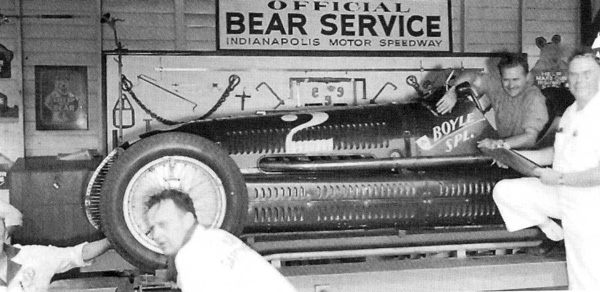 |
|
#1681 - That’s Wilbur Shaw
aboard the Boyle Special at Indy in 1941. He was
on the Bear Shops alignment table after
qualifying third at 127.836. The race did not
turn out exactly as planned for the star driver
and team. He completed 151 laps ending up in
18th, but there’s quite a back story. There was
a fire in the garage area early in the morning
on race day. A wheel that had been marked as
defective had the markings washed off in the
fire’s aftermath. And somehow that wheel ended
up on the car, and it collapsed. Shaw, who was
leading, crashed, ending his pursuit of three
wins in a row. From
A PICTORIAL VIEW OF THE BEAR SHOPS AT
INDIANAPOLIS, by Richard. J. Iverson |
|
a |
|
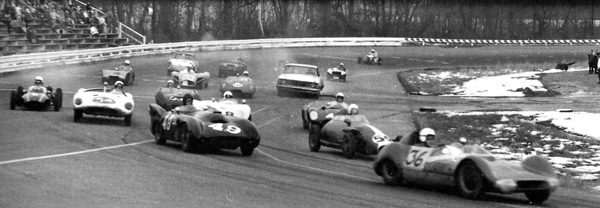 |
|
#1680 - Between the mid-‘50s
and the late ‘90s there was a 1/3-mile paved
oval and a 1.6-mile paved road circuit in Upper
Marlboro, MD, called Marlboro Motor Raceway. One
of their more interesting events, often run in
January, was the Refrigerator Bowl. By the time
this photo was taken in 1963, the field had
become amazingly diverse. Would you have wanted
to insure it? Elmo Langley showed up in a Ford
Galaxie he was getting ready for the Daytona 500
and he ran fifth. Dick Thompson and three others
in Corvettes would beat him to the line. Also in
the field was a V-8-60 Midget, a go kart, and
some Formula Juniors. From LOST ROAD COURSES,
by Martin Rudow. (Bill Dobbins Photo) |
|
Z |
|
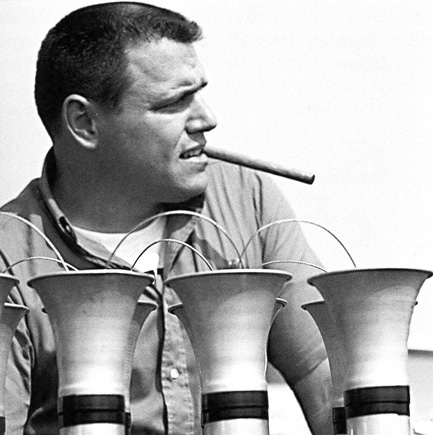 |
#1679 - If it had Mopar
power and doors and ran real fast in a straight
line during the Muscle Car Era, it may well have
belonged to Dandy Dick Landy. The San Fernando
Valley native and racing Hall of Famer was a
promoter’s delight – spotless in appearance with
perfectly coiffed hair and perpetually unlit
cigar, and gloriously fast with his
wheel-standing assaults on drag strips
nationwide. His career behind the wheel began in
the 1960s and lasted until 1981. He passed away
in 2007 at age 69. From
LANDY’S DODGES, by Geoff Stunkard,
(Photo TEN: The Enthusiast Network)
|
|
a |
|
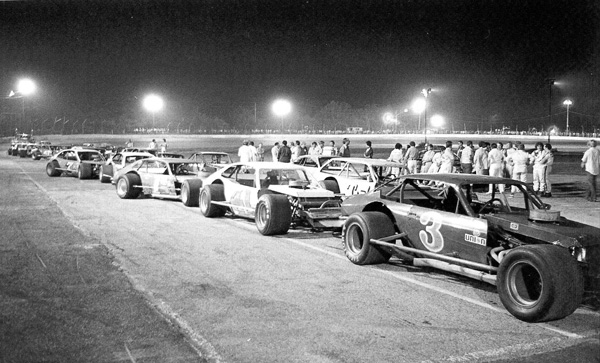 |
|
#1678 - It was a great time
in Modified racing, the start of the 1978 All
Star race at the New London/Waterford Speedbowl.
That was Fred DeSarro in the Boehler #3, Bugs
Stevens in the Brady #4, Fred Schulz in the Dunn
T-5, and Geoff Bodine in the Armstrong #1. It
was also a seriously great time for Bodine. He
won this one along with 54 others in 84 starts
that year. From
MODIFIED STOCK CAR RACING OF THE ’60s and ’70s,
by Steve Kennedy. |
|
a |
|
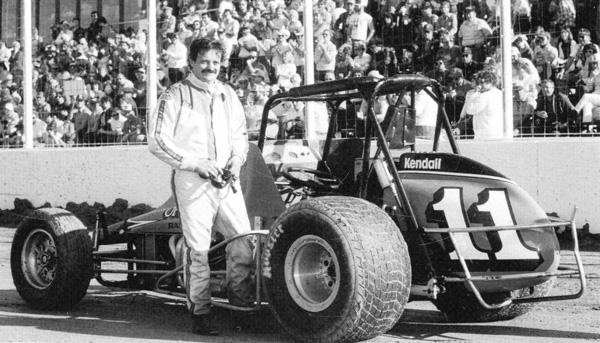 |
|
#1677 - “Jerry Stone
was a three-time NCRA kingpin driving for car
owner Lloyd K. Stephens. Stoney stepped onto the
national stage out of nowhere in 1977, when he
whipped a stellar field of USAC Midgets at the
Seattle Kingdome, driving a Midget built by
Jelly Wilhelm and powered by a Wilson V-4, built
by Jerry Wilson. All three were Wichita, Kansas,
locals. Stephens was a fair but demanding car
owner of NCRA and USAC Champ Cars and WoO
Sprints. Lloyd handled his tenure as Chairman of
the Board of Ofixco (Oklahoma Fixture Company)
the same way. When the board inquired about the
non-stop spending on dirt track cars, Stephens
informed the board that the company was broke
when he started it, and it would be broke when
he finished. They voted him out, and Ofixco was
bankrupt in two years. Stoney was one of
Stephen’s most bankable employees and he looks
ready to go at Tampa in 1985.” Quote and Photo
from
COMPETITION PORTRAITS: The Dirt Champion Cars,
by Bob Mays (John Mahoney Photo) |
|
a |
|
 |
|
#1676 - That’s Christie
Vilsack, wife of Tom Vilsack, our current
Secretary of Agriculture. Prior to going to
Washington, he was Governor of Iowa and she was
First Lady. On July 1, 2000 she snuck out of the
Governor’s Mansion and competed in a Thunder Car
event at 34 Raceway in West Burlington, Iowa.
She ran fourth. From
RACING THROUGH TIME: A History of Automobile
Racing in Iowa, by Bill Haglund |
|
a |
|
 |
|
#1675 - Lionel Arel was an
old-time dirt tracker around New England. He
looks pretty pleased with himself in this image
and he had a right to be. He had just won the
annual Fair Race at the old Stafford Speedway in
Connecticut, his second victory there that year.
Arel was a particular favorite at the infamous
Rhythm Inn Speedway up across the state line in
Millers Falls, MA, where he was the top of the
National Speed Sports News’ ballots for most
popular driver. Our reader Stan Klepadlo recalls
that Arel used the same Chrysler engine in his
hauler and his race car. One night he blew up in
the heat, so the crew replaced the engine with
the one in the truck. The crew might have missed
some of the traditional post-race beers at the
adjoining Rhythm Inn where the payoff was
distributed. They were busy putting the engine
back in the truck in order to get back home to
Northampton, MA. (North East Motor Sports Museum
Collection) |
|
a |
|
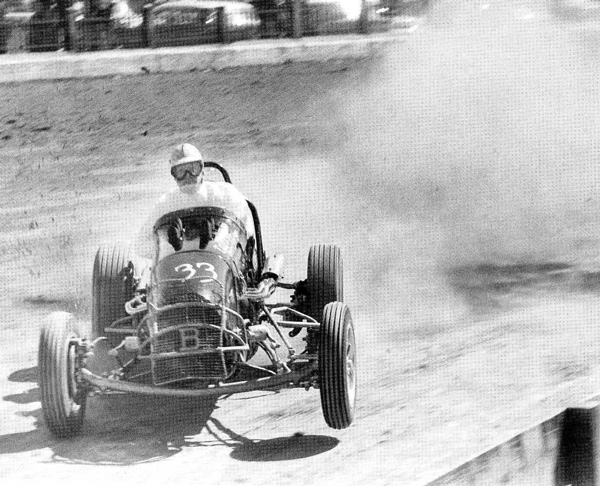 |
|
#1674 - Every photo of the
Reading (PA) Fairgrounds seems to convey a sense
of serious speed. There is no question about why
from anyone who saw a race there. Here is Joe
Barzda in his Chevy-powered stretch Midget
stretching a lead in the September 15 USAC
Eastern Sprint Car Series feature in 1957.
Running like a rabbit paid off big time. Rain
came on the 13th round of the scheduled
20-lapper, the race was called, and Barzda won
it. He was followed by a gaggle of Offies,
ridden by Johnny Thomson, Tommy Hinnershitz, and
Bill Randall. From The EASTERN BULL RINGS:
The History of the Eastern Big Car Championships
1945-1960, by Buzz Rose. (Dave Knox Photo) |
|
a |
|
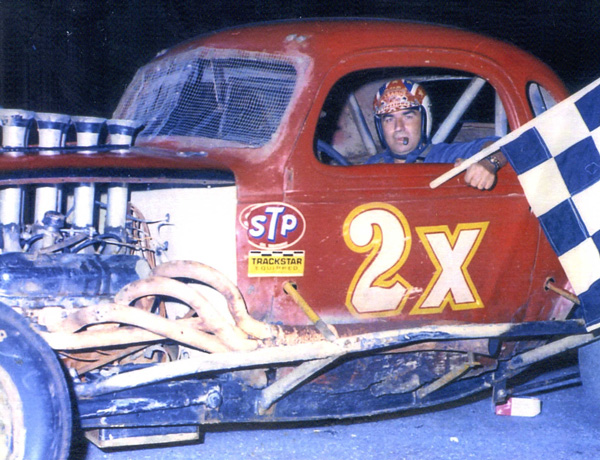 |
#1673 - Bobby Judkins is one
of the all-time great East Coast Modified
owners. His most famous coupe, shown here, came
right before his #2x compact that launched the
Pinto Revolution. The coupe was a true utility
car, never polished and burnished, but there at
every race – small track, large track, pavement
or dirt – always in the hunt. And what a bunch
of executives sat in that office! They included
Gene Bergin, Fats Caruso, Jim Hurtubise, Kenny
Shoemaker, Eddie Flemke, and, as shown in this
shot from a pavement All Star show, the
irrepressible Rene “Champ” Charland. The car has
been restored, complete with those glorious
injectors, by Long Island’s Phil Elliston.
(Elliston Family Collection)
|
|
a |
|
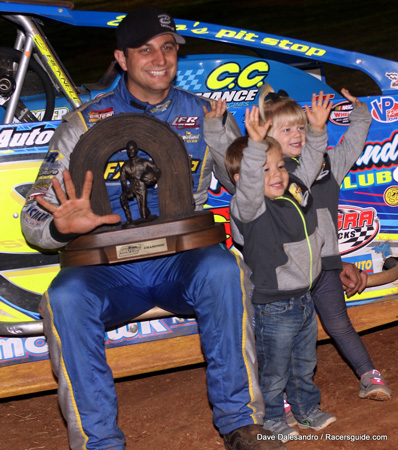 |
#1672 - Wheeling a car owned by a team
he formed just last winter, pole-sitter Super
Matt Sheppard ran away from the 28 car at the
40-lap Charlotte World Finals on October 28.
He’s shown celebrating with his niece and
nephew. He had every right to – he had set a new
record for the number of features won in one
season on the Super DIRTcar Series. “A dream
season,” he called it. Photo by our Man from
Amsterdam, Dave Dalesandro
|
|
a |
|
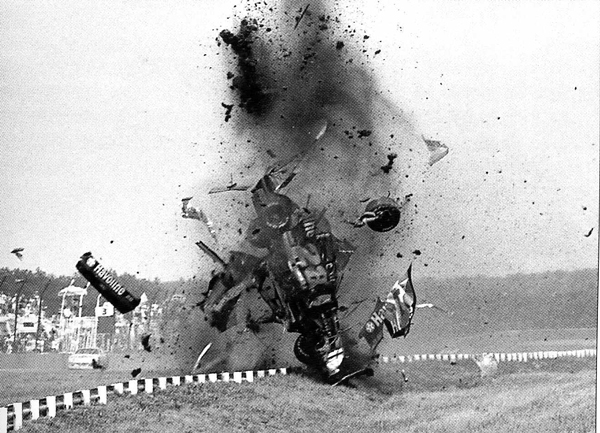 |
#1671 - Davey Allison, the 27-year-old
winner of the 1992 Daytona 500 and red hot in
the other early-season races in his
Texaco-Havoline Ford, had his season take a
serious hit at Pocono, on July 19. After contact
on his rear quarter by Darrell Waltrip, Allison
went for quite a ride, a catapult followed by
barrel rolls. He had a bad concussion, a broken
wrist, arm, and collar bone. Allison had been a
closely followed contender for the Winston Cup
that year. The title ended up being won by
“Special K,” Alan Kulwicki in the Hooters Ford.
Kulwicki would die the following April in a
place crash. From
NASCAR'S GREATEST RACE: The 1992 Hooters 500,
by Rick Houston (Jim Smith Photo)
|
|
A |
|
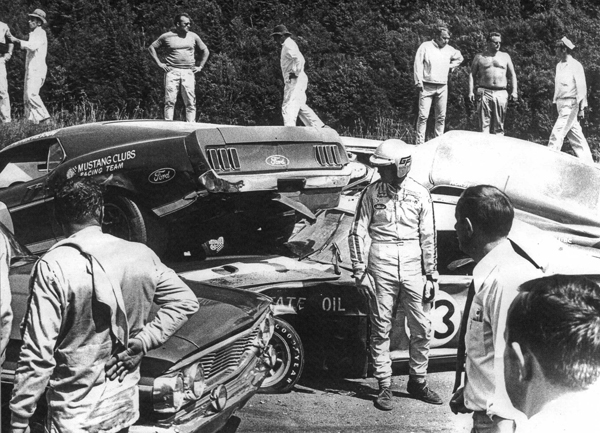 |
|
#1670 - As Daniel Lipetz’s
cool new book (TRANS-AM
ERA: The Golden Years In Photographs: 1966-1972)
makes clear, those Trans-Am guys were on the
hammer. Here was the scene at St. Jovite - Mont
Tremblant in Quebec in 1969. “George Follmer
inspects the carnage resulting from his blown
engine and poor flagging by course workers.
While a marshal did display a yellow flag, the
oil flag only came out when Follmer took it from
another marshal after decking him. Vic
Campbell’s #73 Firebird and Peter Revson’s Boss
302 joined the fray. Revson actually arrived at
the scene after Campbell, yet he still wound up
high on the pile of cars. Revson later said he
‘saw the waving yellow flag and slowed down to a
speed I thought would get me through anything.’
Amazingly, he was unhurt from the initial impact
but he was so stunned that he failed to realize
he was several feet off the ground when he
exited the car. He suffered minor ankle and
shoulder injuries in the fall.” (Photo Don
Markle Collection) |
|
a |
|
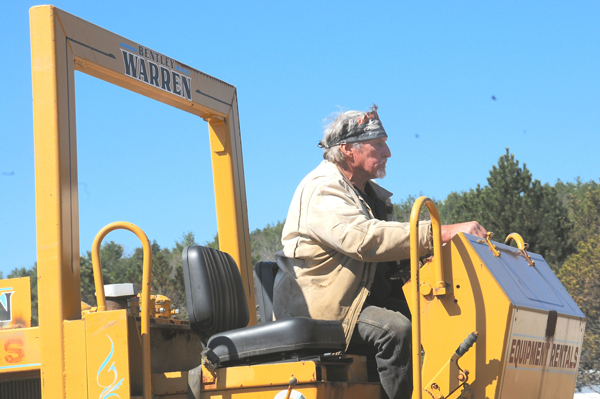 |
|
#1669 - The racing world remembers
Bentley Warren as one of the most successful
Supermodified drivers in the sport’s history.
With seven Oswego Speedway championships and six
Oswego Classic wins he’s one of the greatest
all-time in that track’s storied history. But,
in addition, he won the Little 500 in Anderson,
IN, twice and earned 45 ISMA wins. He won the
Star Speedway Classis six times and the Sandusky
Hy-Miler three times. Now nearing his 76th
birthday, Bentley begins each day before the sun
rises with a power-walk through the
neighborhood. His plate is full as owner of a
huge sand-and-gravel trucking operation and New
England’s most successful biker Bar,
Bentley’s
Saloon in Arundel, ME. He recently completed
construction of a huge auto museum on his estate
in Kennebunk, ME. Bentley’s also one of the most
significant personalities in the creation of the
North East
Motor Sports Museum, where he’s donated
heavy equipment (such as he’s shown driving at
the museum) for the site work, been a major
donor to the project and has been one of the
go-to people who have helped shape the project’s
major decisions. (Photo and caption by Dick
Berggren) |
|
a |
|
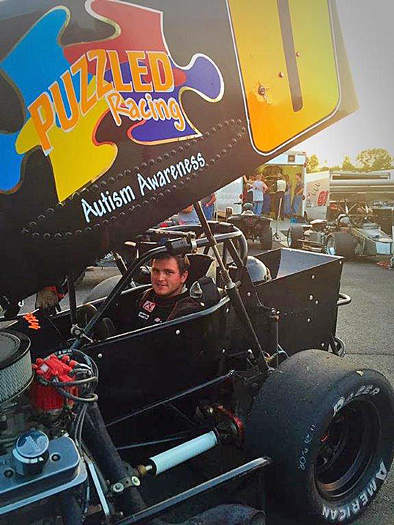 |
|
#1668 - Brad Babb comes a
racing family in Maine, and he's on the gas. At
24 he already has a Super Late Model
championship at Beech Ridge, Maine, and all
kinds of Late Model wins. He'd always wanted to
try an Open Wheeler and got his chance in the
Small Block Super Modified race at this year's
Star Classic in Epping, New Hampshire. He
recalls, "It was different for sure. When I
pushed off, I felt with no roof and windshield
that I was actually outside of the car. And it
was SO MUCH faster into and out of the turns.
The biggest things were not having a mirror and
a spotter. You've gotta keep your eyes and ears
open!" Remarkably, he ran second in the main.
(Photo Babb Collection) |
|
a |
|
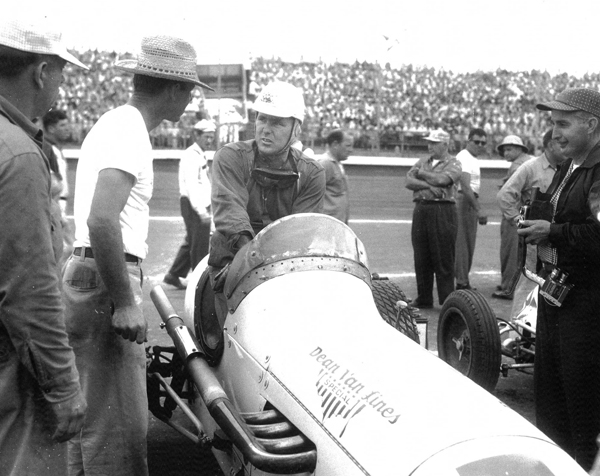 |
|
#667 - The best in the
business. Jimmy Bryan and Clint Brawner confer
before the AAA race at Langhorne on Sunday, June
19, 1955. They won, but with drama in a show
that lasted a week. On lap 44 Johnny Thomson
spiraled into a wicked end-for-end in front of
the grandstands. He ended up unconscious, pinned
beneath the Pete Schmidt Special #44. Brawner
“braving the traffic, ran out and rocked it off
the badly injured driver.” That’s when the rains
came. A busy Brawner was quick to whisk his Dean
Van Lines Special out of the place when he
realized the event was about to be rescheduled
for a week. There is no way he wanted his car
impounded anywhere. Bryan had reported the
engine was making naughty noises. Brawner
rebuilt it over the next few days, replacing a
broken valve guide and a bent valve. On the next
Sunday, Bryan continued his unique high groove
assault on the circular mile, and they won.
Quote from
LANGHORNE!: No Man’s Land, by L.
Spencer Riggs. (Photo by Charles Zulla, Ken
Edsell Collection.) |
|
A |
|
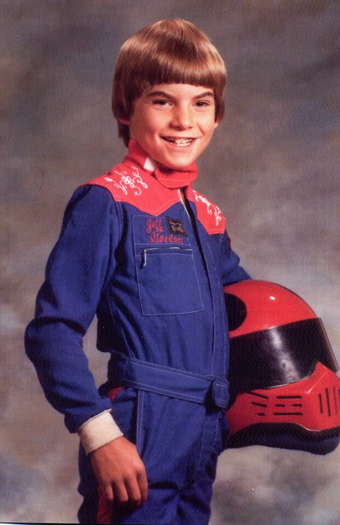 |
|
#1666 - "The Wonder Boy"
when he was the Wonder Kid. Jeff Gordon was
lookin’ pretty preppy at age seven. His stepdad,
John Bickford, had just given him this Simpson
uniform. It had to be specially ordered from
Bill Simpson because uniforms this small were
certainly not listed in the catalogue. From
JEFF GORDON: His Dream, Drive, and Destiny,
by Joe Garner. |
|
a |
|
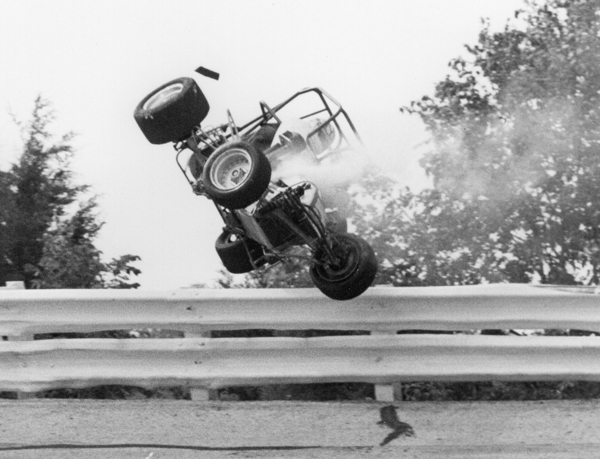 |
|
#1665 - "Long-time
Midwesterners will recall the miserable summer
of 1988, when drought and many 100-degree days
marked the summer. As the racing season was
winding down, Danny Williams Jr. had a
particularly bad day at Salem (Indiana). Bruce
Fields spun and collected Williams. But
typically for Salem, it didn’t stop there.
Williams went airborne and vaulted the fence.
Because of the drought, his hot header pipes
caught a pine tree on fire. It took some time to
get rescue personnel to him, and meanwhile, his
parents were convinced he could not have
survived the horrendous wreck and fire. In one
of those inexplicable racing moments, not only
was Williams alive, but at least part of the
tree survived as well." Caption and photo from
DID YOU SEE THAT? Unforgettable Moments in
Midwest Open-Wheel Racing by Joyce
Standridge. (Allen Horcher Photo) |
|
A |
|
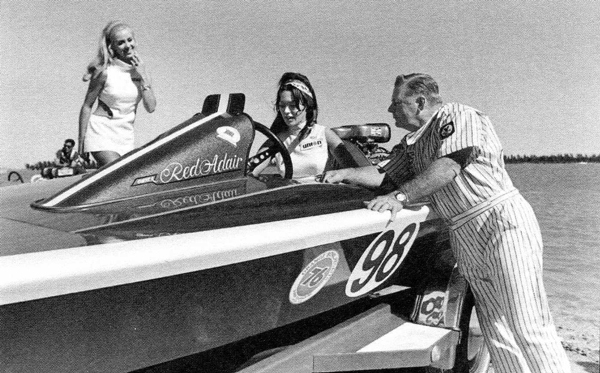 |
#1664 - Back in the
1970s, a common and comical response to “Where
ya been?” was “Off fightin’ oil well fires and
chasin’ wild women.” Likely the most famous of
all the real well-fire fighters was the
unstoppable Red Adair. Among other things he was
a power boat racer and APDA Hall of Famer.
That’s Red on the right, showing Racestopper
Sharon Brown the cockpit of one of his boats. He
passed away in 2004, age 89. But it would seem
he had all that covered, too. Upon his death,
newspaper clippings quoted him saying, “I’ve
done a deal with the devil. He said he’s going
to give me an air-conditioned space when I go
down there so I won’t put any fires out.” Photo
from WHEN THE LEGENDS BEGAN: Thirty Years of
Racing Photography through the LENS of Pal
Parker.
|
|
a |
|
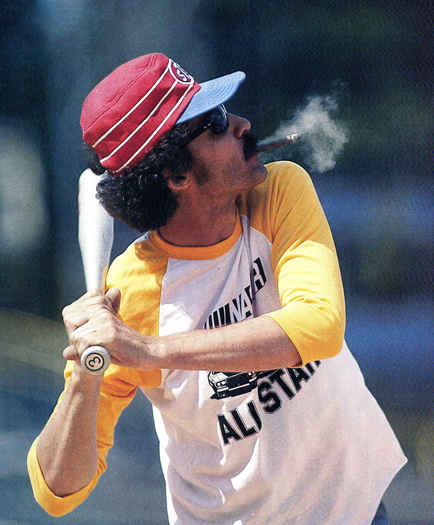 |
|
#1663 - Some guys were born
to play baseball and some just weren’t. Photo
from GRAND NATIONAL STOCK CAR RACING,
by Randy Hallman and Bob Jones |
|
A |
|
 |
|
#1662 - The normally
Chrysler-oriented Carl Kiekhaefer operation ran
a Ford at the short-lived but infamous 1.5-mile
dirt Memphis-Arkansas Speedway in Lehi,
Arkansas. Speedy Thompson was aboard and
captained it to the win with an impressive 84.72
mph average, two laps ahead of Marvin Panch. The
exhaust system was pretty impressive, too. From
FULL JEWELLED: Stock Car Racing 1951-1961,
as told to Russ Hamilton. |
|
a |
|
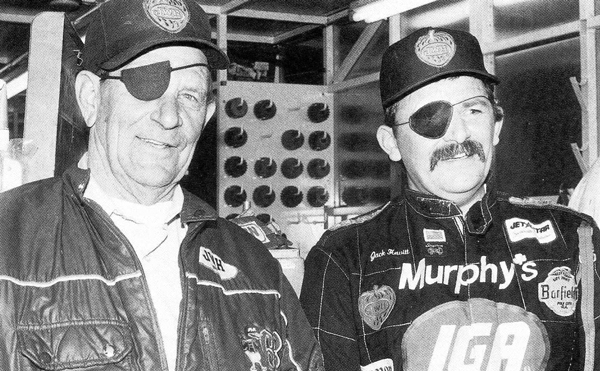 |
|
#1661 - Earl Baltes once
recalled that the very first driver ever to go
around Eldora – even before it was graded – was
Don Hewitt, Jack’s dad (L). This shot of them
was taken by Phil Kunz in 1993 when Jack was
wearing the result of an accident – or maybe
some other kind of altercation. From
ELDORA SPEEDWAY: The Most Famous Short Track in
America, by Bill Holder with Earl
Baltes. |
|
a |
|
 |
|
#1660 - They call him
“Sunshine,” and he managed to keep the sunny
side up. That was Tyler Courtney qualifying on
the cushion at Lincoln Park Speedway,
Putnamville, IN. From the
Paul Oxman 2017 Sprint Racing Calendar
. (David Nearpass Photo) |
|
a |
|
 |
|
#1659 - It seems kinda
surprising that he tried that. “Hard Luck Lloyd”
Ruby was fourth in 1968 National Championship
points going into the September 2 race at Du
Quoin. He showed up with the rear-engined
Mongoose-Drake Gene White car. He had won both
of the Milwaukee races in the car, but it just
didn’t cut it on the dirt. He probably didn’t
feel too badly, though. Other non-qualifiers
included Bud Tingelstad, Larry Dickson, Rollie
Beale, Wally Dallenbach, Greg Weld, and Bobby
Grim. From THAT MAGIC MILE: The National
Championship at Du Quoin 1948-1970, by
Thomas Nasti (Southern Illinoisan Photo) |
|
A |
|
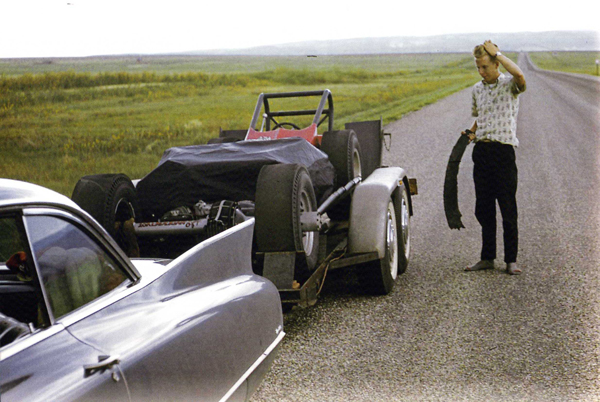 |
|
#1658 - TV Tommy. From LOST
DRAG STRIPS II: More Ghosts of Quarter Miles Past,
by Scotty Gosson, (Tommy Ivo Collection) |
|
a |
|
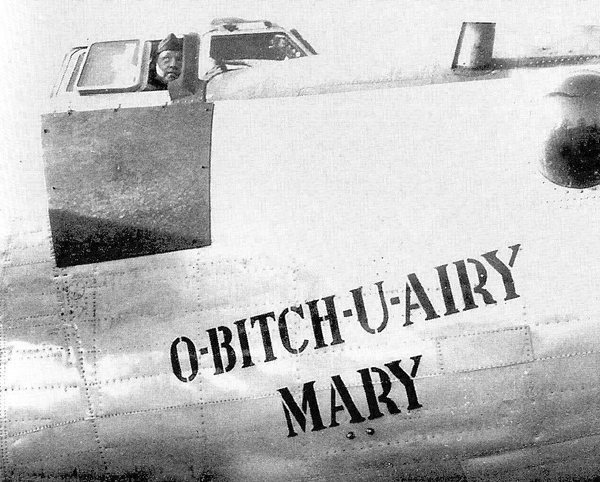 |
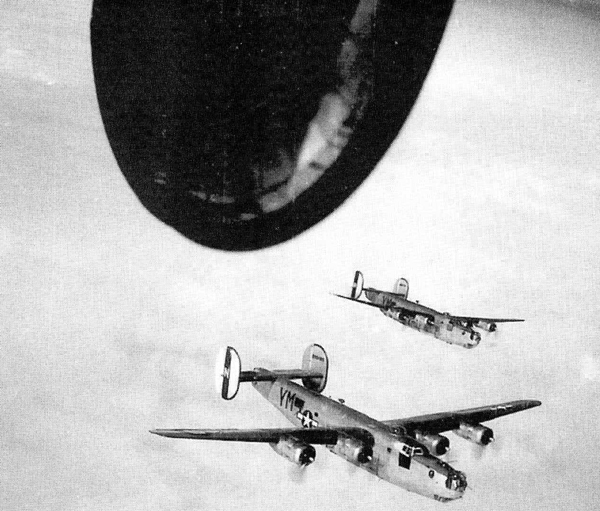 |
|
#1657 - That’s Cheektowaga,
New York’s Captain Vern Harriman aboard the
Consolidated B-24 Liberator, “O-Bitch-U-Airy
Mary” that he flew in 35 missions in World War
II. The last lap was over Berlin when he was
hit, knocking out both engines. In the second
photo the O-Bitch-U-Airy Mary (in the
foreground) is damaged and separates from the
rest of the squadron. Fortunately, one engine
sputtered back to life, and Harriman was able to
sneak low back across the English Channel. But,
then, to make things even worse, despite his
radio communications, the British batteries
opened up on him. Somehow he and his crew were
able to land safely on the three mile long
Woodridge Field. Like many returning American
heroes, he seemed to need continuing excitement,
so he turned to open-wheel racing. He was fast
and aggressive, but was never seriously banged
up. In 1951 he won a Canadian National
Championship. And curiously, he was especially
fast at “the Square,” the old 5/8-mile dirt in
Flemington, New Jersey. He won the Labor Day
weekend URC event there multiple times. He
passed away in 2008. From
DAREDEVILS OT THE FRONTIER, by Keith S.
Herbst. (Vern Harriman Collection) |
|
a |
|
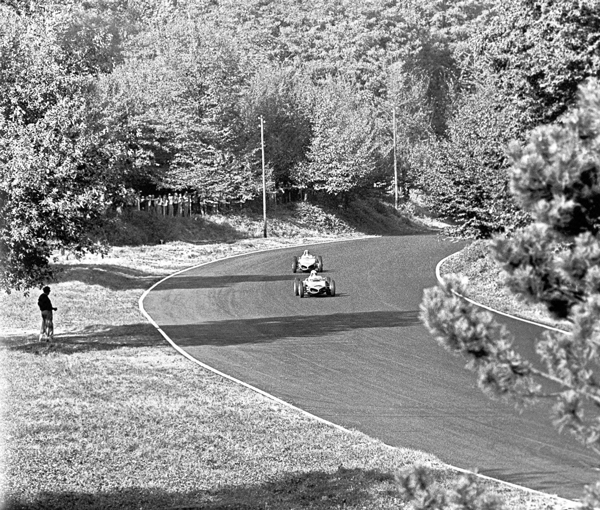 |
|
#1656 - American tourists.
California buddies Phil Hill and Richie Ginther
work their way through Monza’s park in 1961.
From
THE AMERICAN LEGACY IN FORMULA 1,
published by the Circuit of the Americas. |
|
a |
|
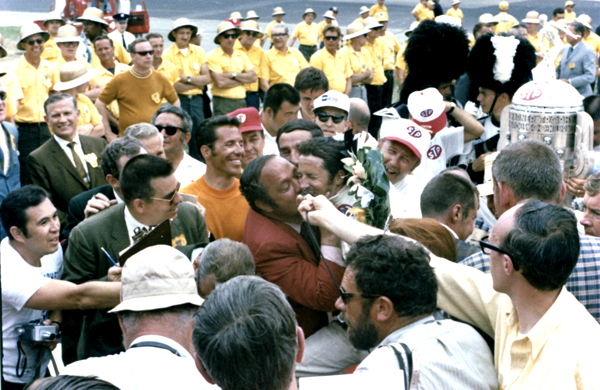 |
|
#1655 - There are very few
ways you can feel sorry for someone who had just
captured the grandest prize in American racing,
but this was one of them. Mario Andretti clearly
had “no place to go” when car owner Andy
Granatelli came running over after they had won
the Indy 500 in 1969. From
FOYT, ANDRETTI, PETTY: America’s Racing Trinity,
by Bones Bourcier (John Mahoney Photo) |
|
a |
|
 |
|
#1654 - Back in the jalopy
days in 1950s, so much racing work was done
creatively by hand – and foot. This a CCRA
driver dealing with a rear-axle problem at the
Orange Show Speedway in San Bernardino in 1954.
From MEMORIES OF THE CALIFORNIA JALOPY
ASSOCIATION, by Tom Luce. (Bill Holmes
Photo) |
|
AA |
|
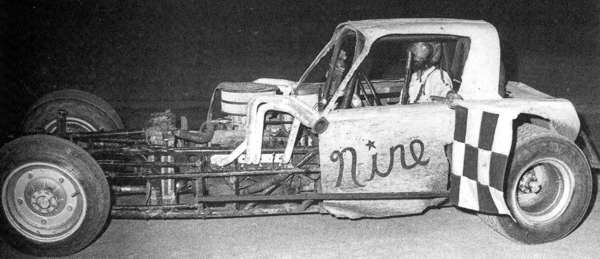 |
|
#1653 - Only rarely do they
come along as cool as Bob McCreadie, the very
popular and very different Modified stalwart out
of Watertown, NY. And perhaps the coolest car of
his many was his ‘Cuda. Dreamed up in his garage
in 1975, it whisked him to his first year of
stardom. He recalls, “Narrower is lighter…so I
called Dick Tobias and asked him, ‘How narrow
can you make a car?’ He paused for a moment and
said ‘I guess until it flops over.’ So that
‘Cuda had a chassis about as wide as my
shoulders. The driver’s compartment of that car
was wicked small…..The first time I drove it
(May 10, 1975 at Can-Am Speedway), I couldn’t
fit into the thing, so I had to take my boots
off to have enough room to work the pedals. The
legend is that’s the night the nickname
‘Barefoot’ got started and it’s stuck with me
ever since.” The photo shows his first Can-Am
feature win, three weeks later. By August 9th, a
bonus was announced for anyone who could beat
him. From BAREFOOT: The Autobiography of Bob
McCreadie, as told to the late Andy Fusco,
(Wayne Storey Photo) |
|
a |
|
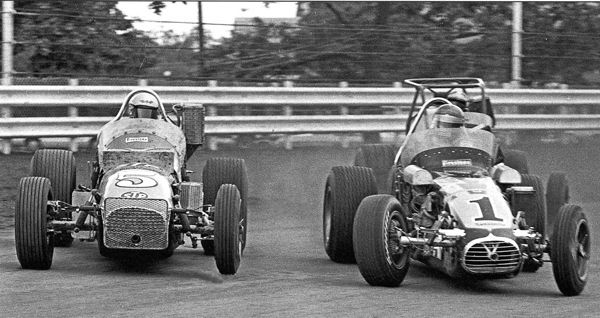 |
#1652 - The way of the big
boys. Mario Andretti in the STP #5 leads the
Hoosier Hundred at the Indiana State Fairgrounds
in 1971, dueling with Al Unser. He had just
qualified a Ferrari at Monza in Italy and flown
back across the Atlantic to Indianapolis. After
his 17th place finish on the dirt, he jetted
back to Monza for the Grand Prix. But there was
a problem. The Federation Internationale de
L’Automobile (FIA) wouldn’t let him run. They
said no driver was allowed to race two times in
24 hours. From FEARLESS: Dangerous Days in
American Open Wheel Racing, by Gene
Crucean.
(Gene Crucean Photo) |
|
a |
|
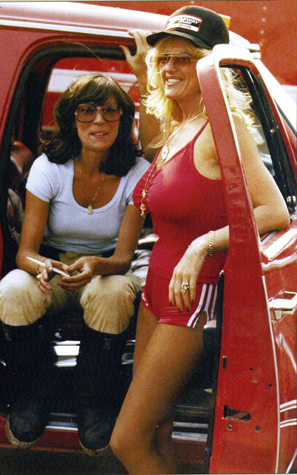 |
|
#1651 - Linda Vaughn’s book
is out and it’s cool. Here’s what she says about
Shirley “Cha Cha” Muldowney (left) : “I was with
her through her hard years, getting started, the
rips she had to take with men in the pits. It
was brand new and therefore a learning
experience for all of us, and she was abused a
lot along the way, but she became a national
monument for all of us. Every time I could help
I was there for her, and she was there for me.”
From LINDA VAUGHN: The First Lady of Motorsports,
by Linda Vaughn with Rob Kinnan |
|
A |
|
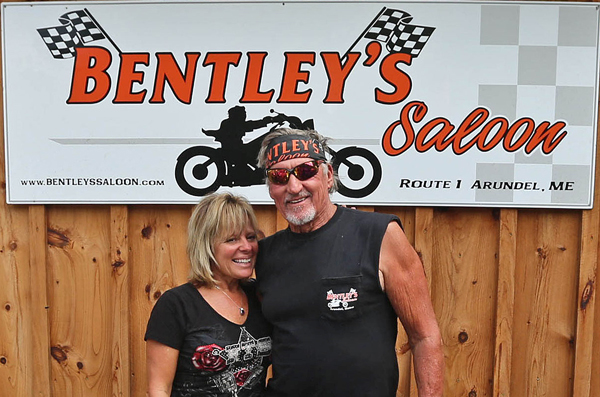 |
|
#1650 - That’s the infamous
Bentley Warren and Lisa Zatalava at his
fabulously popular establishment in Maine. There
is a charm about Bentley that certainly includes
a full measure of joking and almost goofiness.
But in the words of old-time Supermodified great
Eddie Witkum Sr., “Any flies on that guy pay
rent.” Photo from
WICKED FAST: Racing Through Life with Bentley
Warren (as told to Bones Boucier),
Bentley Warren Collection |
|
A |
|
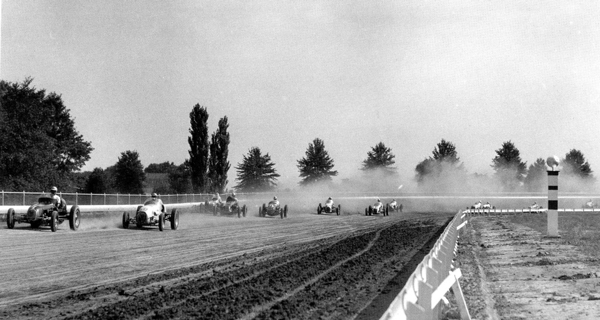 |
|
#1649 - What would you give
to have been right there, right then? It was lap
one the September 100-mile Championship at Du
Quoin in 1951. Leading was Paul Russo, with
Johnnie Parsons, Duane Carter, and Jack McGrath
in pursuit. Tony Bettenhausen took command on
the eighth go-around and never gave it up. From
TONY BETTENHAUSEN AND SONS: An American Family
Album, by Gordon Kirby. (Armin Krueger
Photo, Bettenhausen Collection) |
|
a |
|
 |
|
#1648 - The Mexican Road
Race, run five times in the early 1950s must
have been really something. Here’s what Carroll
Shelby had to say after an incident in the
second leg of the 1,932-mile route. “When I left
Oaxaca, I started dicing with those big
Lincolns, really giving them hell. I passed all
of them except Ray Crawford. I had just passed
Vukovich and was taking off after Ray when I
came around a corner a little too fast. Suddenly
there was a big rock standing in my way. The
rock never batted an eyelash. I went end over
end four or five times like the daring young man
on the flying trapeze. Only it was a lot more
painful….The wheels of the driver’s side were
torn off, as was the passenger-side door. It was
lucky we had decided to drive solo, because if
Roy (Jackson-Moore) had been in the passenger’s
seat, he probably would have been killed.” From
CARROLL SHELBY - A Collection of my Favorite
Racing Photos, by Art Evans with
Carroll Shelby. |
|
A |
|
 |
|
#1647 - The late Dan Wheldon
takes Dale Jr. for a tour around the tight
office of an Indy car. Junior recalls, “I had
just a handful of opportunities to be around
him. You assume that other drivers - whether
they are in NASCAR or Formula 1 - are very
confident. A lot of times when your confidence
and their confidence are in the same range, it
might create a little bit too much ego for one
place. But with Dan, it was never like that.”
From brand new
LIONHEART: Remembering Dan Wheldon, by
Andy Hallbery and Jeff Olson. |
|
a |
|
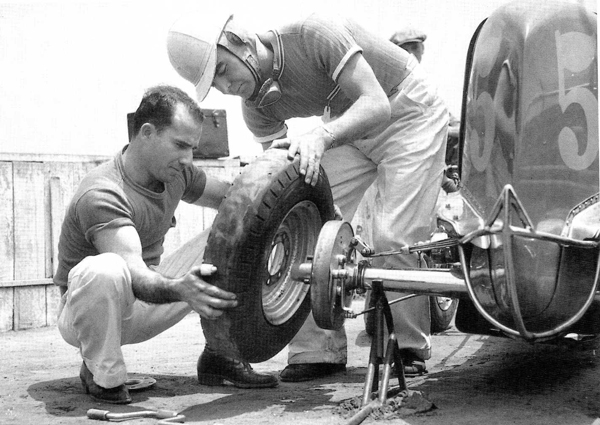 |
|
#1646 - That was West Coast Midgeteer
Danny Oakes working on his left rear in 1940. A
couple of years earlier he had had quite the
incident in Chamberlain, South Dakota. In his
words, he got into “a big hole that a Coca Cola
truck had made while they were wheel-packing
before the race and my car flipped ass-over-tea
kettle onto the main straightaway. It broke the
seat belt and threw me half out of the car, only
my foot was caught under the clutch pedal. I’m
trying to hold on, but I’m out over the back
wheel with one leg past the tail and the other
inside the cockpit, and I’m trying to get hold
of something. The tire knobs are rubbing on me
and I was really getting it. Well, Carl Forberg
has run out of fuel or something, so he ran over
and got hold of the brake handle while the car
was still running and going choke, choke, choke.
When the car goes by him, he makes a leap for
the brake handle and got a hold of it and killed
the engine. He almost killed me, too, because he
landed right on top of me.” From
DISTANT THUNDER: When Midgets Were Mighty,
by Dick Wallen (Jim Chini Collection) |
|
a |
|
 |
|
#1645 - Ultra-popular New
England Hall of Famer George Summers performed
remarkable feats during his long racing career.
None, though, can match one week back in 1956.
He was involved in a horrendous crash at the old
Westboro (MA) Speedway and was really busted up.
He was put into a full body cast, immobilizing
his upper body and left arm to support the
healing. The only problem was that he was being
married the following weekend. This year a 60th
wedding anniversary celebration was held for
George and his bride, Maggie, shown above. In
the background there is a shot from the wedding
showing the couple coming down the aisle,
George’s left arm in stationary position,
pointed to the heavens. In the foreground are
Maggie and George today, wearing the special
jacket his sisters had sewn up to cover the cast
and that arm. George’s comment was, “Man, did
that jacket ever shrink.” (Maggie Summers
Collection) |
|
a |
|
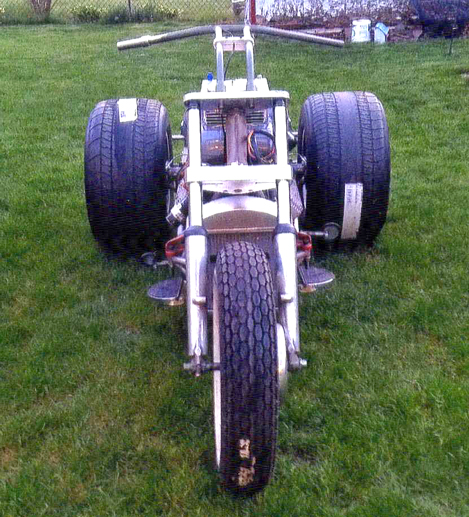 |
 |
|
#1644 - Dan Curley in Marlboro, MA,
just can’t stop building very cool things. A
long-time open-wheel guy who supported the
legendary “Boston Louie” Seymour and his sons in
their racing endeavors, the ever-smiling Dan is
well-known for his incredible talents as an
aluminum shaper. His most recent project has
been this trike. It features a V-8/60 (with a
tin side block) cooled by a brand new Offy
radiator. The power is delivered by a V-8/60
tranny to a Model A rear with Midget brakes. The
front gooseneck is from a Honda. It purrs like a
kitten, and he’s all over town with it. (Photos
Dan Curley Collection) |
|
a |
|
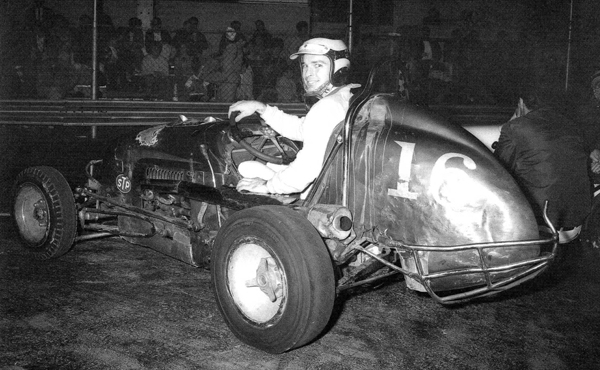 |
|
#1643 - The great American
Sprint Car driver Jan Opperman was originally
from Long Beach, California. He had a fling with
the Midgets early on, and it did not work out
all that well. Here he is getting started
indoors at Oakland in 1967. As you can see, the
panels on Jim Montgomery’s Ford had that used,
beanbag look. Montgomery said that after Jan
there was no piece of straight metal on it. From
INDOORS, Tracks of the West, by Tom
Motter. (Jack Fox Photo) |
|
a |
|
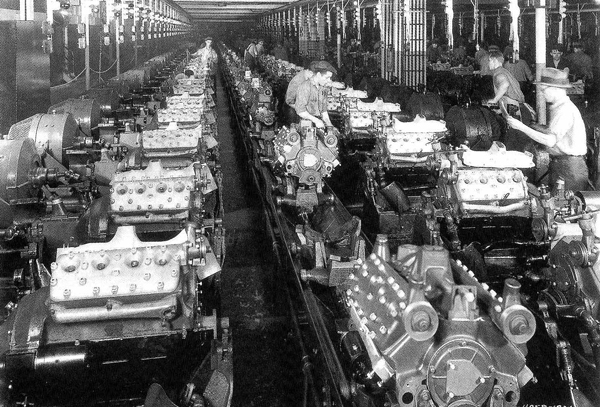 |
|
#1642 - That’s the testing
room of Ford’s River Rouge Plant, southeast of
Detroit, in 1934. How many of those Flatheads
would have made their way into race cars? It
took little time for one to get to Indy. That
same year Chet Miller drove a roadster entered
by Bohn Aluminum and Brass Company, powered by a
Flathead with Bonalite aluminum heads and a Don
Sullivan intake with Stromberg carburetion. It
reached 109.252 miles an hour, but took a detour
over the wall on lap 11. From FLATHEAD FORD
ENGINES, by Tony Thacker and Mike Herman.
(Ford Images Photo) |
|
a |
|
 |
-#1641 - Who would have
known? In the late 1800s a businessman named Cal
Johnson, who was also a former slave, opened a
half-mile dirt oval near Chilhowee Park in
Tennessee. In 1910 he expanded his horizons by
promoting the area’s initial landing of an
airplane. Somewhat later he staged a race
between a Wright Brothers biplane and a car, and
by 1916, race cars had taken over and continued
until the early 1920s. Quite remarkably, the
original configuration of the oval remains
today. Paved, it is called Speedway Circle and
it is bordered by over 50 homes and a church.
From
A HISTORY OF EAST TENNESSEE AUTO RACING: The
Thrill of The Mountains, by David
McGee. (David McGee Photo)
|
|
a |
|
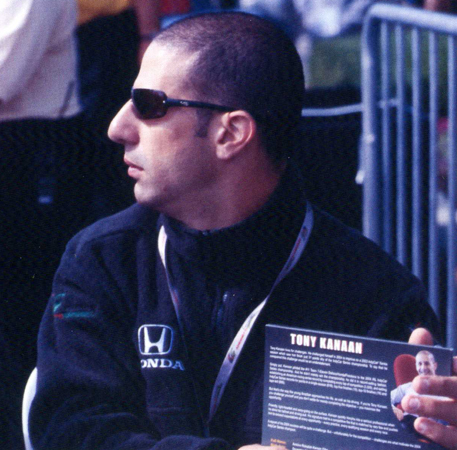 |
|
#1640 - "Kanaan is among the
most popular drivers in the paddock. He’s VERY
proud of his nose. When he finally secured an
Indy victory after about a dozen noble attempts,
he relished the fact that he’d have his image
added to the Borg-Warner trophy. Now, he quips
that he’s anxious to repeat the victory so that
they can add another portrait to the opposite
side and use the ‘noses’ as handles." From
THE RACE: Inside the Indy 500, by James
McGuane. (James McGuane Photo) |
|
a |
|
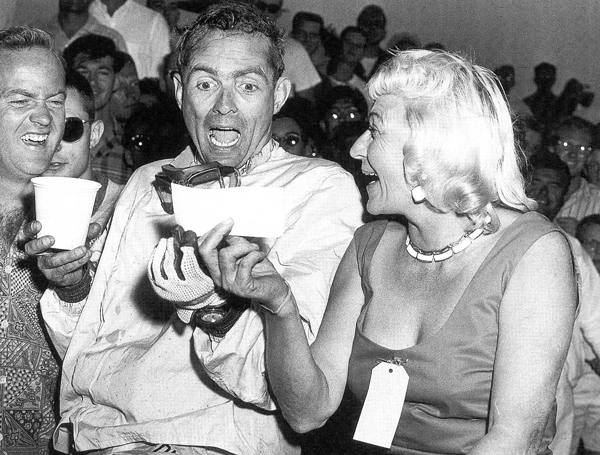 |
|
#1639 - A happy driver at the payoff
window? That was a while ago – October 11, 1959,
when Phil Hill whipped 65 other entries to win
the L.A. Times Grand Prix at
Riverside. His sponsor,
Eleanor von Neuman, also seemed pleased with the
$7500 chunk of the $25,000 purse. From
RIVERSIDE RACEWAY:
Palace of
Speed,
by Dick Wallen. (David Friedman Photo) |
|
A |
|
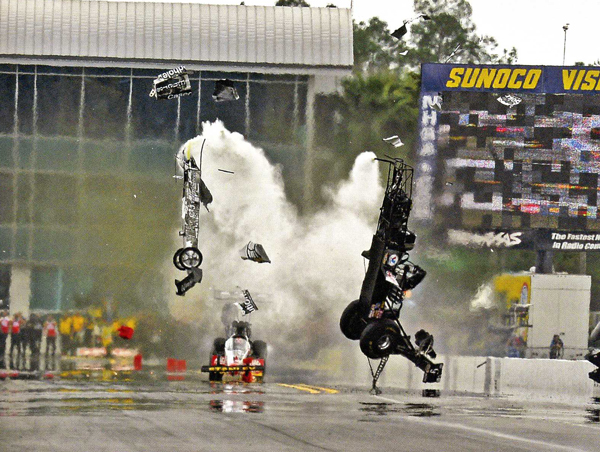 |
|
#1638 - About 900 feet
into his run last year at Gainesville, Florida,
things went awry for Larry Dixon. The chassis of
the Bob Vandergriff’s team Top Fuel Dragster
came apart, and Dixon went aerial. Other than a
banged up knee, he was fine – so much so that he
was racing at Charlotte a couple of weeks later.
From
TOP FUEL DRAGSTERS: Drag Racing’s Rear-Engine
Revolution, by Steve Reyes (Ron Lewis
Photo) |
|
a |
|
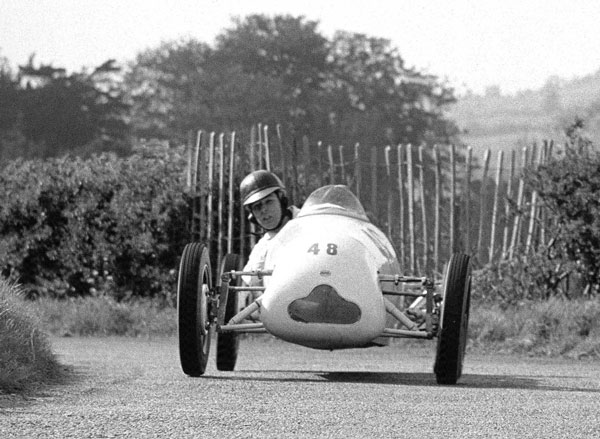 |
|
#1637
- Another
point of view. Stirling Moss, Prescott Hill
Climb, May 9, 1948; Cooper J.A.P. 500 MK II.
(Louis Klemantaski Photo, Coastal 181
Collection) |
|
A |
|
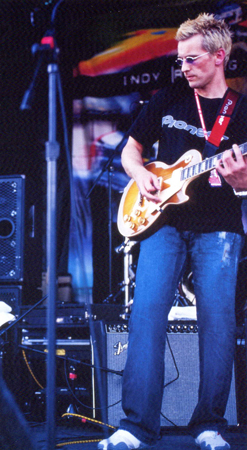 |
|
#1636
-
“(Indy driver) Kenny Brack performs a
high-volume set for the raucous Carb Day fans.
His group is Kenny Brack and the Subwoofers.”
From THE RACE: Inside the Indy 500, by
James McGuane, |
|
A |
|
 |
|
#1635
-
It just has to be one of the oldest oval-track
auto racing photos anywhere. This was time
trials on the 1/3-mile Charles River Park track
right near Harvard University in
Cambridge/Allston, MA. Aboard the Steamer were
the Stanley Brother twins. They will be inducted
into the New England Auto Racing (NEAR) Hall of
Fame in November. (Photo Courtesy Stanley
Museum) |
|
A |
|
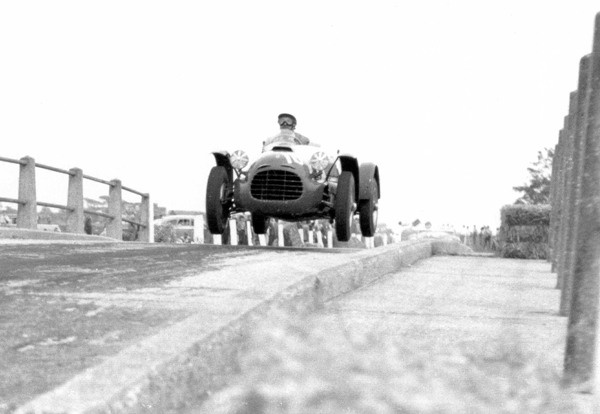 |
|
#1634
-
There was a long tradition of road racing on
Long Island, and post-World War II the action
was in the village of Bridgehampton. Many of the
competitors were gentlemen racers, and Briggs
Cunningham, shown here, was surely among their
number. He was on the gas. Here he’s up on the
wheel and airborne in a Ferrari 1661 motoring
over Sand Pond Bridge. From BRIDGEHAMPTON:
Bridgehampton Racing - From the Streets to the
Bridge, by Joel E. Finn (Dan Rubin Photo) |
|
A |
|
 |
|
#1633
- Auto
racing has always been dangerous business but in
the late 1970s it was especially so. Van May
flipped at Syracuse and as the car rolled, the
cage broke apart leaving a surprised driver
sitting uninjured in his seat. The fuel tank and
other components also left what had been May's
car. The accident was eerily similar to the
crash that took Dick Tobias's life at
Flemington. Doug Gore and French Grimes went to
work to find out why steel was shattering rather
than bending in wrecks. They discovered that
there were two types of chrome moly tubing,
Condition-N (normalized) and non-normalized. If
chrome moly isn't normalized, a process in which
heat is slowly removed when the tubing is
manufactured, the moly is brittle. The cages
that broke up weren't Condition-N. (Photo and
Caption from Dick Berggren, North East Motor
Sports Museum) |
|
A |
|
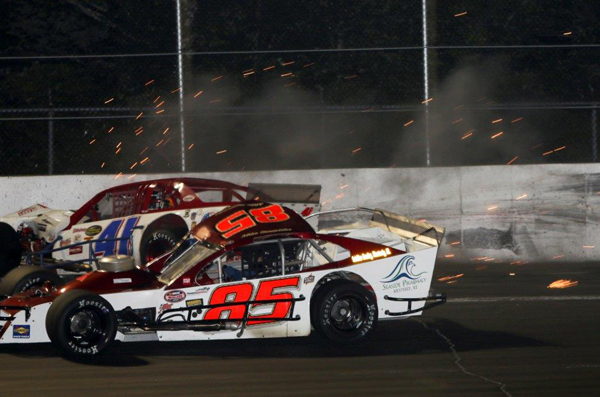 |
|
#1632
- The
wreck of the old #41, one of Coastal 181's
favorite asphalt Modifieds, first built 26
winters back. The ever-active Karl Fredrickson,
owner/publisher of Speedway Illustrated
magazine, blasted the fence at New London, CT, a
week or two back. It was one of those vicious
ones when you crash while your wheels are still
in the air. But Karl practices what he preaches
in his magazine. The 41 may be done, but Karl
had all the safety kit he and his staff
recommend. His backside was a little sore and
his left hand was puffed up, but he was back in
New Hampshire on his keyboard the next morning
banging out a new story. (Speedway
Illustrated Collection) |
|
a |
|
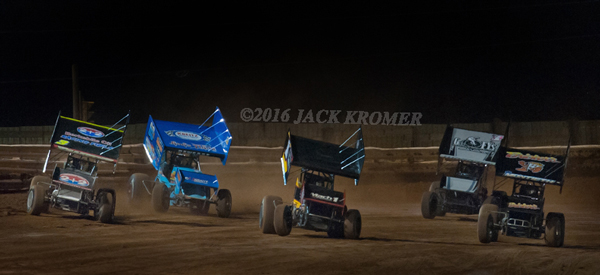 |
|
#1631
- We
really love this image. Its photographer, Jack
Kromer, has this to say about it: “The start of
heat race action at Williams Grove with Brock
Zearfoss pushing in the loose stuff, Lance
Dewease hanging it out, Eric Tomecek running a
little loose, and Tim Wagaman and Brian Montieth
hitting it straight.” |
|
a |
|
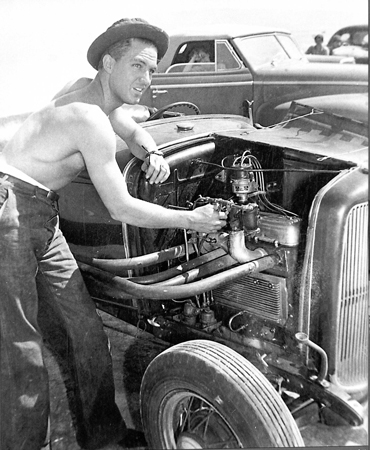 |
|
#1630
- The way it
was – and the way it still is. That’s actor
Robert Stack (of the “Untouchables” on TV),
seriously back in the day, tuning the twin
Winfields on the Cragar head in his Model A.
Check out his girl in the convertible wondering
just how long this hot rod stuff is gonna last.
From Hot Rod
Gallery II, by Pat Ganahl. (Eldon
Snapp Photo) |
|
a |
|
Olson11VoglerSfield082387s50cor_JM.jpg) |
|
#1629
-
From our observation point, it has always seemed
that Midgets on a mile are about as hairy as
racing can be. This shot is from our forthcoming
book (available this fall) on the rather
outrageous Kevin Olson, (aka KO), called
CAGES ARE FOR MONKEYS. He is shown leading
two of his buddies in USAC cars on the dirt of
the Springfield mile back in 1987. He agrees
with our assessment. “You put in a very high
gear for those big, fast tracks like Springfield
and Phoenix, so it takes a while to get up to
speed. But do you ever! At well over 100 mph you
feel the wind pressing your helmet back. And
back then there were no containment seats, so
you were flopping around inside the car. Add
huge G-forces and dirt flying all around, and
you know you are going really fast. You can’t do
anything drastic because the result will be
certain disaster. But it’s always a balancing
act. When three guys like Vogler, Wente, and I
are racing, some of the caution goes out the
window. You go for it.” From CAGES ARE FOR
MONKEYS, by Kevin Olson. (John Mahoney
Photo) |
|
A |
|
 |
|
#1628
-
There was something predictive about that look
in the eye and the racy stance of Art Arfons on
his Indian in the ‘40s, long before his land
speed record runs in the Green Monster. His
sister, Lou, looked racy too. From
SPEED DUEL: The Inside Story of the Land Speed
Record in the Sixties, by Samuel
Hawley. (Tom Joswick Photo) |
|
a |
|
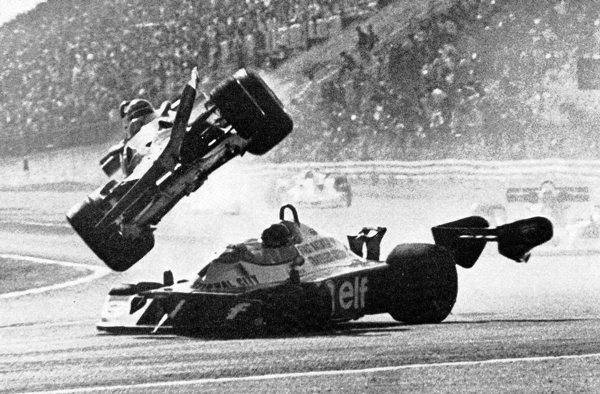 |
|
#1627
-
It happened at the right-hand turn at the end of
the main straight at the Japanese Grand Prix in
1977. Gilles Villeneuve chased the brake pedal
all the way to the floor, as he tried to slow to
avoid hitting Ronnie Peterson’s Tyrrell. He ran
over Peterson’s rear wheel, breaking off his
wing. Villeneuve cartwheeled high in the air and
into an area prohibited for spectators. A
marshal was there, trying to usher eager fans
away, but it was too late. Villeneuve climbed
out of his monocoque/engine unit unhurt, but the
marshal and a spectator were killed and seven
others injured. From AUTOCOURSE 1978-79,
Edited by Mike Kettlewell. |
|
a |
|
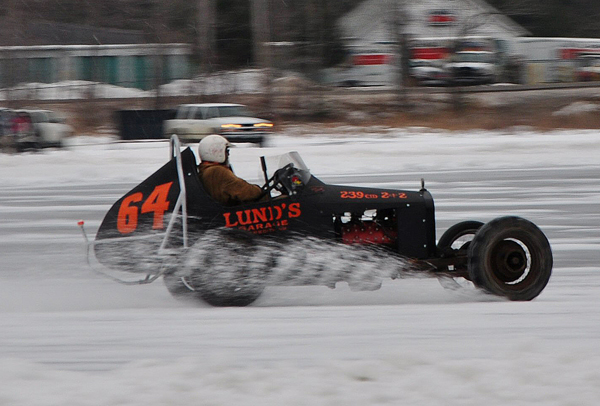 |
|
#1626
-
Here's a note from a reader, Larry Moore, about
our Photo of the Day from last Friday (#1625).
"Thought you might like to see a photo of Dave
Bennett's car at speed at Berry Pond
(Moultonborough, NH) in 2010. The car really
does run!" (Larry Moore Photo) |
|
a |
|
 |
|
#1625
- It
may cause me to be arrested, but I think this
was the neatest front end on all the cars
Thursday at New Hampshire Motor Speedway's
vintage celebration -- and there was a whole
bunch of some classically beautiful
open-wheelers and stock cars to consider. It has
always seemed to me that "suicide front ends"
were a defining moment in the progression from
jalopies to race cars. The motor could go back,
and the frame could go down. This setup is from
an ice racer built by Dave Bennett in Meredith,
New Hampshire, from pieces and parts "lyin'
around the barnyard." The spring perch and
spring are from a Model T. The perch is welded
in tipped back, allowing some pretty substantial
caster on the axle. That may be the hot setup on
the ice, but, in any case, it is way cool.
(Coastal 181 Photo) |
|
a |
|
 |
|
#1624
- So
why the tear in the eye? Greg Weld had just won
the 1967 USAC Sprint Car title for Dr. Ward
Dunseth and Paul Leffler. He had a particularly
sensational middle of the season and had racked
up eight victories. Besides, she was so pretty.
From
UNITED STATES AUTO CLUB: Fifty Years of Speed
and Glory, by Dick Wallen. (Dick Wallen
Collection) |
|
A |
|
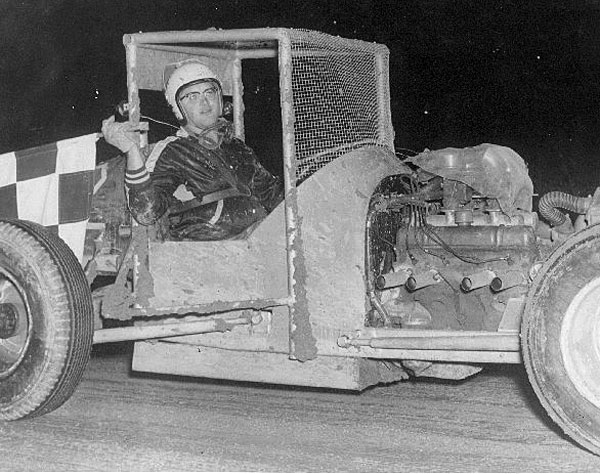 |
|
#1623
- Mike Clark
(or “Old Man Clark” as he was known more
recently in Allegany, NY) was a fun-loving guy
with a life motto of “Don’t sweat the small
stuff.” He was a passionate racer in the ’50s
and ’60s at area tracks such as Olean – and what
a cool time it was. Check him out in his
cutdown: Open helmet, Sam Brown belt, a cage not
even legal for a wheel chair, and an OHV Buick
with advanced filtration. Another neat photo
from Ford Easton. |
|
A |
|
 |
|
#1622
- Here’s “Jean,” the youngest of the
Coastal 181 race cars, all loaded up to support
Thursday and Friday’s Vintage Celebration at the
New Hampshire Motor Speedway. Unfortunately, she
is likely to get more time on the trailer than
on the track when we get to Loudon. Our driver
at vintage events, New York’s Kenn VanWert,
suffered serious abdominal injuries when an air
compressor let go a month ago. He had a great
surgeon and will recover fully, but, given his
huge new zipper, he understandably is not into
taut seat belts and harnesses just now. (Coastal
181 Photo) |
|
A |
|
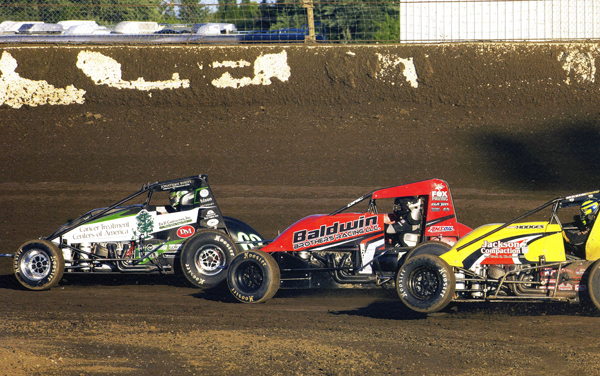 |
|
#1621
-
It was such a beautiful thing for American
racing. After running the Indy 500 and actually
leading a lap, the late Bryan Clauson whisked
over to Kokomo Speedway for the evening's Sprint
Car show. Here he has just taken the lead in the
heat over Chris Windom and Josh Hodges. He
motored on to win the main. From
PAUL OXMAN SPRINT RACING 2017 CALENDAR
- Tim Aylwin Photo |
|
a |
|
 |
|
#1620
-
Richie Evans and Johnny Rutherford,
Martinsville, Virginia, 1978. It was an
interview between two worlds, awash with mutual
respect. Both were inducted into the Talladega’s
International Motorsports Hall of Fame in 1996.
From
RICHIE!: The Fast Life and Times of NASCAR’S
Greatest Modified Driver, by Bones
Bourcier. (Balser Photo) |
|
a |
|
 |
|
#1619
-
That's the late master racer Ollie Silva and
master builder Vic Miller, kings of
Supermodified racing in New England's Merrimack
Valley. Vic says, "That was fun, back in the
1970s era. That little car was so simple. There
was nothing to it -- just a single line running
to the injection, one return line, and the pill.
Now we're here thrashing on a new Super every
night, trying to get ready for a show at Oswego.
You should see it. It is so complicated. It
seems the injection has eight lines coming and
eight lines going. There are Ts and by-passes
everywhere!" (RA Silvia Collection) |
|
a |
|
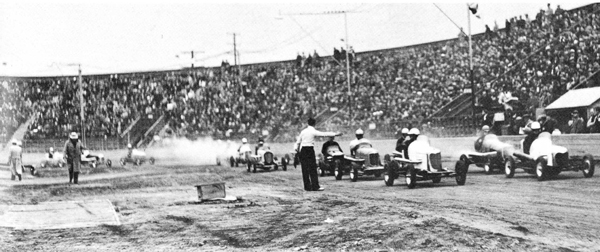 |
#1618
- It
was the parade lap on January 24, 1936 at
Atlantic Speedway, East Los Angeles. Nope, the
picture isn’t backwards. It was a Figure 8 race
for Midgets. The promoter, Dave Koetzla, had
laid out the 3/8-mile dirt course inside the
regularly used D-shaped track for the event.
Making the whole thing even more unusual was
that a bridge and a tunnel were installed at the
“X”, so the cars would be separated aerially.
The infamous, rough and tumble ex-boxer Peewee
Distarce won the race, but he wove around a bit
with dizziness when receiving the trophy. From
THE MIGHTY MIDGETS, by Jack C, Fox.
(Craig-Alvarez Collection)
|
|
a |
|
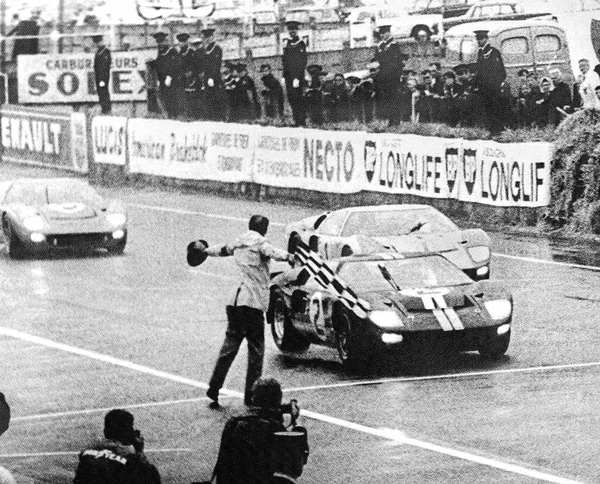 |
|
#1617
- In the
early 1960s there was some talk between Henry
Ford II and Enzo Ferrari about Ford taking over
Ferrari. It appears, though, that by 1966 Ford
had little reason to continue the negotiations.
This was the rainy finish of Le Mans that year.
Ford GT40s are shown above sweeping the top
three positions. The first two were out of the
Shelby shop while the third came from Holman
Moody. So, Henry was on the podium, and Enzo was
on his way home. Photo from
FORD TOTAL PERFORMANCE: Ford’s Legendary
High-Performance Street and Race Cars,
by Martyn L. Schorr. (Ford Motor Company
Collection) |
|
a |
|
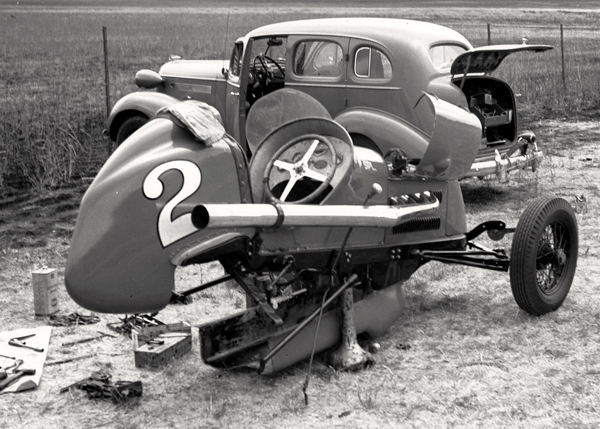 |
|
#1616
- Here’s a photo from our buddy Dale
Snyder’s collection. And here’s his reaction to
it: “I don’t see much difference between this
pit area (Oakland, CA, in 1940) and the pit area
of today’s NASCAR and Indy Car teams….can you?” |
|
A |
|
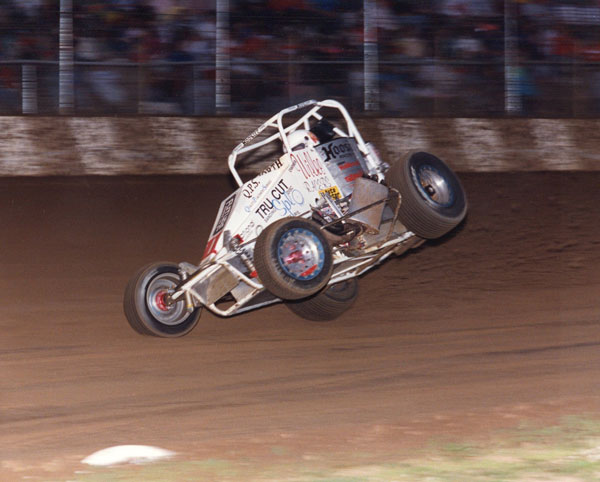 |
|
#1615
- We are
full throttle on our Kevin Olson book, which
will be out this fall. Here he is bicycling at
Sun Prairie in a Wilke Midget. Wouldn’t it be
cool if we could say that he pulled it out and
won the feature? He didn’t; he went over the
fence. (Mark Wilke Collection) |
|
a |
|
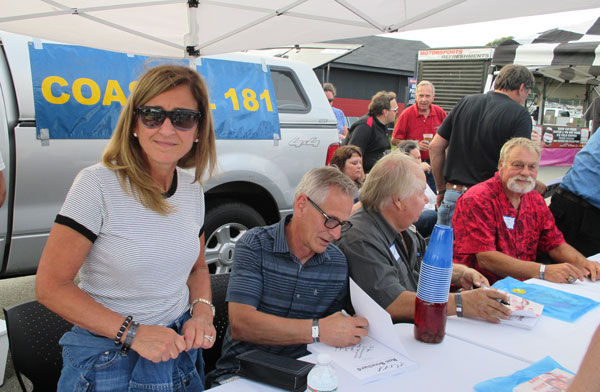 |
|
#1614
- A moment from the launch of Bones Bourcier
and Coastal 181’s latest book,
RON BOUCHARD: Remembering the Kid from Fitchburg,
last night at Thompson Speedway. Signing the
book in this shot are Paula Flemke Bouchard; Ed
Flemke Jr.; Vic Kangas, former NASCAR crew chief
and Ronnie’s early chassis man; and Steve Bird,
part of Ronnie’s Winston Cup team and later a
four-time championship crew chief in the Busch
Series. Many others involved in the book
participated in the signing, and it was a warm
gathering of old friends and Bouchard fans. |
|
A |
|
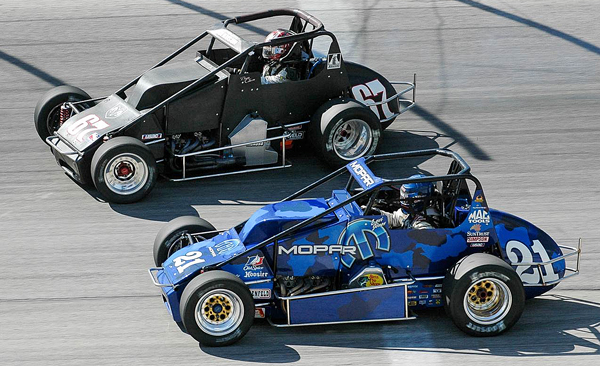 |
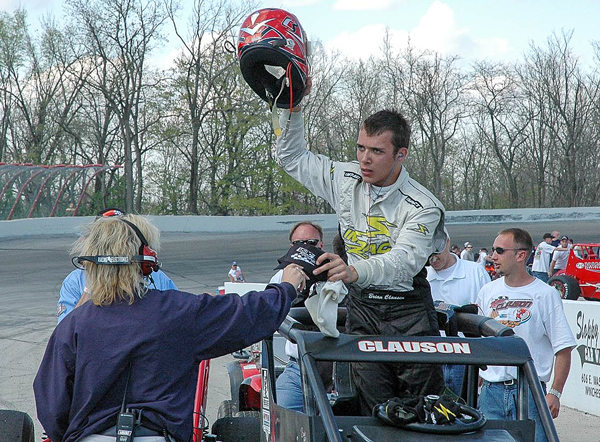 |
#1613
-
Everyone in the racing world is
devastated at the loss of Bryan Clauson. Ace
photographer John DaDalt contributed the two
photos above with the following thoughts:
“In April of 2006 I had the pleasure of
watching BC’s first USAC Sprint Car win at
Winchester of all places. Not yet 17 years old
and he’s got the back end hung out like a
dirt-tracker racing Levi Jones. That’s how I’ll
remember him.” |
|
A |
|
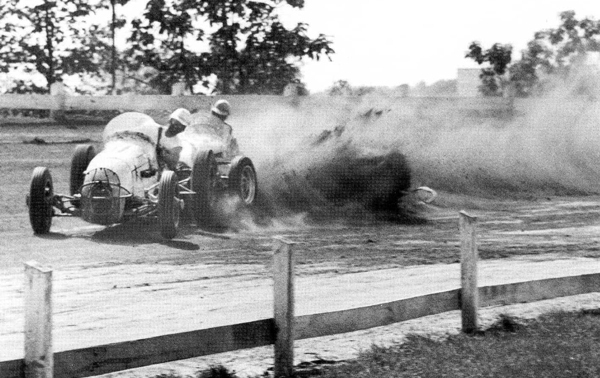 |
|
#1612
-
It could probably be said that not
too many strokers have turned laps at Williams
Grove Speedway since its inaugural show in May
of 1939. In August 1955 the big boys were in
town, and they played hardball just like the
locals. Here Elmer George has gotten into the
turn just a tad hot – and then into Mike Magill.
Magill leans to the left, likely a reaction to
the hit. That’s his rear bumper in the dust
trail behind George. From THE EASTERN BULL
RINGS, by Buzz Rose. (Dave Knox Photo) |
|
A |
|
 |
|
#1611
-
There was a frightful accident 66
years ago (August 9, 1940) in Franklin, Indiana.
The CSRA open wheelmen Ray Tellis and Eddie
Zalucki tangled entering the first turn. Zalucki
flipped and tore through a wooden fence and into
the crowd. He ended up hanging in the car with a
broken arm, surrounded by 14 injured spectators.
It was worse on the track. Tellis had come to a
stop in the groove and was blasted by Jim
Sampson who rode right over the top of him,
shearing the tail right off the car. Tellis was
killed. Zalucki’s car is shown during the
cleanup process. From
THE RIM RIDERS: The World’s Fastest Racing
Circuit, by Buzz Rose (Jim Graybeal
Collection) |
|
A |
|
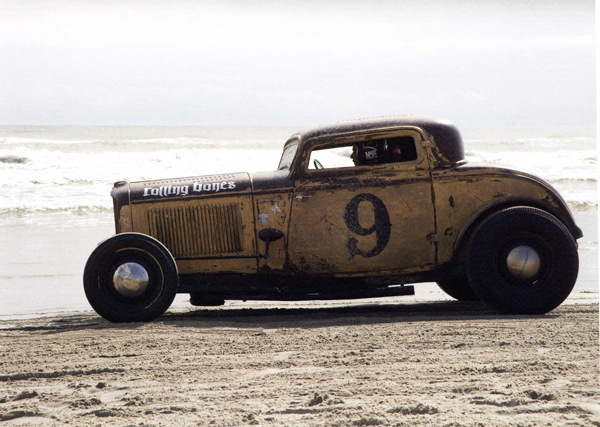 |
|
#1610
- This is the much
discussed Race of Gentlemen in Wildwood,
New Jersey. The image
comes from a recently published book by Peter
Vincent about the work of the Rolling Bones Hot
Rod Shop near Saratoga
Springs in upstate
New York. The builders
are Keith Cornell, Matt Schmidt, and Ken
Schmidt, and they have become cult heroes. The
book contains a couple hundred pages of glorious
photography from all over the country of
traditional old-time American hot rods and the
culture that surrounds them. From
ROLLING BONES, by Peter Vincent.
|
|
a |
|
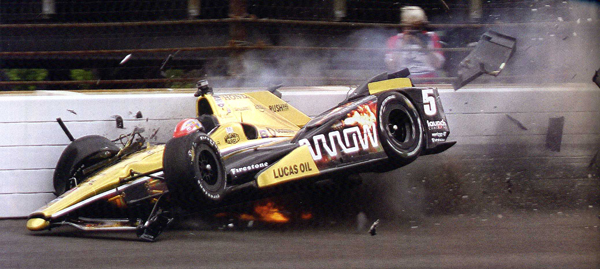 |
|
#1609
- “James
Hinchcliffe recalls what he can about what
happened practicing for the 99th Indy 500 on May
18th a year ago. ‘I remember the start of the
day, waking up. I remember getting into the car
and getting the program going. I remember
running behind Juan Pablo Montoya the lap before
my crash, and then the start of that lap is when
I lose everything else. The next thing I know
I’m under bright lights in the hospital with a
tube down my throat. People standing around me
with tears in their eyes. That is when I figured
out that something happened and it probably
wasn’t a great thing.’ It wasn’t, but it didn’t
stop him from grabbing the pole and running
seventh this year. (Photo and Quote from May 29,
2016 INDY 500 Program, Presented by PennGrade) |
|
A |
|
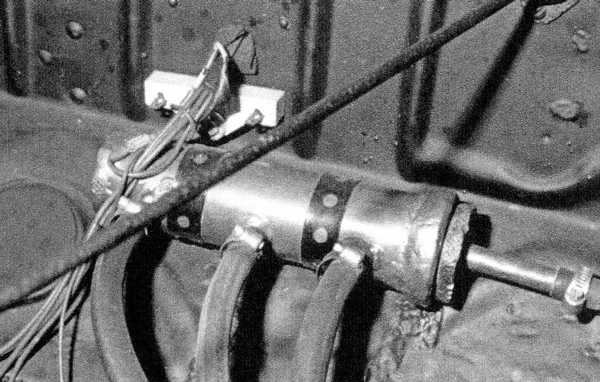 |
|
#1608
- Gober
Sosebee of Dawson County, Georgia, was a Grand
National driver who actually had more success
hustling around in the Sportsman and Modified
coupes. He came to the 1950 Daytona Beach Race
with his #50 Cherokee Garage ‘39 Ford Standard
coupe. It may have looked ordinary, but hardly
anything was original. Case in point was the
cool copper fuel log he fabricated and bolted to
the firewall. He had experienced some starvation
under load with the three two-barrel carburetors
on his flathead, and this unit, complete with an
internal screen, did the trick. He won. He ran
the car until 1954 then parked it until 1987
when he, his sons, and Dawsonville friends
restored it to its current condition. The clever
Goober himself died in a farming accident in
1996. From WE’D RACE ANYWHERE, by Russ
Hamilton. |
|
A |
|
 |
|
#1607 - For a little
while in the early 1970s there was a wedge
fascination among some of the Top Fueler crowd.
Chris “the Greek” Karamesines gave one a try in
1971, but it didn’t seem to do anything more for
him than it had for others. He didn’t have to
mess around with it for too long, however. One
day in Fremont, Ohio, Jim Nicoll, driving the
Greek’s push truck, broke a push bar and he
launched right over the top of the car. Chris
was unscathed, but, as for the car – that was
the name of that tune. From
1001 DRAG RACING FACTS, by Doug Boyce.
(Courtesy James Hardy) |
|
A |
|
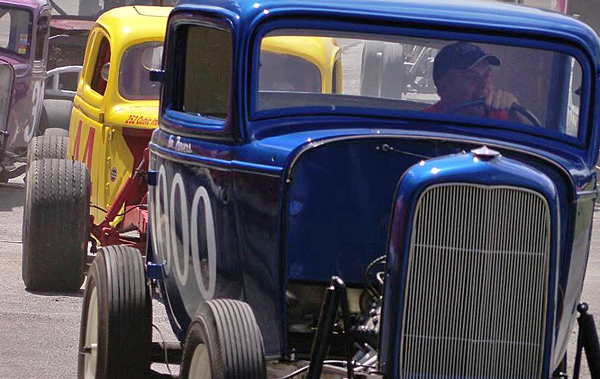 |
|
#1606
- That's the
Howard Townes restored #000 flathead-powered
square top at the recent reunion at the old
Northeastern Speedway in West Waterford,
Vermont. Hall of Famer Marty Harty built the car
for Jimmy Travers, and it was a winner. It
purred with really perfect pitch, though, when
another Hall of Famer, Freddie Borden showed up
to chauffeur it. That happened on Memorial Day
of 1960 when Jim decided to go to Indy. Freddie
jumped in and quickly assumed the lead in the
special holiday event on the 1/5 mile Brookline
(NH) Speedway. His lead did diminish as the laps
went by, but he snuck out the win. Borden was
approached by the rather excited and
self-absorbed second place finisher. He warned
that in a more couple of laps he would have been
passed and, if he came back again, he should not
expect to be up front. Freddie smiled with
feigned agreement. Only he and Marty knew that,
once out front, Freddie dropped it into third
gear and purred around to make it look like a
closer race. (Photo Ace Kolar Collection) |
|
A |
|
 |
#1605
- The late,
great Dick Trickle raced just about everywhere.
Here he’s shown at New Smyrna, Florida, in a
Northeastern pavement Modified owned by the
popular Joe Brady, who passed away last fall.
The car survives, however, dutifully cared for
by Mark Alden in Framingham, Mass. Father Dale
Grubba is currently writing a book on Trickle
and Tom Refner, who both had extraordinary
seasons in which they won 76 races. (Coastal 181
Collection)
|
|
a |
|
.jpg) |
|
#1604
- One thousand, two hundred
and ninety-five Photos of the Day ago, back at
#307, we posted an image of Felicia Williamson
texting inside her dad's Sprinter in the pits at
Delaware Speedway in 2011. It didn't bother
Kramer. He went out and won anyway. Two seasons
later, however, he perished in a crash at
Lincoln (PA)
Speedway. This year when
URC's memorial event, the Kramer Cup, was run at
Selinsgrove,
PA, Felicia was back in the car.
She paced the field, looking like a pro. Our
friend Chad Culver is working on a Kramer
Williamson book, and we can't wait. (Photo by
"the Guy with the Hat", Frank Simek) |
|
A |
|
 |
|
#1603
- Another quote from Art
Garner’s new
INDY
MEMORIES book. You gotta love
racing people, especially Linda Vaughn: “A. J.
and I have always had this thing for each
other. He’s cantankerous as hell. He walked up
to me at the starting line one year, one year
when I was really skinny, and he said, ‘Wow,
Linda, you have a case of no ass.’ I said
‘Yeah, A. J., and you found it. It’s on your
belly.’ After that he said ‘ I’m gonna leave
you alone. I know better.’ But he’s a great
man.” (Billy Harman Photo, Coastal 181
Collection) |
|
A |
|
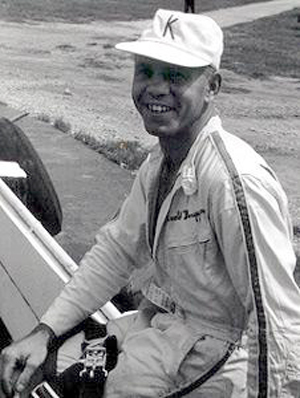 |
|
#1602
- "Qualifying in 1968 was
plagued by rain, and it was well after 6 p.m. on
Monday (yes Monday) when my dad, Arnie Knepper,
finally qualified Rolla Vollstedt’s car. It was
an evil handling car, but he put it in the race
in 32nd spot. There was hardly a soul in the
place at the time, except officials and crew
members. When they interviewed dad after his
run, he said, “I’m tired, hungry and I’m broke,
and I have to go to the bathroom." Quote from
Art Garner’s great new book
INDY 500 MEMORIES: An Oral History of "The
Greatest Spectacle In Racing." (Photo:
www.FindaGrave.com) |
|
A |
|
 |
#1601
- Please, Is there just one
short track anywhere that does not run
cookie-cutter cars these days? Sunshine Speedway
in Pinellas Park, FL, sure had sweetness of all
flavors when they ran the Supers back in the
1970s. (Cal Lane Collection )
|
|
A |
|
 |
|
#1600
- What a place Ascot Park
was, out there in Gardena, California. A night
at the races was an affirmation of the greatness
of short-track open-wheel racing. If you sat in
the first turn as the Sprinters backed it in,
pounding the cushion, you’d be bombarded by
flying balls of clay – and you needed to be wary
of the occasional flying car. In this shot Tony
Hunt (#95) hit Mike Sweeney off turn four and
was launched some 25 feet in the air. He went
end over end and then rolled side to side,
landing on his wheels near the starting line,
engine still running. No one was injured, though
Hunt understandably reported some sore and
stretched muscles. (Dean Leeds Photo, Cal Lane
Collection) |
|
A |
|
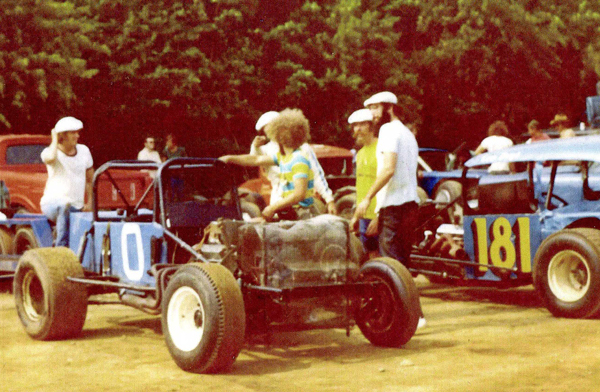 |
|
#1599
- Who do the caps on those
disreputable guys remind you of? You got it!
That’s Dick Berggren ("Doctor Dirt") next to the
back bumper giving highly knowledgeable
instruction to his pit crew. It was in 1970 or
so, back at the old Lakeville Speedway near
Providence, Rhode Island. His #0 was quite the
unit – a renegade from Oscar Ridlon’s URDC group
that eventually led to the New England Super
Modified Association (NESMRA). They actually won
with it. (Coastal 181 Collection) |
|
A |
|
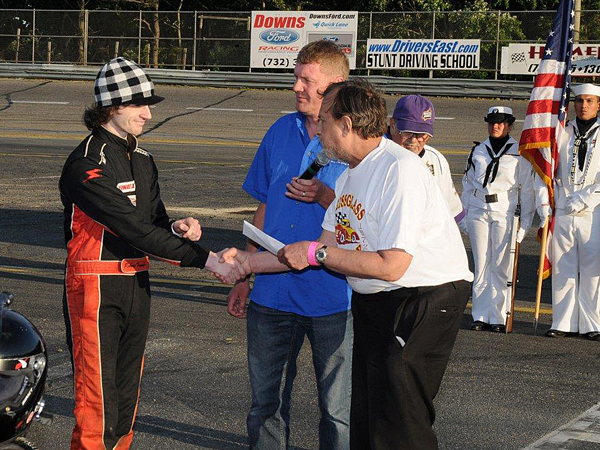 |
#1598 - Our world of
racing sure has its characters, but the one
standing to the right in the photo above is
world class. That's Gary Heiderich of Sunnyside
(Queens), New York. Gary is one of the few
native English-speaking cab drivers in NYC, but
more famously he is known as "Jalopy Jack." He
runs a racing call-in hot line at 212-707-1150.
Check it out. Here Gary was presenting a check
from one of his grand slam contests to Legends
driver Robert French at New Jersey's Wall
Stadium, as announcer Gary Larsen looks on. (Jim
Smith Photo)
|
|
A |
|
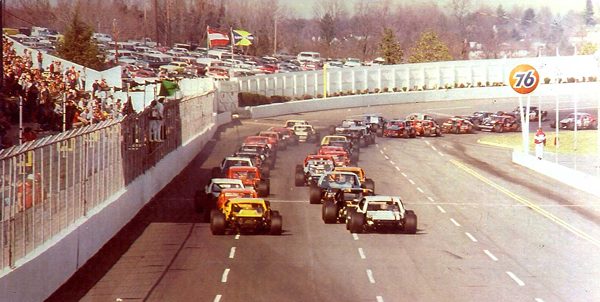 |
|
#1597 - Here’s a shot
reminiscent of that glorious period when the
asphalt Modifieds traveled the Eastern Seaboard.
It’s the Modified portion of the Dogwood 500 at
Martinsville, VA, in March of 1979. That’s
George Kent in the Carl Smales #41; the Rapid
Roman on the outside; and Ronnie Bouchard in
third. Kent won it while Evans was fourth, and
Bouchard ended up on the trailer. The image was
taken by old-time New England Modified shoe Mike
McClelland, now settled in West Palm Beach.
(Mike McClelland Photo) |
|
A |
|
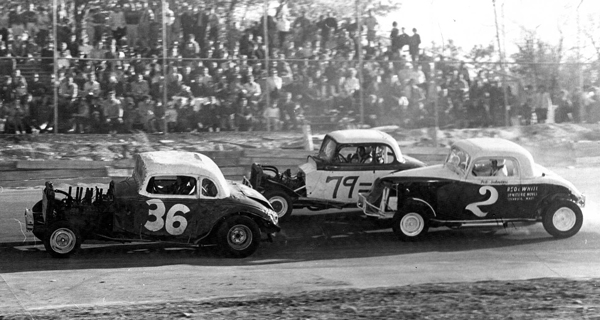 |
|
#1596 - Grand old
autumn days in New England. On October 24, 1962
the Atlantic Auto Racing Association hosted an
afternoon show at the Brookline Speedway, just
over the New Hampshire line from Townsend,
Massachusetts. AARN was trying to control costs
by still allowing only single-carb flatheads and
six cylinders in the engine compartment. It was
pretty racy stuff, though, and here were some of
the best, all feature winners. It was Carl
Valenti in the #36, a former Non Ford car, New
Hampshire’s country band performer Lucky
Thompson in the #79, and Pete “The All American
Boy” and future mentor to Ron Bouchard in the
Red & White three window. (Bill Balser Photo,
Cathy and Don Donahue Collection) |
|
A |
|
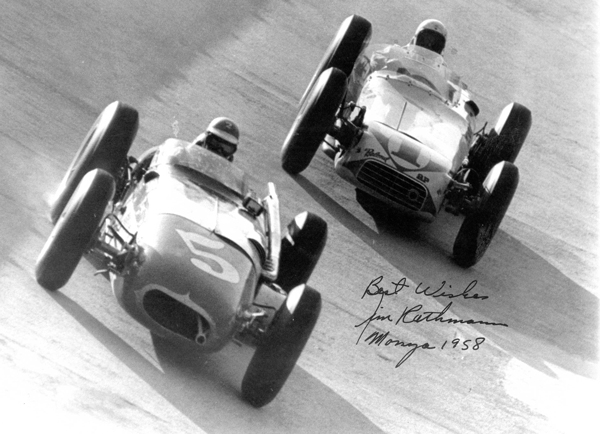 |
|
#1595 - Jim Rathmann,
leading above, won all three portions of the
1958 500 Miles of Monza in Italy. Jimmy Bryan,
following Rathmann, was second in the tally. The
“Race of Two Worlds” pitted USAC Champ Car teams
against the Formula 1 guys. Newcomer A.J. Foyt,
fresh from a run at Indianapolis, said, “At
Monza there is more sensation of speed. For one
thing, we were going past Europeans about like
you pass slower cars on an Interstate.” It was
the fastest recorded race in history with a
166.705 mph average. The fastest European to
finish was Stirling Moss who managed fourth
place in a Maserati in the second segment. It
would sure seem that by a decade later the
Europeans had avenged themselves fully at
Indianapolis with the rear-engine revolution.
Photo and quote from
RAY CRAWFORD: Speed Merchant, by Andrew
Layton. (Dick Wallen Collection) |
|
A |
|
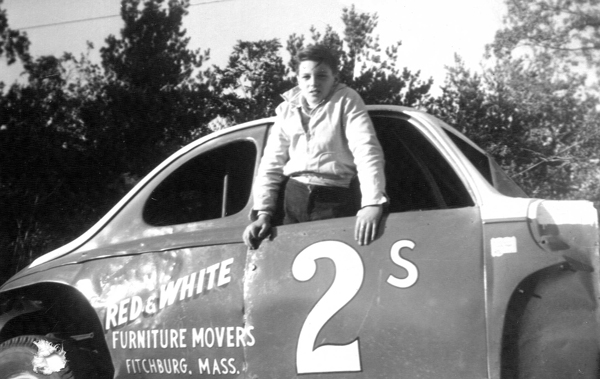 |
|
#1594 - That’s the
late Ronnie Bouchard, age 12, testing his fit in
one of his dad’s coupes in 1960. Five years
later it was no longer pretend. He was winning
in Supermodifieds on his way to 100s of
short-track wins. Sixteen years later in 1981 he
was winner of the dramatic August Talladega race
and Winston Cup Rookie of the year. The sky
cried when he died last December of cancer. With
Ronnie’s close friend Bones Bourcier, we will be
launching his
biography at the August 10 Modified event at
Thompson, CT, Speedway. (Bouchard Family Photo) |
|
a |
|
 |
|
#1593 - That's the
great Arnie Knepper in full concentration in a
Vatis roadster at Phoenix in the Fall of 1964.
His rides to date had been dirt cars, and his
widow, Wanda, says he was absolutely thrilled to
finally be in a pavement car. He drove it at the
Brickyard the next spring, running well until a
cylinder let go. Arnie died of cancer in 1992,
and his 25th memorial race for Midgets will be
run this Friday night at the ultra-racy
Belle-Clair Speedway in Belleville, Illinois.
Amazingly it has been won by his nephew, Steve
Knepper, six times to date. Wanda is a beloved
part of Coastal 181, helping run our booth
annually at the Chili Bowl with a gracious grin
and an iron hand. (Knepper Family Collection) |
|
A |
|
 |
|
#1592 - Rex Mays (far
right) and his associate Pete Clark (left in
apron) pose with the Kurtis Kraft team preparing
their Indy car for 1947 at the Brickyard.
Despite the success of tube-frame Midgets (note
the Midget tails in the background), they
elected to go with a rail chassis outfitted with
a straight eight. Rex, a two-time AAA champion,
qualified 20th at 124,412 and hustled to a
sixth-place finish. He died in November 1949,
after being thrown from a Champ Car at Del Mar,
California. From
POLE POSITION: Rex Mays, by Bob
Schilling. (Mays Family Collection) |
|
a |
|
 |
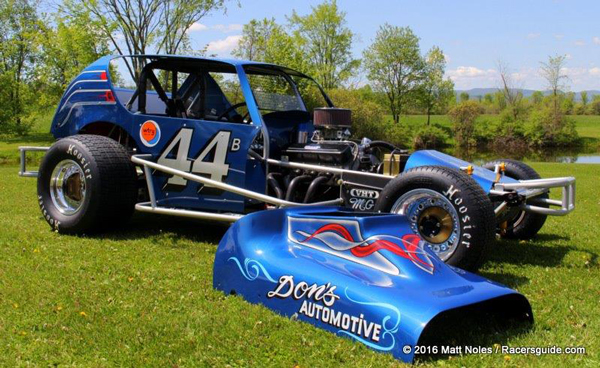 |
#1591 - Recently
retired Northeastern Modified stalwart Dave Lape
was noted for building and maintaining his own
cars for the vast majority of his long career.
And he did it with an enormous tub of elbow
grease rather than a string of financial sugar
daddies. Somewhat unusually, he did pick up one
of “Toby’s Tubes” chassis in the ’70s, a
four-bar chassis kit from Dick Tobias in
Lebanon, PA. Numbered the #44b, it turned out to
be a widely feared rocket ship, so much faster
than all the others that Tobias came to take a
look. Seems that the “secret” was that Lape had
mistakenly put the bars in backwards – and it
worked! The car ended up being sold and wheeled
by a number of others, including Jan Opperman.
Lape heard recently that the car had been
spotted near Middletown, NY, and he went to pick
it up. A sorry sight it was. Lape went to work
in his efficiently careful way and spent 745
hours on the project. When done, he brought it
to Fonda Speedway on June 25 for a Dave Lape
Celebration night. It was drop-dead beautiful.
(Top Photo – Dave Lape Collection; Bottom Photo
– Matt Noles)
|
|
a |
|
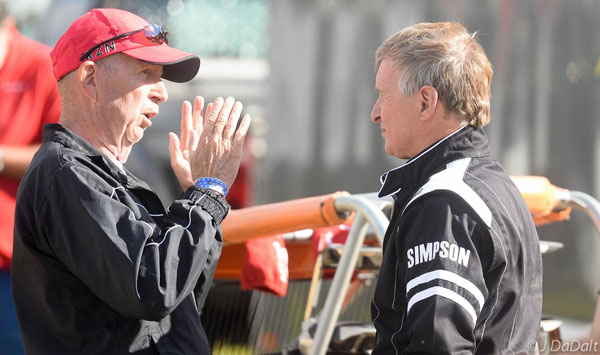 |
|
#1590 - Sit back for
a minute and contemplate just how many laps
these veteran open-wheelers have cut over the
seasons. On the left that's Indy 500 Rookie of
the Year Denny Zimmerman, and to the right
Johnny "Hot Rod" Heydenreich, Chili Bowl
Champion. Where are they found on a Saturday
night in June? On top of the Green Mountains of
Vermont of course, grooving on a feisty little
track called Bear Ridge Speedway. (John DaDalt
Photo) |
|
a |
|
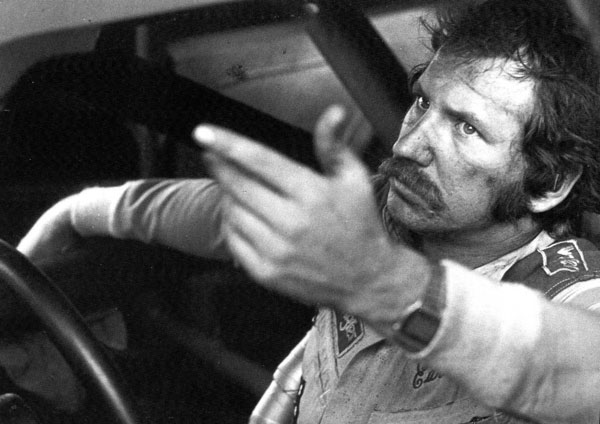 |
|
#1589 - Speaking of
what happened when he came upon a slower Greg
Sacks at a World 600, Dale Earnhardt said, "It
was close, but I didn't hit him. Maybe our
bumpers touched or I touched him a bit but it
wasn't like I rammed the hell out of him. I
don't think I nudged him." (And, then, with a
smile) "I might've been a-gin him." Sacks did a
samba, going into the wall, across the track,
and into the grass. Photo and quote from THE
PASS IN THE GRASS: and Other Incredible Moments
from Racing's Greatest Legend, edited by
Joseph J. Bannon, Jr. (Mark B. Sluder Photo) |
|
A |
|
 |
|
#1588 - When this photo of Dave
Buanno winning a qualifier at Fonda (NY)
Speedway on Memorial Day 1970 was taken, he was
one busy guy. As well as campaigning his own
Modified, he was working for the family business
and tending to the new property he had obtained
in the fields above the Mohawk Canal in
Amsterdam, NY. He carefully planted evergreens
all around the house. They are now enormous and
have come to serve him well. Three years back,
in August 2013, Dave went to Fonda to visit with
old buddies. Out of the blue, a wheel and tire
dislodged from a car, flew over the wheel fence,
and struck him savagely. He is permanently
paralyzed. On warm summer afternoons, he is
often in his wheelchair in the cooling shade of
those trees, his wife, Linda, by his side. Cards
can reach them at 1008 Sacandaga Road, Fort
Johnson, NY 12070 |
|
A |
|
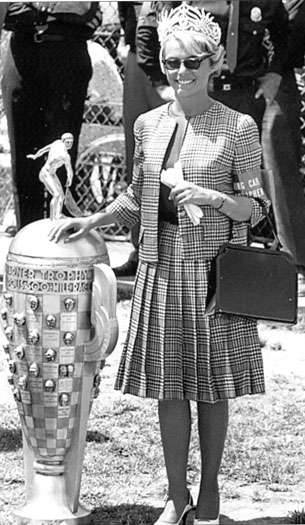 |
|
#1587 - Indianapolis Motor Speedway
management surely hired a different talent
agency for the 1965 500 than J.C. Agajanian
typically used to find those racy trophy girls
out at the California Racing Association. 500
Festival Queen Suzanne Devine was the definition
of prim and proper as she posed next to the Borg
Warner trophy. From
THE INDY 500
1956-1965, by Ben Lawrence, W.C.
Madden and Christopher Baas. (Ben Lawrence
Photo) |
|
A |
|
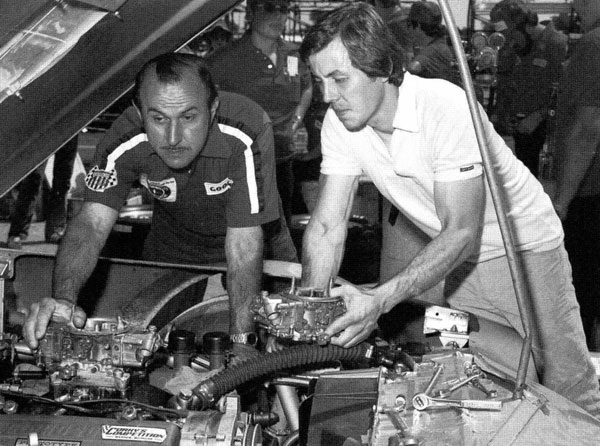 |
|
#1586 - “Alan Kulwicki
(right) and his father, Gerry, work on their car
together on August 3, 1980 (at the Milwaukee
Mile). Gerry, a well-known builder of stock car
engines, worked with championship driver Norm
Nelson. Alan won a number of short track races
in the area and an ASA race on the Mile on July
10, 1983 before moving south and winning the
1992 NASCAR Winston Cup Championship.” Quote and
Photo from
THE MILWAUKEE MILE, by Brenda Magee.
(Photo – Russ Lake and Mary Champion) |
|
a |
|
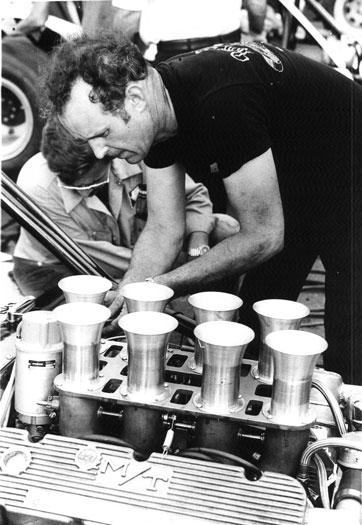 |
|
#1585 - That’s Modified
maestro, Bob Judkins tunin’ up one of his
legendary 2X rocket ships. Bob had a lengthy
list of world-class shoes in the seat, including
Kenny Shoemaker, Jim Hurtubise, Tony Mordino,
Jerry Wheeler, Stan Gregor, Fats Caruso, Bugsy
Stevens, Gene Bergin. But he also spent a lot of
time with Ronnie Bouchard, both in 2X machines
and in #7 M&H cars owned by Marvin Rifchin.
Here’s what Bob has to say in our new book,
RON BOUCHARD: Remembering the Kid from Fitchburg.
“Ronnie and I clicked really well, right from
the start. I think that’s probably because we
were both pretty laid-back. He used to tell me,
‘Judkins, you’re going to live forever, because
nothing ever bothers you.’ But he was the same
way, even at the races. He was really easy to
work with. He’d go out and practice, then come
in and tell me what the car was doing. He wasn’t
a chassis guy himself, and he didn’t try to be.
He’d just describe what it was doing, and leave
it up to me.” They won a ton. (Ron Bouchard
Museum Collection) |
|
A |
|
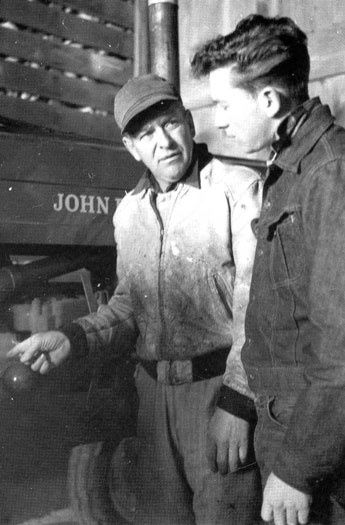 |
|
#1584 - Melvin “Tony”
Bettenhausen was one serious racer. Originally
part of the barn-storming Midgeteers known as
the “Chicago Gang,” he went on to win the Big
Car National Championship in 1951 and 1958. He
was also serious about his 500-acre farm in
Tinley Park. On this day there was no racing,
and he was talking crops with son Gary. He
boasted he could plow more corn in a day than
anyone in Northern Illinois. From
TONY BETTENHAUSEN AND SONS: An American Racing
Family Album, by Gordon Kirby with
Merle and Susan Bettenhausen (Wavelyn
Bettenhausen Collection) |
|
a |
|
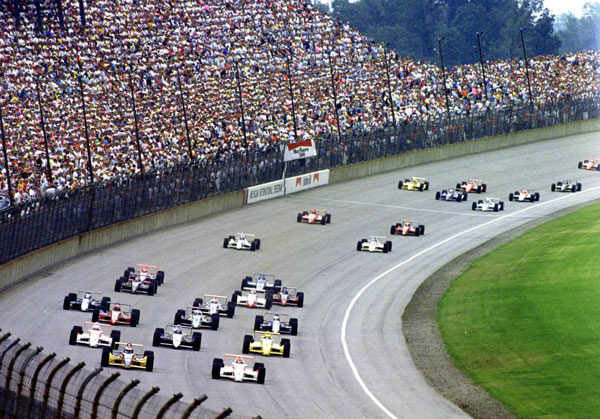 |
|
#1583 - It was not so long
ago. A packed grandstand and tobacco branding
everywhere. Emerson Fittipaldi leads away from
the green, chased by Bobby Rahal, Al Unser Jr.,
and Rick Mears at the 1990 Marlboro 500 at
Michigan. From
PENSKE’S MAESTRO: Karl Kainhofer and the History
of Penske Racing, by Gordon Kirby (Karl
Kainhofer Collection) |
|
a |
|
 |
|
#1582 - The site of the
Woodbridge,
New Jersey, High School looked a
little different back in the 1930s. It housed
what was called “the World’s Fastest Half-Mile
Race Track,” a board oval with 31 degree
bankings. On this date a noteworthy front row –
Billy Winn in a Fronty Ford and Fred Frame in
his familiar #34 Duesenberg brought them down
for the green. After the final race on the wood
the next month, the track was transformed into a
half-mile dirt, and after World War II, the
old-time Big Cars and their daredevil drivers
were never to return. But, when the high school
was built, the grandstands remained, servicing
far more gentle sporting events. (Photo by
Mildred Pauline Mikaolen, Bob Moore Collection) |
|
A |
|
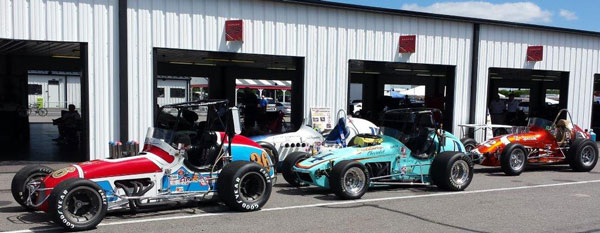 |
|
#1581 - The passion-stirring "dirt
cars" will make thunder again at the Vintage
Indycar Celebration at Pocono Raceway in PA,
with track time scheduled for Friday August
20th. Cars such as George Edward's 1972 Grant
King Chevy #36, Jeffrey Bardour's 1975 Steve
Stapp #4, and Paul Mondo's 1964 Meskowski 255
Offy #15 and 1968 Trevis Chey #42 will represent
the division, which appears to be experiencing a
very welcome rebirth of late. (Gary Mondschein
Collection) |
|
a |
|
 |
#1580 - Jim Lowrey, proprietor of
Lowrey Auto Restoration in Tilton, NH, is a
master craftsman building world-class,
period-correct hot rods. He's soft-spoken,
gentlemanly, with an endearing smile. Who would
have known that he is perhaps the most versatile
open-wheel competitor in New England. Although
he is selective about where and what he races,
quite remarkably he has won in Midgets, Sprints,
dirt track Modifieds, pavement Modifieds, and
big block Supers. Last Friday night he stopped
by Lee USA (NH) Speedway to run Bob and Eddie
Witkum's small block Super. They have struggled
with their car since a flip last fall, but Bob
remarked "that Lowrey has a wealth of talent.
He'll be back with us next week." (Coastal 181
Photo)http://www.coastal181.com/nlm-working-April-2005/openwheel-1.htm#LONE_WOLF_
http://www.coastal181.com/nlm-working-April-2005/openwheel-1.htm#LONE_WOLF_ |
|
a |
|
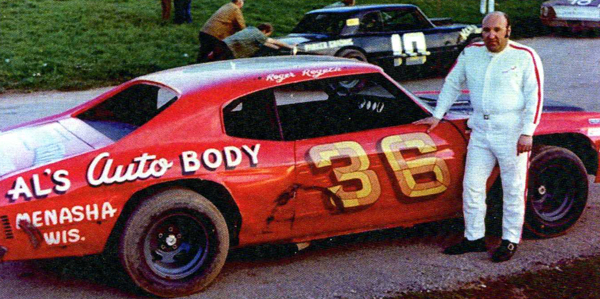 |
|
#1579 - Seventies-era racer Roger “The
Bear” Regeth sure had everyone’s attention on
the Wisconsin short tracks. Lightning fast, he
was winner of an estimated 500 features. He was
also known to do whatever it took to get the job
done. In his words,“ The fans booed me, but,
hey, they were just making noise. But I’d get
the drivers mad, too. At the start of every
race, I’d ram the guy ahead of me square to get
the field katty-whompus. I’d pass three or four
cars that way. I got Pete Parker so mad at me
one night after I pulled one of those moves he
came right after me. That’s just the way it
was.” Photo and Quote from LIFE IN THE PAST
LANE: A History of Stock Car Racing in Northeast
Wisconsin from 1950 -1980, by Joe Verdegan
(Photo by Tim Verstegen) |
|
a |
|
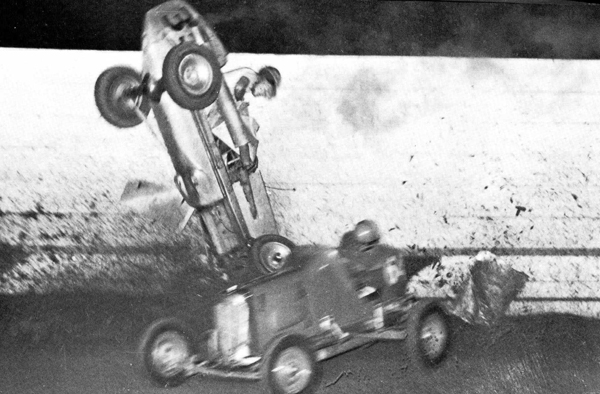 |
|
#1578 - That’s high-flying
Reynold Coleman executing an end-over-end at the
old Gilmore Stadium in California in the 1930s.
In his book
THE MIGHTY MIDGETS, Jack Fox claims
that the resulting head injuries helped persuade
Coleman to go to college rather than trying to
become a race driver headed for Indy. He dropped
his racing name in favor of his full name,
Reynold Coleman MacDonald. He was to become a
high-flying steel-industry magnate, and in the
1970s (according to USAC’s Dick Jordan), the
Chief Operating Officer of USAC and subsequently
its Chairman. From
THE MIGHTY MIDGETS, by Jack C. Fox.
(Craig-Alvarez Photo) |
|
a |
|
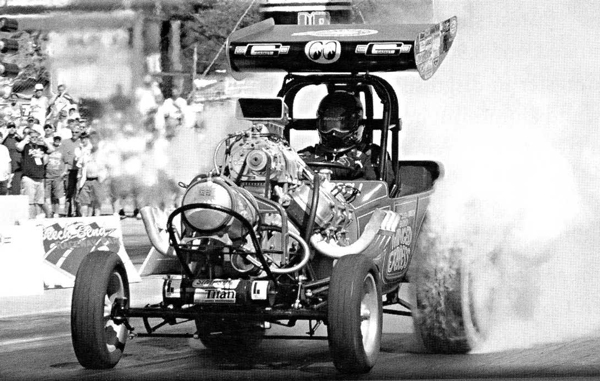 |
|
#1577 - “Wild Willie
Borach and Al ‘Mousie’ Marcellus’ Winged Express
was the Fuel Altered to end all Fuel Altereds.
The first of three Winged Express Ts was built
in 1960. As wild and competitive as the car was,
it’s probably best remembered for Willie’s
one-handed sideways burnouts. Willie was
initially unaware that he was ‘hanging on.’ The
reason he did it was because his 6-foot 1-inch
frame was too small for the seat and he’d slide
all over if he didn’t hang on. Few people knew
that Willie suffered from narcolepsy. It wasn’t
unusual to find him fast asleep in the staging
lanes with his fire suit on. You have to wonder
how he survived more than 20 years of
quarter-mile passes.” Quote from
1001 DRAG RACING FACTS: The Golden Age of Top
Fuel, Funny Cars, Door Slammers, & More,
by Doug Boyce (Photo Courtesy Bob Wenzelburger) |
|
a |
|
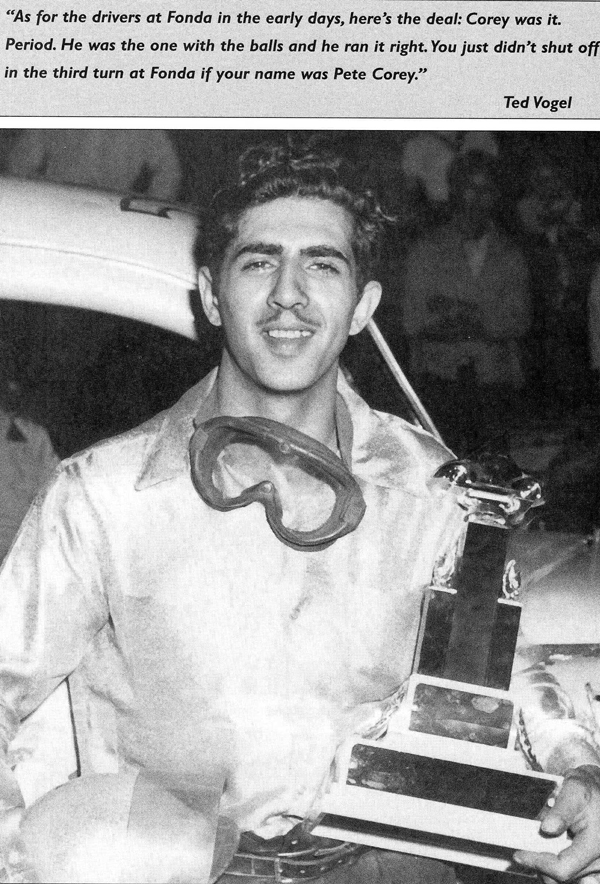 |
|
#1576 - Pete Corey, who died of leukemia in
2000, was quite likely the most popular AND the
most dramatic competitor in Fonda (NY)
Speedway
history. (See
TEAROFF dated 4/11/2010). Tomorrow night,
Corey and his sometime racing partner, Eddie
Pieniazek, will be honored at the popular
half-miler in upstate
New York. Pete Corey
Jr. will be towing up from
North Carolina for the
event with a yellow #3 replica of his dad’s
coupes that he currently races on the Southern
circuit. Page from
FONDA: An
Illustrated and Documented History of the
Legendary Fonda
Speedway, by
Andy Fusco, Lew Boyd,
and Jim Rigney. (Photo Dave Lape Collection) |
|
a |
|
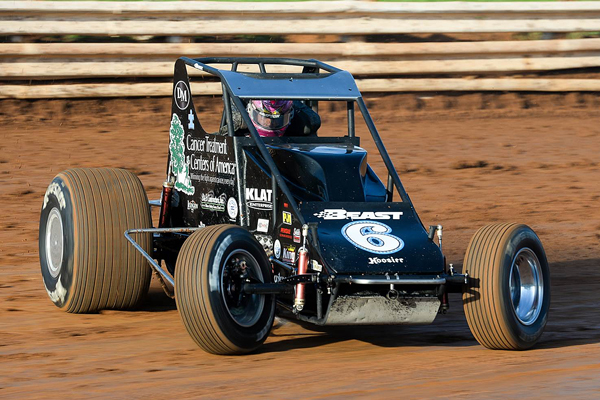 |
|
#1575 - Our buddy from
Connecticut, photographer par excellence John
DaDalt, has been keeping an eye on that Bryan
Clauson. “I just got back from PA and thought
I’d send along a shot of Bryan Clauson. He has
had a pretty good two weeks since Indy where he
led three laps of the 500. Then he hustled up to
Kokomo to win the Sprint Car feature. Next he
raced the USAC Indiana Midget Week, where he
finished four times in the top three positions
and won the Week’s championship. After that he
took three races on the USAC Sprint Car Eastern
Storm tour and won that championship. On Friday
he hopped in a Silver Crown car and put on a
late charge almost stealing the win from Chris
Windom. He finished 2nd. Here he is backing in
the Klatt #6 Silver Crown car in Williams Grove
warm-ups.” (John DaDalt photo) |
|
a |
|
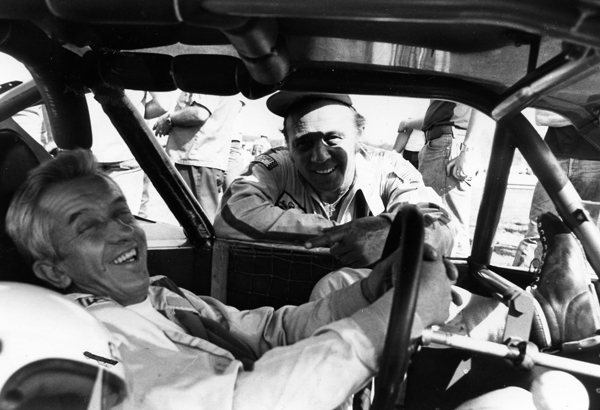 |
|
#1574 -
Two buddies and starring East Coast
Modified drivers (Eddie Flemke in car and Gene
Bergin leaning in) shared a smile before the
start of the 1981 Thompson 300. Here was Gene’s
take on things: “He and I were very different
drivers. Eddie was like a great dancer, just so
smooth, so light with his touch. Me, I was
totally the opposite: hard into the corner,
slipping and sliding, tough on the car. Just
more aggressive in general, I guess. I’d put the
hammer down and go. I got my style from people
like Jimmy Little and Frankie Blum. Most people
today have never heard of those guys, but they
were incredible racer drivers; just give ‘em a
steering wheel and they’d go fast, whether the
track was dirt or asphalt. They’d go charging
into the corner and slide through it, and I just
loved watching them. That, I thought, was how
you were supposed to drive a race car.” Photo
and quote from
STEADY EDDIE: Memories of Ed Flemke, Modified
Racing’s Fastest Professor, Edited by
Bones Bourcier (Howie Hodge Photo, Val LeSieur
Collection) |
|
A |
|
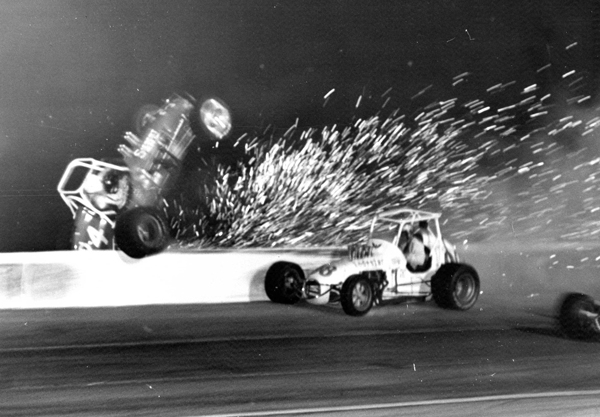 |
|
#1573 -
It was out of his hands. That was
Kentuckian Charlie Masters, just married, going
very fast on May 18,1974 in his USAC Sprinter at
Indianapolis Raceway Park – backwards, tail to
the wall, on his way outta the park. Meanwhile,
Mel Cornett in the #98 is on his way, too -
outta town. He likely knew Charlie was not too
pleased. (Cal Lane Collection, Tom Dick Photo) |
|
A |
|
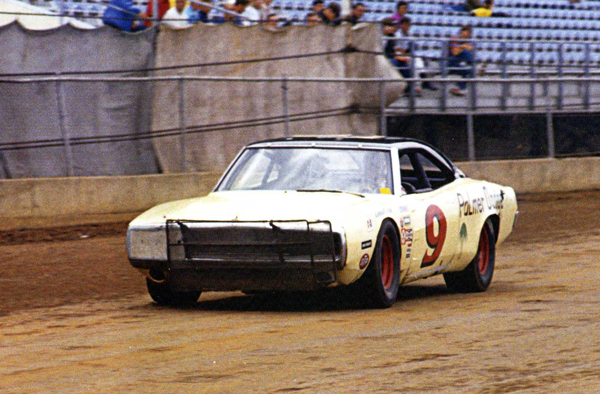 |
|
#1572 -
On March 24, 1970, Buddy Baker wrestled a Dodge
Daytona known as the DC-93 over the 200-mile
barrier at
Talladega for a world
record on a closed course. The car was
subsequently used for testing in 1970, but was
not to race again. When the car was no longer
useful to Chrysler, Ronnie Householder gave it
to a two-time USAC stock car champion in
Keokuk, Iowa,
named Don White. White, who passed away last
April 29, reskinned the car without the nose
cone and wing and took it on tour to asphalt and
dirt tracks, big and small, as shown above.
After White motored on with other machinery in
1976, the DC-93 sat unceremoniously in a field
out there by the
Mississippi. Years later
a Chrysler technician named Greg Kwiatkowski
became interested in the car, hunted it down,
and purchased it from White for $5000. It was
in rough shape but is now being restored to
200mph fitness. From
DODGE DAYTONA & PLYMOUTH SUPERBIRD: Design,
Development, Production and Competition,
by Steve Lehto. (Greg Kwiatkowski Collection)
|
|
a |
|
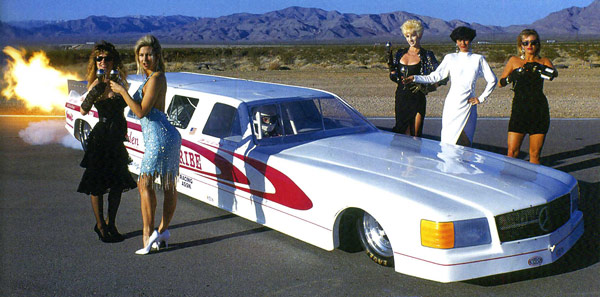 |
|
#1571 - “The
only printable image from a very comprehensive
photo shoot that Steve Reyes and assistant Tim
Marshall were hired to do on Jim Neilsen’s
Mercedes jet limo. Reyes fondly recalls,
‘Neilsen wanted some ink for himself and his
sponsor (Olympic Gardens Gentlemen’s Club in
Vegas). The ladies were from the club. It was a
fun shoot, out at the drag strip. Two of the
ladies had just gotten new boobs, and these were
the first photos of them.” All naughty stuff
aside, however, Jim “The Jet”’s limo is the real
deal. Outfitted with an 18,000hp Westinghouse
J-34 engine with dual afterburners, the
one-seater hits 100mph in one second. From
LOST DRAGSTRIPS II: More Ghosts of Quarter-Miles
Past, by Scotty Gosson (Photo Courtesy
Steve Reyes) |
|
a |
|
 |
|
#1570 -
Cool Suit. (North
East
Motor
Sports
Museum Collection) |
|
A |
|
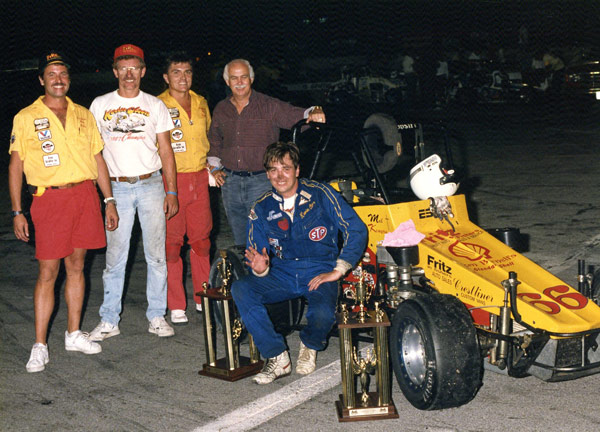 |
|
#1569 -
We’re working on our book about
that Kevin Olson for release this fall. My
goodness, does that guy ever go round and round.
Here’s what he has to say about the photo above:
“That was a 1988 500-lap USAC National race at
the Indy Speedrome. I was teamed with Mel
Kenyon. You had to make one pit stop and
actually get out of the car. With all the fumes
(of course I had an open face helmet) and laps,
when I got out I was a bit disoriented and dizzy
– kinda like when I leave a bar. As they
finished the fueling, I was standing there
pointed the wrong way so Lou Cicconi grabbed me
by the shoulders and steered me around so I
could get back in the car. We ended up winning
the race. The car had manual steering and, when
the track had rubber, it got real hard to turn.
I was physically exhausted and sore and couldn’t
hear for a few days. But drinking beer gradually
re-energized my body back to life….” (John
Mahoney Photo, KO Collection) |
|
a |
|
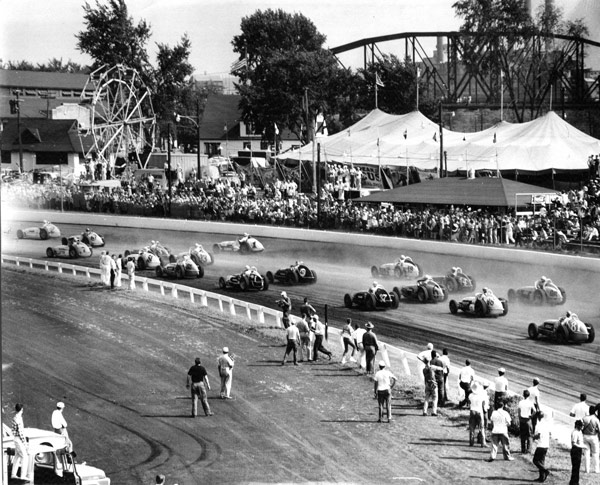 |
|
#1568 -
Everything about the 100th Indy
500 this year was pleasingly packed with passion
and people. Saturday’s Memorabilia Show in the
IMS Pagoda Pavilion was no exception. Our friend
Cal Lane was there from Burdett, NY, with his
huge racing picture collection. We picked up
this very cool Fairgrounds shot, but we need
help. We asked just about everyone we could at
the Pavilion about it, and to the one they loved
its historic context, but no one could tell us
where it was. Do you know? (Cal Lane Collection) |
|
a |
|
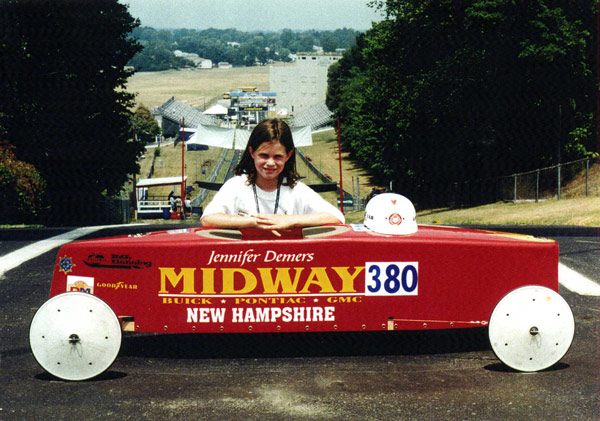 |
#1567 -
Racing has its way of trickling
down through family generations, but sometimes
it trickles up. Such was the case with Jennifer
Demers, shown here at the top of the hill in
Akron, Ohio, on July 28, 2001, the 64th running
of the All American Soap Box Derby World
Championship. Jennifer made such an impression
on folks out there with her performance – and
personality – that she and sister Lauren were
invited to compete in the Soap Box Championships
in Berlin, Germany. Their dad, Bob Demers, who
owns MidWay Buick GMC in Somersworth, NH, was
also quite impressed. So much so, that, already
in his forties, he started SCCA racing. He was
quick, too, and is still going strong today.
He’s a Touring 4 record-holder at Thompson, CT;
Lime Rock, CT; and Loudon, NH. (Bob Demers
Collection)
|
|
a |
|
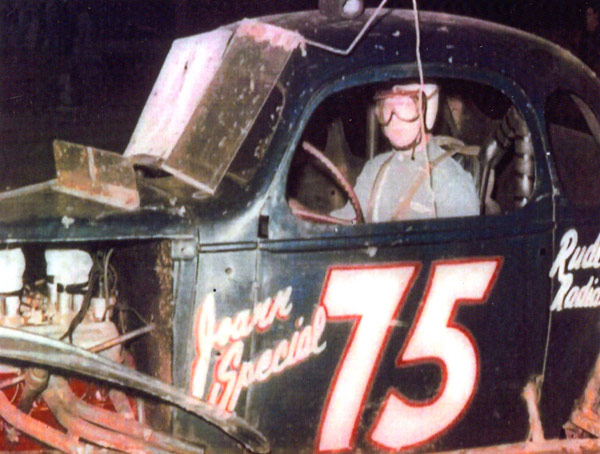 |
|
#1566 -
It was way back in the mid-1960s,
and the whole thing was just beginning. That’s
Bugsy Stevens in an early Lenny Boehler Modified
even before they became #3, let alone “Ole Blue”
– and national champions. They were running
everywhere, even on the dirt, as shown here at a
Sunday night open-competition 100-lapper in
Lebanon Valley, New York. Bugsy insists that he
ran right up front in that race, but dropped
back to third on the last lap because his
goggles fell off. Do you believe him? (Don White
Collection) |
|
A |
|
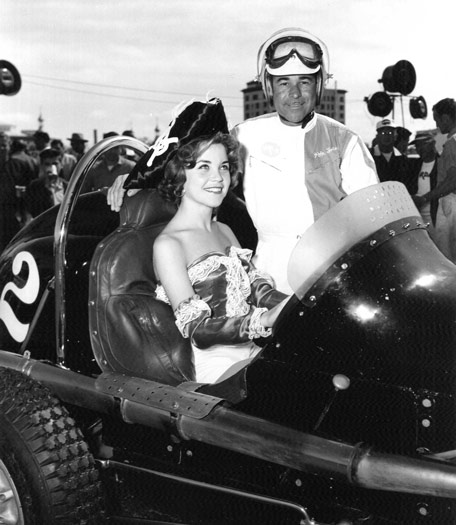 |
|
#1565 -
Showing up at the Winter Nationals
in Tampa with Hector Honore’s revamped Offy,
three-time IMCA champion Pete Folse was
certainly focused on regaining the title after
Johnny White snatched it in 1962. However, Janet
Palmer, “Miss Tampa,” may have caused just a bit
of distraction along the way. (Cal Lane
Collection) |
|
a |
|
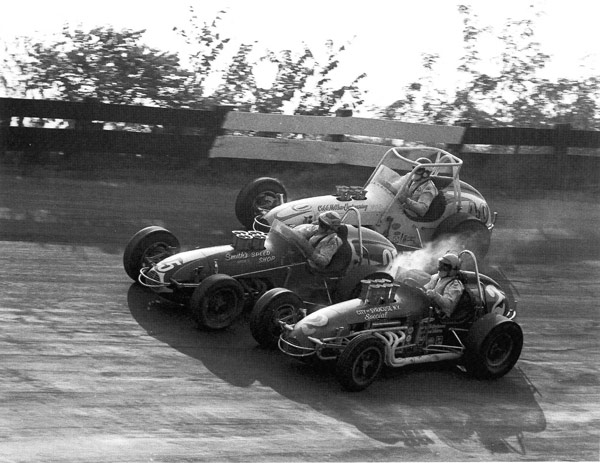 |
|
#1564 -
We are thrilled to be carrying
Gordon Kirby and Joe Freeman’s brand new book,
TONY BETTENHAUSEN & SONS: An American Racing
Family Album. The volume is beautifully
packaged with compelling text, complete records,
and fabulous photography. Here’s a John Mahoney
shot that redefines “wheel to wheel.” Rollie
Beale, Bruce Walkup, and Gary Bettenhausen (in
Willie Davis’ infamous “City of Syracuse”
Sprinter) have their minds set on the very same
real estate. |
|
a |
|
 |
|
#1563
- These days it seems most
Sprint Cup drivers need mini-Hummers to get
around the infield area. For IndyCar drivers, an
amped-up golf cart is pretty typical. But John
Andretti has a simpler, greener solution. A hand
truck with Bones-power works just fine, as shown
as they departed the Memorabilia Show at the IMS
Pavilion last Saturday. (Dave Darland photo) |
|
a |
|
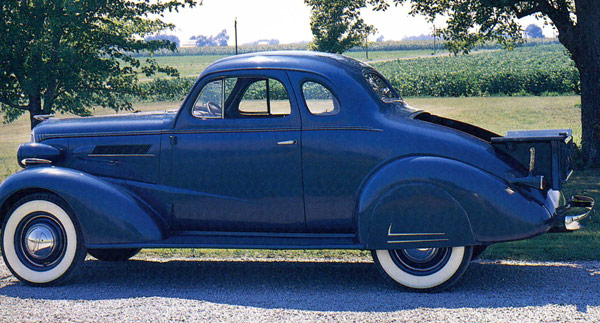 |
|
#1562 - “Everything about the 1937
Chevrolet seemed new and everything seemed
right. With the previous year’s hydraulic brake
system, Knee-Action ride and all-steel body, it
was given a new 216.5 cu. in., 85 hp, 6 cylinder
engine – a compact improved ‘Cast Iron Wonder’
that was more wonderful than ever. The new
frame, which added 4 in, and the new hyoid axle,
which lowered the floor some 2 in., created more
interior space and an opportunity to create a
well-executed exterior that made this an
important Chevrolet transition model, continuing
it as the number one sales leader.” The coupe –
and particularly that relatively slippery body –
sure drew the loyalty of the short track stock
car crowd over the years. One wonders how many
of these Master coupes still exist, untouched by
relentless cutting torches. Quote and Photo from
GM: The First 75 Years of Transportation
Products, by the Editors of Automotive
Quarterly Magazine. |
|
a |
|
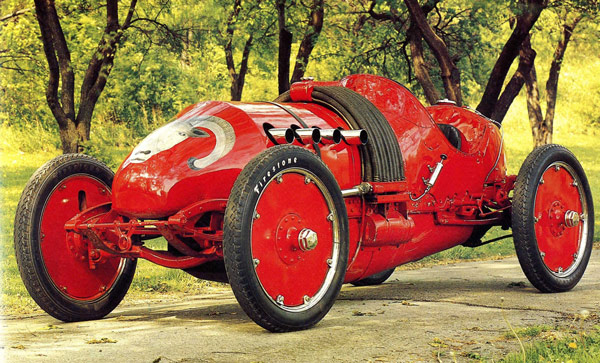 |
|
#1562 - The place was already
known as the Brickyard in 1910, but the 500 was
still a year away when Louis Chevrolet and
teammate Bob Burman brought this Buick Bug into
town. A hefty four-cylinder engine would haul it
down the straightaways, and Burman reached a
record-setting 105mph. The turns, however, were
another story. The nose cone, definitely more
ornamental than functional, and the body were so
narrow that the car pitched badly. It was a
snail pace on the bankings. Photo from GM:
The First 75 Years of Transportation Products,
by the Editors of Automotive Quarterly
Magazine. |
|
a |
|
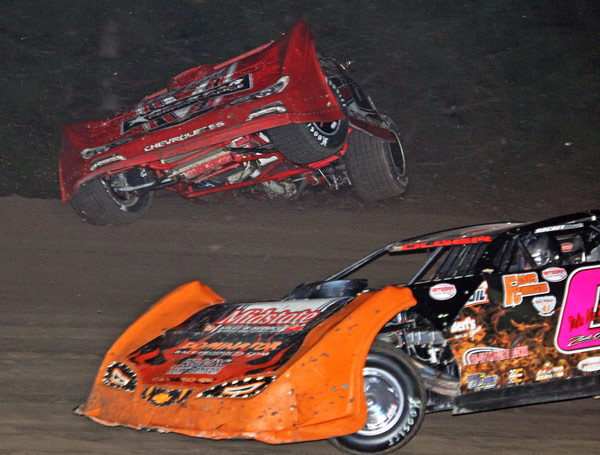 |
|
#1561 - Things didn’t look all that
good for
Houghton Lake,
Michigan’s winning Super
Late Model shoe Dona Marcoullier entering the
turn at Merritt Speedway last Labor Day
Weekend. It didn’t get any better either, but
Dona was able to scramble uninjured after an
endo. (Mike Adaskaveg Photo) |
|
A |
|
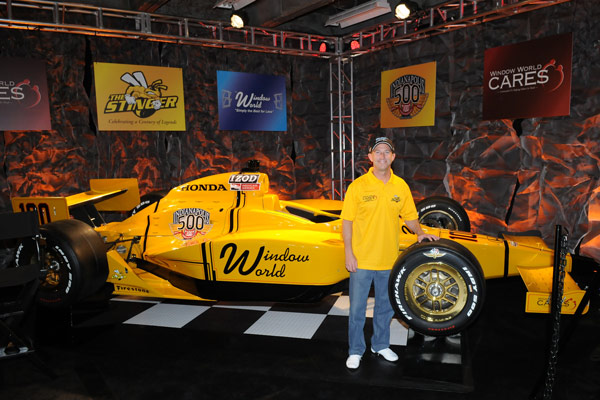 |
|
#1560 - A huge commitment to charity
is shared by John Andretti and his long-time
sponsor, Window World. Over the last couple of
years they have been preparing this beautiful
updated replica – called The Stinger – of the
bumblebee-yellow Marmon Wasp with which Ray
Harroun captured the original Indy 500. In an
enormous effort, John traveled countrywide to
have nearly every one of the 273 living Indy
drivers autograph the car, making it perhaps the
most valuable piece of racing memorabilia of all
time. On Wednesday of next week, May 25 at 6:00
pm the car will be auctioned off at the Dallara
IndyCar Factory with the proceeds going to St.
Jude’s Children’s Research Hospital. Then, on
Saturday from 11-12:00 noon, John will join
Bones Bourcier at the Coastal 181 booth at the
Indy Memorabilia Show to sign copies of
THE STINGER: 273 Drivers Speeding Toward Hope,
the book they co-wrote describing the project.
Photo from THE STINGER by Bourcier and
Andretti. |
|
A |
|
 |
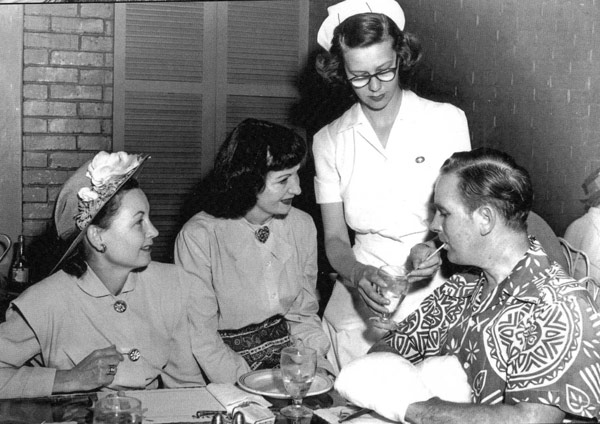 |
|
#1559A&B - Dennis Nalon really was
the “Iron Duke.” Sixty-seven winters ago, he
whisked his Novi into the lead at Indy from the
pole. He was haulin’ the freight for 23 laps
when suddenly his left rear axle snapped in the
third turn. He slid frighteningly along the wall
completely ablaze, but had the sense to hold his
breath, so as to save his lungs. He was able to
scoot out of the fire when the car stopped. In
the second image he is all cooled off in
recuperation, recipient of nourishment from the
nurse and warm glances from his wife, Fran, and
Mrs. Wilbur Shaw to her right. From
FEARLESS: Dangerous Days in American Open Wheel
Racing, by Gene Crucean. (Top photo Gene
Crucean Collection, Bottom photo Len Schofner,
Paul Johnson Collection) |
|
a |
|
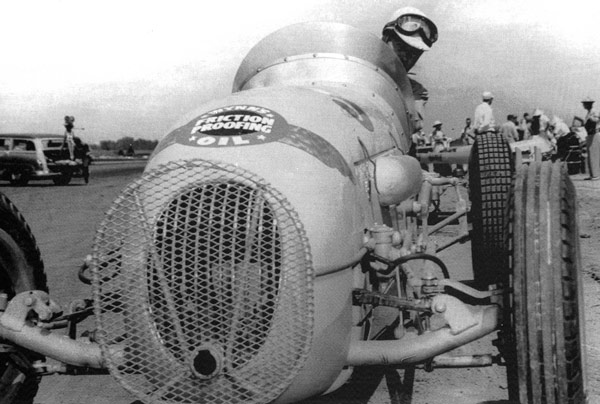 |
#1558 - On September 1, 1951 Johnnie Parsons showed up at Du Quoin
with the Wynn’s Friction Kurtis 300 for the
100-mile Big Car race. He proceeded to
win the pole position with a lap of 98.87mph
around the heavy, rock-strewn mile. Check out
those tires – and that roll cage. How fast would
you have gone? From THAT MAGIC MILE: The
National Championship at Du Quoin 1948-1970,
by Tom Nasti. (Phil Harms Collection)
|
|
a |
|
 |
|
#1557 - Oh dear. Grant Stoms encountered a bit
of an engine problem with the RAMPAGE Top Fuel
dragster at
Englishtown, NJ,
in 1976. From
TOP FUEL DRAGSTERS, by Steve
Reyes. (Norman Blake Photo) |
|
A |
|
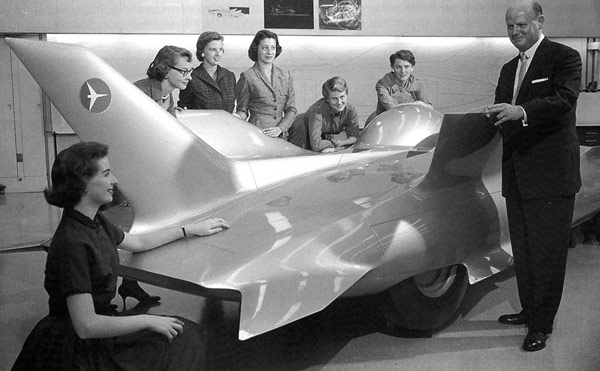 |
|
#1556 - The noted car designer Harley
Earl – responsible for such accomplishments as
leading the team that conceptualized the
Corvette – organized a group of women in the
1950s nicknamed the “Damsels of Design.” They
did some pretty racy stuff, including work on
the Firebird III (above). Shown with them,
however, was their new boss, Bill Mitchell, who
became VP of GM Design. Stating that “No women
are going to stand next to any senior designers
of mine,” he disbanded the team. Perhaps it was
a sign of the times. The women were not too put
out. According the a piece in the New York
Times in June of 2010, “they shrugged off
hurdles or obstacles simply focusing on ‘being
really good’ at what they did.” From
THE
CARS OF HARLEY EARL by David W. Temple.
(Photo GM Media Archive) |
|
A |
|
.jpg) |
|
#1555 - How about that Ventura
Speedway, so curiously positioned right there on
the coastline of Southern California? Once a
dirt half-mile, then tenth of a mile, and now a
fifth, it has offered up all kinds of racing,
starting with motorcycles, for 106 seasons. Do
you figure when the Offies ran there folks could
hear them in Waikiki? (Mike Adaskaveg Photo) |
|
a |
|
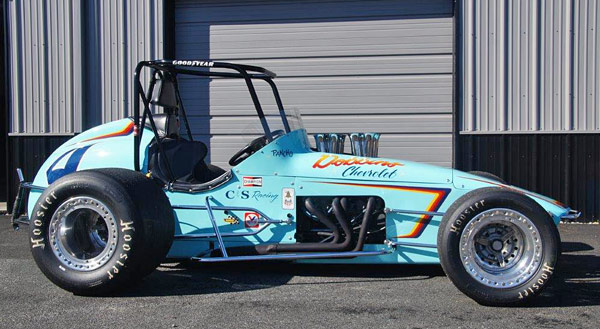 |
|
#1554 - Back in Colonial times there
was a fiery preacher named George Whitfield
whose eyes would do laps in different directions
when he spoke. One day after biting into a
strawberry, he commented with enormous
enthusiasm, "Quite possibly the Lord may have
made a sweeter berry, but quite possibly He
never did." What in the world would He have said
about the drop-dead beautiful specimen Jeff and
Karen Bardour towed up from Pennsylvania to the
Vintage Days last week at Thompson (CT)
Speedway?. It was the masterfully restored
Dobbins Chevrolet Sprinter built by Steve Stapp.
Pancho Carter wheeled it to the USAC
Championship in 1974 and 1976. It was seen in
Victory Lane at Eldora, Terre Haute, Winchester,
the Indy Fairgrounds, New Brennan, and Salem.
(Deb VanWert Photo) |
|
a |
|
 |
|
#1553 - It almost seemed that the
Gilmore Oil Company was as focused on delivery
of needed entertainment to Depression-weary
Americans as it was to fueling them up in their
chain of service stations. And much of their
attention was on auto-racing promotions and
racing cars. It’s said that organized Midget
racing in Southern California was just a year
old when Earl Gilmore erected the Gilmore
Stadium in L.A. in 1934. Gilmore’s enormous
crowd must have been thrilled the October night
in ’38 that Fred Friday got all fired up – and
relieved big time when he scampered out
uninjured. From
ROAR WITH GILMORE: The Story of America’s Most
Unusual Oil Company, by Charles Seims
and Alan Darr. |
|
a |
|
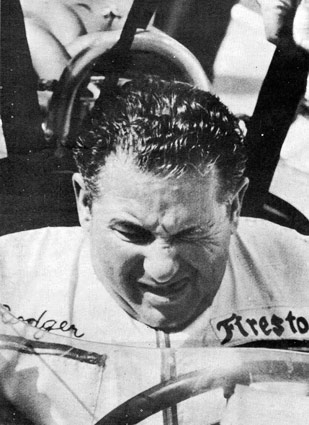 |
|
#1552 - Fifty years ago an
Illustrated Speedway News photographer
caught Rodger Ward, the undeniably
testosterone-fueled winner of the Indy 500 in
1959 and 1962, about to climb from the Bryant
Heating Special. He had just qualified fifth row
inside for the 1966 running and was letting
loose a tear or two. He had missed the show the
year before. Such was the passion of the Bricks.
(Illustrated Speedway News Photo, May
24, 1966) |
|
A |
|
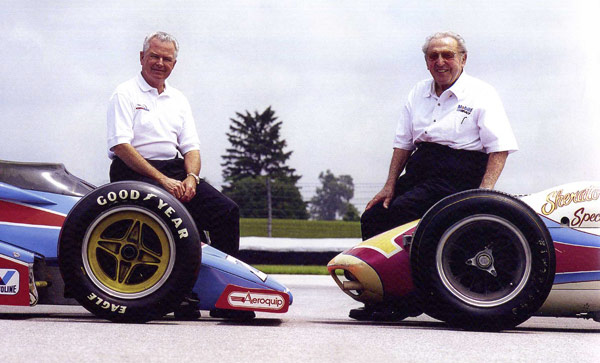 |
|
#1551 -
Massachusetts native Jim McGee (L) and
California’s George Bignotti were “the master
Indy car chief mechanics of their era. Jim’s
cars won 90 races from 1965-2005 and Bignotti’s
machines won 85 times between 1958-83.” Photo
and Caption from
JIM McGEE: Crew Chief of Champions, by
Gordon Kirby. (Mike Levitt/LAT Photo) |
|
a |
|
 |
|
#1550 - Rough one.
(Location, date, and origin all unknown.) |
|
A |
|
 |
|
#1549 - Think you might like to
race but don’t have a race car, tools or a lot
of money? There are opportunities all across
America just like COM, an offshoot of an old
Corvette club that does high-speed timed laps at
Northeast road-racing circuits. This photo shows
one of their most popular cars, a Mazda Miata.
Look carefully because behind the ‘race’ car,
which was driven to a recent event at New
Hampshire Motor Speedway, is a small trailer
with the car’s spare tires and toolbox! The race
car tows its own pit supplies to the track. Most
of the cars that participate are very
inexpensive and have two seats, one for the
driver and one for an instructor, which COM will
provide. The club costs $35 to join, new members
get a $100 discount off their first event and a
full weekend on-track is $425. You need to wear
a helmet, non-open-toe shoes, slacks (no shorts)
and a helmet. And you must have a valid driver’s
license. Firesuits and roll cages aren’t
required. You can drive your car to the track,
tape a number to the door and see how fast you
can go. Laps with instructors are required
before drivers are turned loose on their own.
The club may be able to help you secure a
rent-a-car for a weekend in which you can get
started. Lots of couples participate. The
website is
www.comscc.com . (Photo and caption by Dick
Berggren) |
|
a |
|
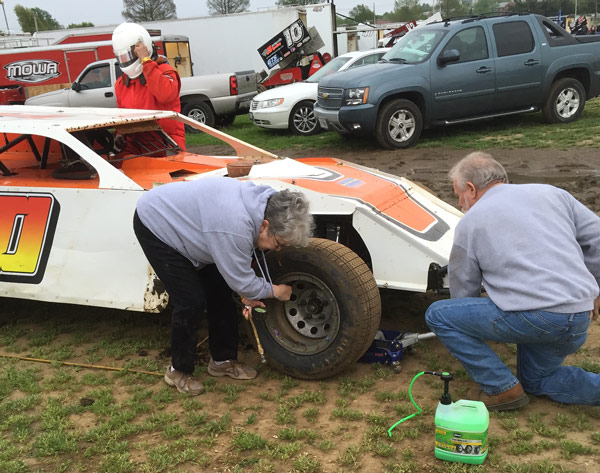 |
|
#1548 - One of our all-time favorite racers is
soft-spoken, perpetually underfinanced, and
exceptionally proficient Rick Standridge of
Collinsville,
Illinois. Currently in
his 46th season, he stopped counting trophies at
200, Sprinter and Late Model wins among their
number. And look who was making a sneak air
pressure adjustment a week ago at Jacksonville
Speedway while Rick was climbing aboard. That's
wife Joyce Standridge, the world-class racing
journalist who has penned as many pages as Rick
has turned laps. As well as her time-honored
columns in
Speedway Illustrated,
Joyce has also authored books such as
GOTTA RACE!
(Kenny Schrader),
INSIDE HERMAN'S WORLD (Kenny
Wallace),
WIN IT OR WEAR IT (Sprint Car
tales),
FAST MEMORIES (the old
Springfield Speedway), and
AUTO RACING, I GAVE YOU THE BEST YEARS OF MY
LIFE (racing reflections).
(Photo by Nancy Standridge) |
|
A |
|
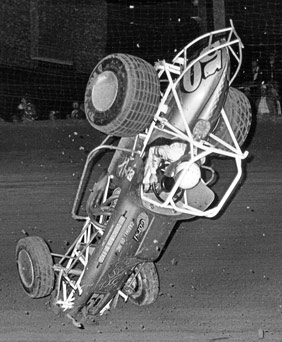
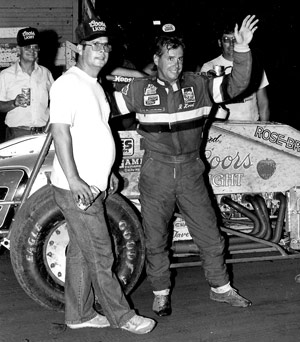 |
|
#1547 - “The National Sprint Car Hall
of Fame was still in the future when Rickey Hood
came to Springfield, Illinois. Once, it didn’t
turn out so well, as shown to the left. But on
the right he is in Victory Lane. The previous
evening, a local driver had won the feature, and
in the pay line Rickey told him, ‘You won’t get
the winner’s pay tomorrow night because you
showed me the line.’ Sure enough.” Photos and
caption from
FAST MEMORIES: Springfield Speedway 1947-1987,
by Joyce Standridge. (Crash photo, Allen
Horcher; Rickey in firesuit, Kevin Horcher) |
|
a |
|
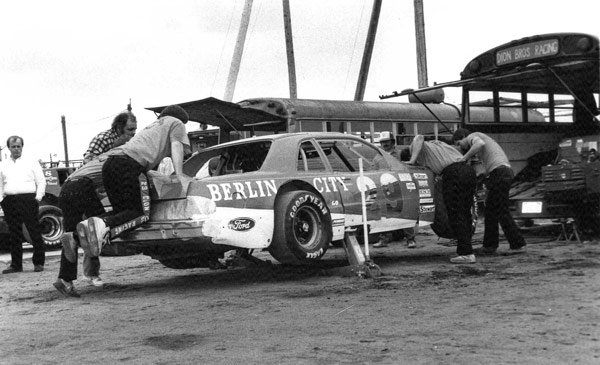 |
|
#1546 - Those Dion Brothers, the great
Late Model team out of New Hampshire, were at
the top of their game for over 25 years. They
were Ford guys – and, wouldn’t you know, great
friends of the Wood Brothers. It also turns out
that the two teams were very much alike in
mechanical creativity. Here is a Dion Brothers’
version of what the Wood Brothers did for the
British in their pit stops at Indy: Some years
ago Bob Bahre, then promoting Oxford Plains
Speedway in Maine, banned the use of air
wrenches for pit stops in his marquee Oxford 250
event. That was enough to get the Dion brains
all heated up. They decided they could win if
they could still change two outside tires
without losing a lap. So, they developed
trick-city hand-spinner wrenches. Using
four-ways, they flared them back and filled the
outside ends with lead. They installed bearings
where the changer placed his hands, and they
balanced them. Then Roger and Paul spent a month
practicing tire changes. It worked like a champ.
Driver Dave brought her in at 150 laps, they
changed the outer two tires, and he went out
like a rocket ship. It looked like a sure win,
but fate intervened. Dave got drilled in the
left rear, bouncing the oil tank off the tire,
and he left the track in a ball of fire. (Robin
Hartford Photo, North East Motor Sports Museum
Collection) |
|
A |
|
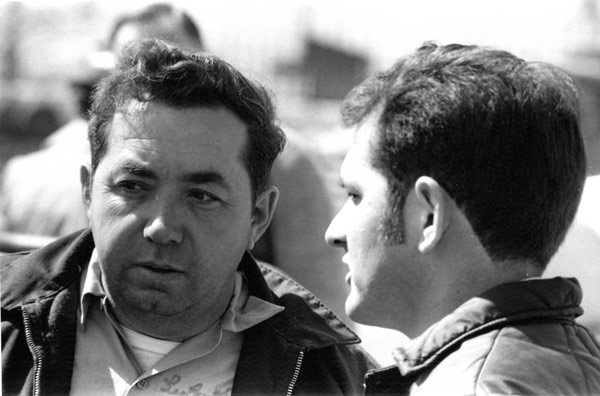 |
|
#1545 - Dick Berggren captured a
pivotal moment between two serious racing
professionals at the USAC Sprint Car event at
Reading, PA, on March 28, 1971. Joe Saldana
(right) had just walked up to legendary owner
“Boston Louie” Seymour and said, “Hi, my name’s
Saldana, and I am here from Nebraska to drive
your race car.” Like a classic Casablanca movie
rerun, it was the beginning of a beautiful
friendship. Saldana drove off and on for the
Seymours for years, both in Sprinters and Silver
Crown events. And in later years, as Louie’s
sons Bobby and Mike entered the open-wheel speed
parts business, they did lots of business with
Joe’s innovative company, Saldana Plastic Tanks.
|
|
a |
|
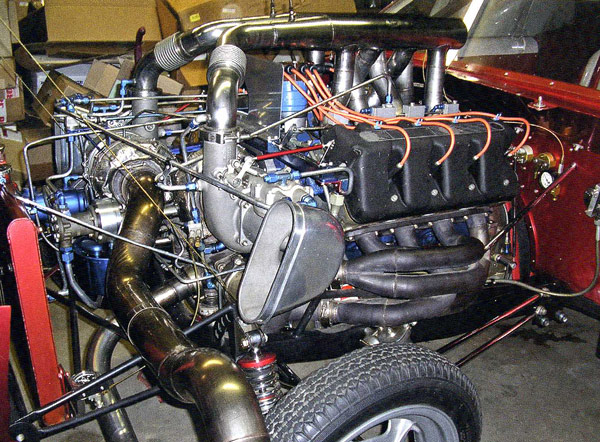 |
|
#1544 - Working out of Dayton, “Ohio
George” Montgomery was an alpha competitor in
the infamous drag racing “Gasser Wars” of the
1960s. He was lightning fast behind the wheel,
but equally successful at the workbench. He was
certainly not averse to complex design, and the
classic example may have been this boss 429 he
built for Ford Motor Company and the Mr. Gasket
Gasser. It was as if George conceptualized it as
two separate four-cylinder engines. He put on
two separate turbocharged intake systems. From
“OHIO GEORGE” MONTGOMERY: Drag Racing’s
Gasser King, by Patrick Ertel with Bill
Holder. (Phil Kunz Photo) |
|
a |
|
 |
|
#1543 - This would definitely have
been fun to watch. 1956 was the final year for
the California Racing Association roadsters, and
by early spring fields were weakening. So on
March 23, the club tried something different. A
mixed Sprint Car/Roadster show was held at the
Willow Springs sports car track, called by Dick
Wallen “a windy, dusty, high desert venue… The
circuit itself was wonderful, with some
fair-sized straights, elevation changes,
challenging turns in both directions and a fast
sweeper that tightened at the end. The pavement
wasn’t very good … And don’t ask about the
sanitary facilities. Just bring your own Sears
and Roebuck catalogue.” Danny “Termite” Jones
bested the 32-car field and the big-boy slice of
the hefty $2,000 pie. From
ROARING ROADSTERS: The Road To Indy, by
Dick Wallen. (Greg Sharp Collection) |
|
A |
|
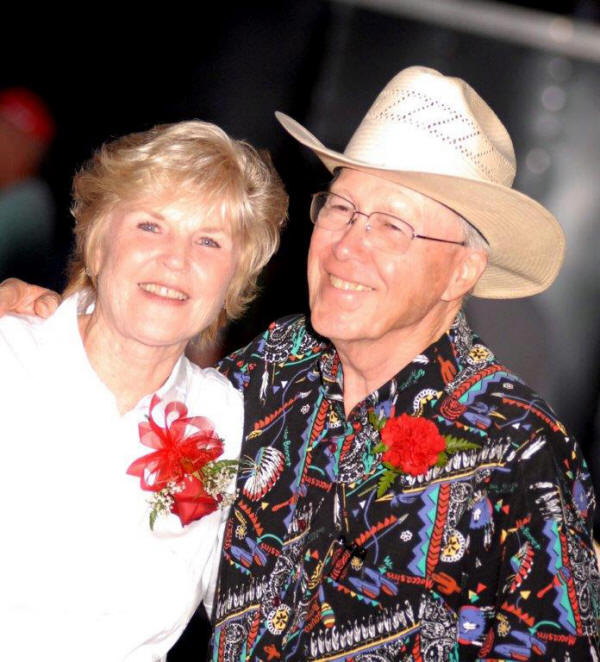 |
|
#1542 - That's racer Bill Wimble, who
died Sunday, April 24, and his beloved wife,
Nancy. Few men have ever shown more elemental
kindness and love for family during their years
than Bill. He also was the consummate American
entrepreneur, working his way from a dirt-poor
dairy farm on the St. Lawrence Seaway to the CEO
role with major transportation concerns. And
somehow along the way, he also managed to emerge
as one of the best circle-track competitors ever
in the Eastern half of the United States. He was
multi-time NASCAR Sportsman champion in the
‘60s, winner of 100s of features, and admired by
1000s of fans for the last seven decades. He
will be remembered by his friends for his
unending determination, as demonstrated
dramatically in a racing situation in the
TEAROFF dated 12/16/2008. Services will be
held for Bill on Monday morning in Riverview,
Florida. (Frank Simek Photo). |
|
a |
|
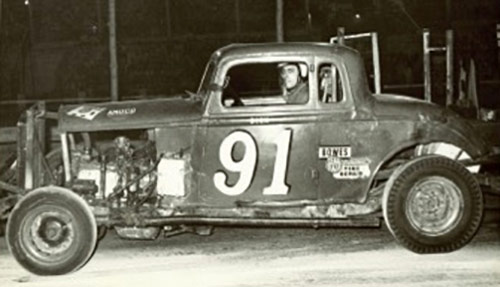 |
|
#1541 - Upstate New York has been a
hot spot right since the first short track
racers made thunder. While much of the region is
dotted with dirt tracks, in the 1950s and 1960s
there was an active asphalt circuit in the
Hudson Valley, including venues like Pine Bowl,
Menands, Coxsackie, and Rhinebeck. Some of their
entries complied with Non-Ford rules, a very
popular division in the Northeast at the time. A
spirited standout among the competitors was Red
Hook’s Dick Hansen, known early on as “the
Flying Grocery Boy” and later on with more
ferocious monikers. He’s shown here at Rhinebeck
after a win in a pretty square top with a
Chrysler Spitfire. That engine was built in a
college dorm room by Stu Murray, who later as
CEO of Wirtgen America sponsored the likes of
Mark Kinser, Bentley Warren, and the Seymours of
Boston. Hansen and a gaggle of his fellow
competitors will be appearing a Rhinebeck
Reunion on May 7, as described below. (Photo
Dick Hansen Collection) |
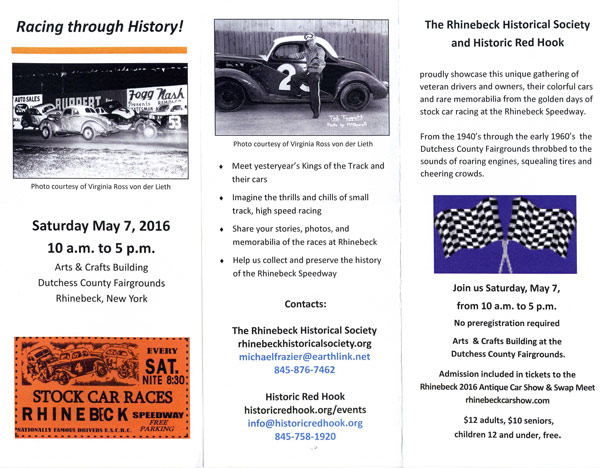 |
|
a |
|
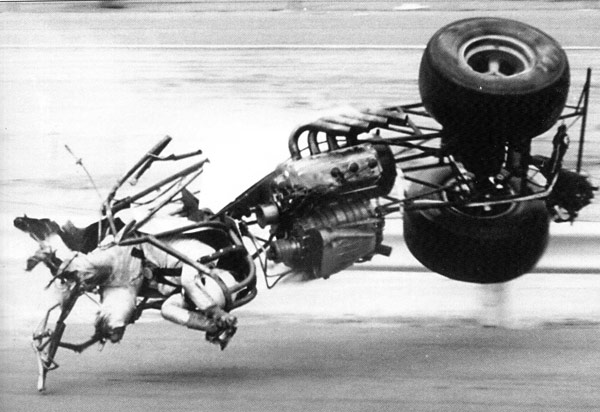 |
|
#1540 - “The biggest unspoken fear of
the rear-engine Top Fuel dragster driver was
“what if” a rear-engine Top Fuel car hit an
Armco guardrail head on. Unfortunately, Kenny
Logan showed all too well what happens to a
driver and a car when this type of accident
happens. Logan’s car hit a slick spot at the
Orange County International Raceway, sending it
hurtling at speed into the Armco guardrail
barrier. The ensuing crash cost Logan his legs
and right hand. He was dead at the scene, but
the OCIR emergency crew had a new respirator and
used it to bring Kenny back to life, and he
recovered. The crash …resulted in the Armco
being replaced with concrete barriers. Kenny is
still around and attends the annual Hot Rod
Reunion in Bakersfield, California. Quote and
Photo from
TOP FUEL DRAGSTERS: Drag Racing’s Rear-Engine
Revolution, by Steve Reyes. |
|
A |
|
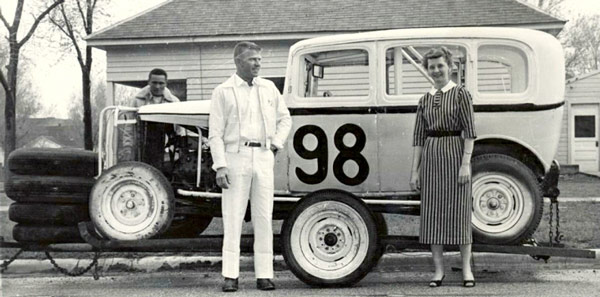 |
|
#1539 - It was opening Day, April 27,
1958. Alvin “Gene” Coffman picked up the race
car from owner Clarice Palmer in Tyrone, OK.
They ran at Larned, Kansas, grabbing a third in
the heat and a fifth in the B Main for a haul of
$8.88. (Photo from Bob Lawrence’s Kansas
Racing History) |
|
a |
|
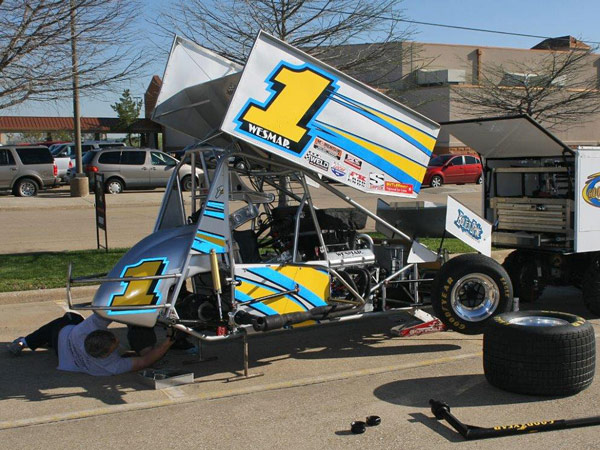 |
|
#1538 - How many times have you walked
out of a motel room in the middle part of the
country and come across a Sprint Car in a
million pieces in the parking lot being prepped
for another evening's activities? In this case
it was Danny Jennings out of Norman, OK, getting
ready for ASCS racing at Devil's Bowl in
Mesquite, TX. That particular morning, though,
seems especially shiny. So does the Wesmar #1.
There's nary a dollop of clay anywhere. (Steve
Janek Photo) |
|
a |
|
 |
|
#1537 - It was one loud and glorious
moment: the start of the Bettenhausen 100 on the
Springfield, Illinois, mile on August 20, 1988.
The race was first run in 1956. On this
occasion, Carmel, Indiana’s Steve Chassey was
first across the finish line, followed by Gary
Bettenhausen and Bruce Field. From NATIONAL
SPRINT CAR ANNUAL – 1988. (Photo Dr. Harlan
Hunter) |
|
A |
|
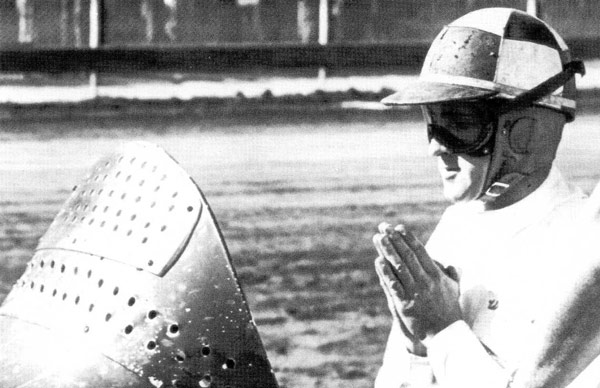 |
|
#1536 - Everything about Eddie Sachs
seems so wrapped in color and outrage that an
image such as this seems a bit unusual. There
was a more thoughtful side to him, though. In
1961 he was leading the Indy 500, but he noticed
right rear tire wear. Surprisingly (but wisely),
he pulled into the pits for a tire change, and
A.J. Foyt powered by to beat him to the win by
eight seconds. Sachs later commented, “I’d
rather be second than dead.” It was quite a
dramatic moment. A.J. recalled, “I felt a
vibration. It wasn’t the car. It was the crowd.
There were 300,000 people screaming. I knew
something had happened to Sachs. I came around
and saw his car in the pits.” Quote from
AUTOCOURSE – Official History of the
Indianapolis 500, Second Edition, by
Donald Davidson and Rich Shaffer. (Photo from
THE EASTERN BULL RINGS: The History of the
Eastern Big Car Championships, 1945-1960,
by Buzz Rose. Sam Traylor Collection) |
|
a |
|
 |
|
#1535 - We’re not really too big into
the “guess who” deal, but this one is SO
unintuitive. The location is Florida, the year
1962, and the car the Chevy jalopy from hell.
Who is that long-legged, thin-armed teeny-bopper
who continued on to a moon-shot career? (The
answer is next to the photo credit). From
FLORIDA MOTORSPORTS RETROSPECTIVE PICTORIAL Vol.
1, 2nd Edition, by Eddie Roche. (Bobby
5x5 Day Photo -- It’s Gary Balough) |
|
A |
|
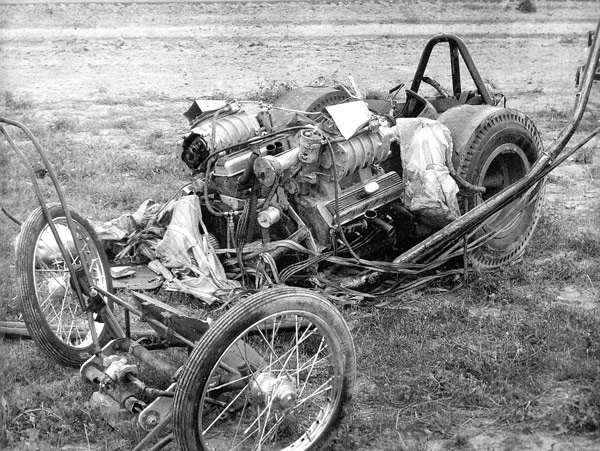 |
|
#1534 - Two was just too much. In
1962, Dan Knapp, Chester Blazik, and driver Don
Westerdale, towed from Michigan to the newly
opened the Niagara Airport Drag Strip. Their gas
rail, “Double Trouble,” housed two direct-drive,
co-joined 327s and it turned an impressive 7.99
ET. As was the case with many twin-engine
dragsters and hot rods, however, chassis
stresses broke up the whole deal. From
LOST DRAGSTRIPS II: More Ghosts of Quarter-Miles
Past, by Scotty Gosson. (Dean Johnson
Collection) |
|
A |
|
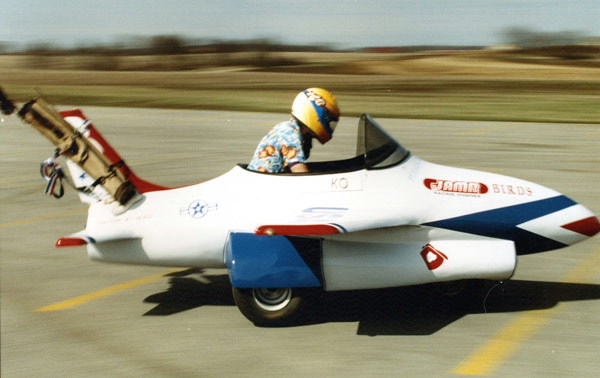 |
#1533 - So, we’re doing a Kevin Olson
book. Problem is that we don’t even know where
to start! (Photo: KO’s Pathological Collection)
|
|
a |
|
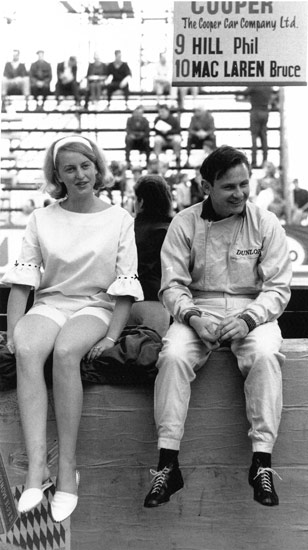 |
|
#1532 - That’s the “Speedy Kiwi,”
Bruce McLaren, with his wife, Pat, at Monaco in
1964. McLaren, despite illness as a child that
left him with a limp, was lightning fast, the
youngest GP winner ever at age 22 with his
triumph at the US Grand Prix in 1959. His
substantial design and engineering capabilities
were obvious, with tremendous success with the
CAN-AM Series in the US and Canada. He died
testing at the Goodwood Circuit in England on
June 2, 1970. From PORTRAITS OF THE 60s:
Formula 1, by Hartmut Lehbrink. (Rainer W.
Schlegelmilch Photo) |
|
A |
|
 |
|
#1531 - The Twin Cities Optimist Clubs
Timing Association opened Minnesota Dragways in
Coon Rapids in July 1959 with grand passion.
After a somewhat rocky start, the venue grew in
popularity, peaking with 30,000 spectators at an
appearance of Evel Knievel in 1972. There is no
question that the Optimist guys also
demonstrated grand creativity as well. Here is
one of their track dryers, a 1952 Chrysler
up-fitted with an aircraft engine and prop to
deal with rain, oil, and likely snow.
Encroaching neighbors got pretty hostile when
racing was switched to evenings and the roar of
engines filled the nighttime air. Sadly the
facility closed in November of 1976. Photo from
LOST DRAG STRIPS II – More Ghosts of
Quarter-Miles Past, by Scotty Gosson.
(John Foster Jr. Collection) |
|
a |
|
 |
|
#1530 - It was not the first time
oval-track competitors had used bipedal
locomotion to reach that checkered flag. In
1912, Raffaele “Ralph” DePalma and riding
mechanic Rupert Jeffkins gallantly pushed their
Mercedes, beset with a cracked piston, for the
final two laps of the Indy 500 for an 11th-place
finish. Another case – far more grass roots –
went down in the 1960s at the old Pines Speedway
in Groveland, Massachusetts. Character of
characters, Al “Rocket” Crockett abandoned his
totally trashed Bomber sedan to reach the
starter’s box with his engineer boots. But the
athletic and spirited Carl Edwards has to take
the prize on this one. After a dramatically
terrifying flip along the front-stretch wall in
the April 2009 race at Talladega, Carl delighted
a huge crowd and an international television
audience with his insistence on completing the
job. (Photo from
www.danspitstopracing.com) |
|
A |
|
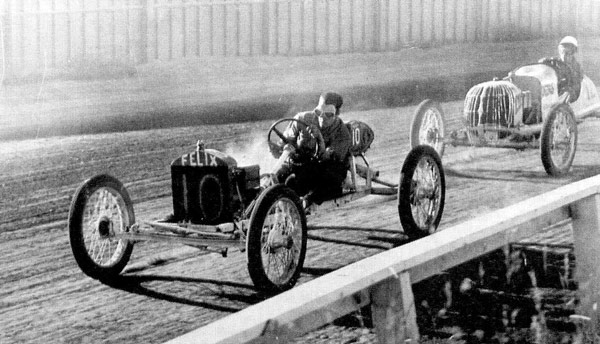 |
|
#1529 - In 1941 the good folks at the
Lions Club of Calgary, Canada, decided to
promote an auto race for stripped-down Model Ts
to raise money for children in England orphaned
by the war. What a success it turned out to be.
Twelve thousand spectators turned out on
September 1 for the 100-mile event, raising a
sprightly $5000 for the kids. So, the races at
the Stampede Fairgrounds at Victoria Park kept
right on going. Here Len Erlam leads into the
turn in 1945. The cars, still sans seat belt and
body (and the drivers sans helmet and belt),
were beginning to look something other than
Model T. They would soon earn the designation as
Sprint Cars. Photo from THE SPEEDIEST LAND
TRAVELER, by Richard McDonell. (Tim Erlam
Collection) |
|
A |
|
 |
|
#1528 - We have been just a little
worried about our buddy Jimmy Sills. Jimmy was
very professorial in his day at his Northern
California Sprint Car driving school, mentoring
many a student in the ins and outs of
competitive driving. However, he could not quite
recall the name of this particularly attractive
attendee. You can take it to the bank we would
have remembered. (Sills Collection) |
|
A |
|
 |
|
#1527 - Joe Barzda and his brother Jim
were proprietors of California Speed & Sports
Shop for years and years in New Brunswick, NJ,
and fielded many cars – both for Joe and for
others. Here their crew squeezes one of the
first Chevy V-8s into a Sprinter. Joe’s career,
which included several attempts at the
Brickyard, was sadly marked by racing
fatalities. In 1940 at Union, NJ, he was caught
up in a Midget melee that took the life of
promising Tommy Simonetti. In August nineteen
seasons later he crashed with Pittsburgh’s Van
Johnson aboard the Vargo Champ Car, the same car
in which Dick Linder had died at Trenton in
April (see
Photo of the Day #1396). Both Barzda and
Johnson flipped, and Johnson died. That was
pretty much it for the driving, but Joe
continued on as a car owner. From THE
EASTERN BULL RINGS, by Buzz Rose. (Paul
Barzda Collection) |
|
A |
|
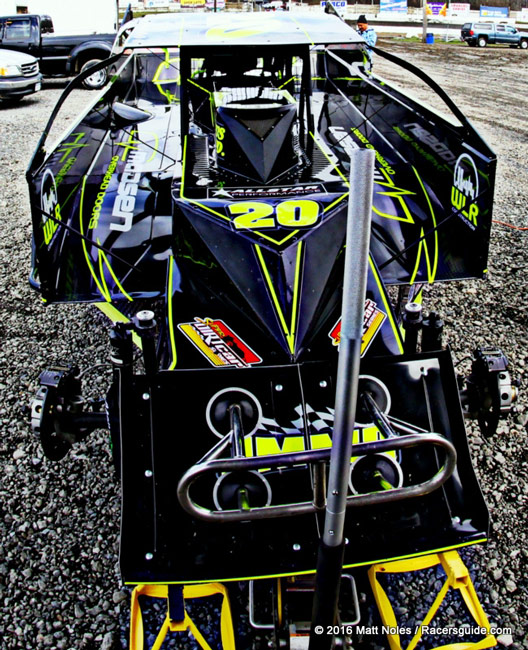 |
|
#1526 - He was most definitely the
fastest car all day at Brett Deyo's Short Track
Super Series Hard Clay Open. And Brett “the
Corporate Jet” Hearn led nearly all 50 circuits
to win yet another Modified feature at the
Orange County Fair Speedway (Middletown, NY),
beating Tommy Meier and Danny Johnson to the
line. However, during post-race inspection, the
Madsen Overhead Door team refused to remove the
valve covers on their small-block for a P&G
test. This resulted in Hearn being disqualified,
and the victory and $5000 payday moved on to
second-place finisher Tommy Meier. Hearn
proceeded to go on to win the 25-lap crate
sportsman feature which paid $1000-to-win and he
immediately donated his winnings to charity.
(Photo and Caption by Matt Noles/Racersguide.com) |
|
A |
|
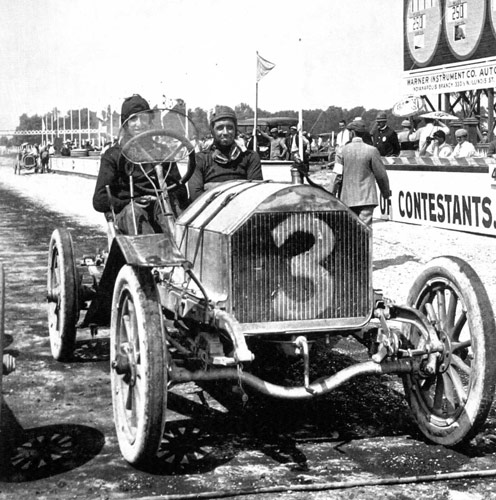 |
#1525 - On August 19, 1909, a 250-mile
championship race was held at Indianapolis Motor
Speedway. Wilfred “Ray” Bourque, a Canadian hill
climber who often raced for the Knox automobile
team out of Massachusetts, was running second of
nine starters at the145-miles mark with his
riding mechanic, Harry Holcomb. Coming off the
fourth turn, they got sideways and shot into the
infield. The car flipped and both were killed,
the first recorded fatalities in the history of
the Brickyard.
RACERS AT REST: The Checkered Flag,
1905-2008, by Buzz Rose, Joe Heisler, Fred
Chaparro, and Jeff Sharpe. (Scott Photo)
|
|
A |
|
 |
|
#1524 - That Bobby Santos III sure is
fleet-footed. Some years ago he turned a
blistering lap on the 7/8ths-mile Iowa Speedway
for an all-time closed-course Midget record of
147 mph. Back at Coastal 181, we asked him what
it felt like. "Aw, nuthin' much," he said."But
it did get a little breezy." Yesterday we got a
call from Alabama. The "King of the Wing"
Sprinters were at Montgomery Motor Speedway.
Four of them beat the track record, and, yep,
the fastest was Bobby Santos with a 15.03 on the
half. He's fast in Modifieds, too, as shown
here, winning his second straight Spring Sizzler
at Stafford Speedway in 2014. (Santos
Collection) |
|
a |
|
 |
#1523 - It always seemed to
me that flipping to the left ended up more
painful than flipping to the right. You had to
feel sorry for George Snider #55 in this one. He
was running Winchester on July 27, 1975, high
and wide, leading in the USAC Sprint points.
Then he got into Darl Harrison in the #14 Smith
Chevy, flipped, slid on his cage, and catapulted
out of the place. The result: two broken arms
and no shot at the title. (John Mahoney Photo,
Cal Lane Collection)
|
|
A |
|
 |
|
#1522 - Even the
celebrated National Open for dirt track
Modifieds and Sportsman was a pretty gritty
affair in 1956. Here Dutch Hoag, the undisputed
king of the old mile circle in Langhorne, PA,
after the 100-miler. It was some battle. At the
green flag Buck Holliday darted to the lead in
the 60-car field. By halfway, defending winner
Pete Corey, Lee Bliss, Shorty York, Pee Wee
Jones, Don Hendenberg, and George Horvath had
all taken turns at the head of the parade. Then
on lap 55 Hoag, from Penn Yann, NY, rim rode
into the lead and held it until the checker for
his first Langhorne win and a new race record of
77.34mph. The model of competence, Hoag went on
to victory in 1960 and 1963 on dirt and in 1967
and 1968 when the surface was pavement. (Photo
by Dick Hurd, Ford Easton Collection) |
|
a |
|
 |
|
#1521 - Saturday,
March 26 was a picture-perfect day for the Doug
Hoffman 60 Over, with a great field of 35 cars
and an outstanding crowd. There at Bridgeport
(NJ) Speedway, they place the starting lineup
down behind the stands so the fans can get up
close and personal with the drivers. Here’s the
starting lineup ready to roll off. Dom Buffalino
won it, chased by Ryan Godown and Rick Laubach.
Photo and Caption by Our Man from Amsterdam,
Dave Dalesandro (Racersguide.com) |
|
a |
|
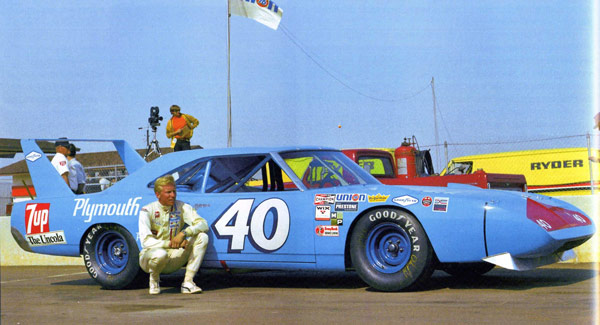 |
#1520 - George
Wallace was definitely his own kind of engineer
on the Superbird team in NASCAR around 1970. He
sure got Pete Hamilton’s attention. Pete (shown
above) recalls being surprised “anyone would get
in a car at Talladega with us and run 190mph.
George would take out a handkerchief out and
hold it inside the car to see what the wind was
doing. The guy trusted me enough where he’s
wrapped up back there where the back seat would
be with his legs and arms and backside hung
around the roll cage to see what the air was
doing inside the car. I knew that was a lot
sicker than we were. Holy cow! It was
unbelievable. It was a wild time.” Quote and
photo from
DODGE DAYTONA AND PLYMOUTH SUPERBIRD: Design,
Development, Production and Competition,
by Steve Lehto. (Photo courtesy of Cal Lane)
|
|
a |
|
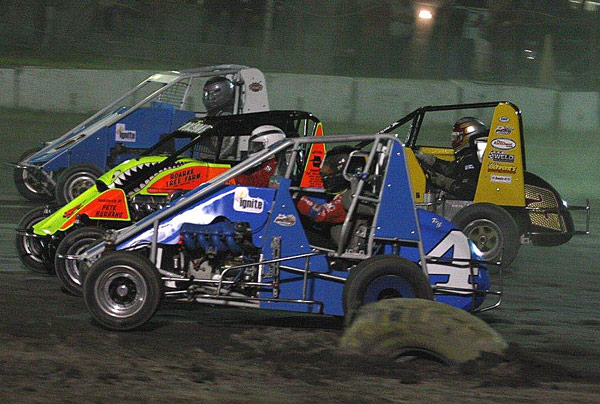 |
#1519 - Here's a
snarly bunch at Bear Ridge (VT) Speedway a few
seasons back. Joe Krawiec #4, Scott Holcomb #47,
and Scott Viets #2 assume tight formation, while
the adventuresome Kevin Chaffee #6 contemplates
four deep. Chaffee impressed many at the Chili
Bowl last January in Skip Matczak's car. And he
himself came away pretty impressed with the
speeds in Tulsa. (Alan Ward Photo)
|
|
a |
|
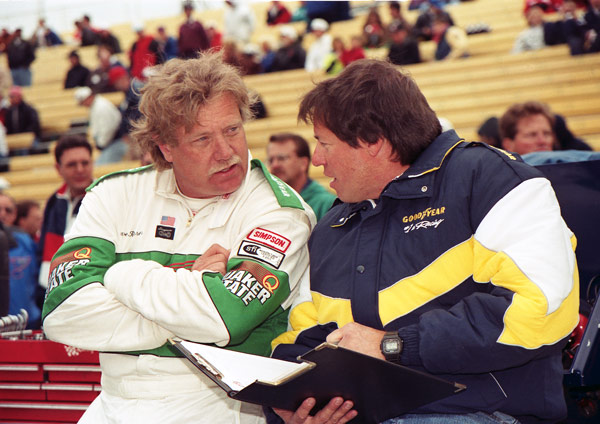 |
|
#1518 -
“Dubbed ‘King of the Outlaws’ by Sprint Car
fans, Steve Kinser comes by that name honestly.
Since 1978 he has been World of Outlaws series
champion 20 times. His official WoO victory
total is well over 500; add 300 wins with other
sanctioning bodies or in WoO preliminary-night
features. In 1997, Steve made his only Indy 500
appearance. He’s shown here with chief mechanic
Owen Snyder. He was on pace for a top-10 finish
until he clipped a slowing car 11 laps from the
checkers. He placed 14th.” Quote and Photo from
THE STINGER: 273 Drivers Speeding Towards Hope,
by Bones Bourcier and John Andretti. (John
Mahoney Photo) |
|
a |
|
 |
#1517 -
The late 1950s and early ’60s were really spicy
in short track racing. Some of the pre-war
coupes and coaches remained “full coupes,” while
at other venues they were chopped, channeled,
and modified – on their way to becoming
Supermodifieds or Sprint Cars. Notable driver
Gavin Couper labeled the pavement “Cut-downs” of
New England so dangerous “you could get hurt
looking at one.” Out to the west on the dirt of
upstate New York, it seemed no different. This
was Joe Povoski’s “Bug” – a radicalized 1935
Ford shown at Hornell Raceway in 1962. The car
is much remembered for the Fish carburetion on
that flathead, but it probably wouldn’t have
been a good idea to flip it. (Cal Lane Photo)
|
|
a |
|
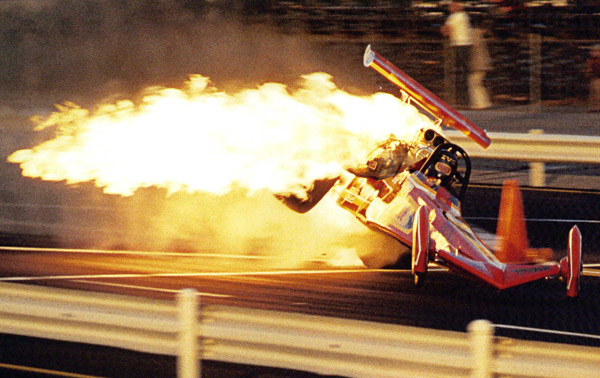 |
|
#1516 -
The reliably dramatic TV Tommy Ivo may have been
a tad over the top this night at Pomona,
California, but he did walk away. From
TOP
FUEL DRAGSTERS: Drag Racing’s Rear-Engine
Revolution, by Steve Reyes. (Paul Sadler
Photo) |
|
A |
|
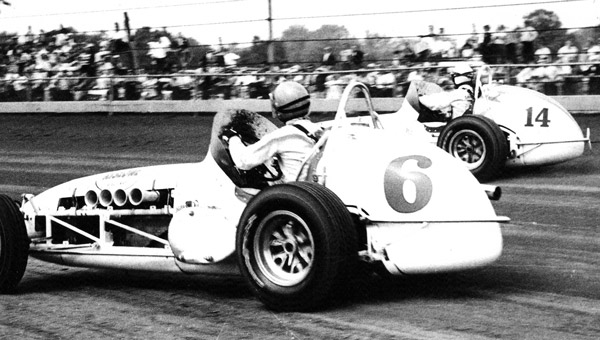 |
|
#1515 -
On September 9, 1967, the
Champ Cars were still the featured division at
the Hoosier Hundred at the Indiana State
Fairgrounds. A.J. Foyt, upstairs, and Bobby
Unser were surely in the hunt, both so
stylistically relaxed. Foyt was after his fourth
win of the event, while Unser poked his nose
beneath, seeking his first. When the Fat Lady
sang, however, Mario Andretti was at her side
for the second time in two years. (Cal Lane
Collection) |
|
A |
|
 |
|
#1514 - This was
the colorful Eddie Sachs, dutifully situated on
a red carpet in his American Red Ball Special
Halibrand/Ford at Indy in 1964. He started in
17th and on lap two was caught up in the
historic front-stretch inferno. Johnny
Rutherford recalls following him. “I was right
with Eddie. One thing I remember is that Eddie
had a fluorescent orange ball (honoring his
sponsor) painted on the top of his helmet. I
could see that orange ball on either side of his
roll bar as he moved his head looking for a way
through. I was hard on the brakes, concentrating
on Eddie, as we headed into this curtain [of
fire] being drawn across the front
straightaway.” Johnny made it through; Eddie did
not. A dark tarp was draped over the #25. (Photo
Cal Lane Collection, quote from
As A Matter Of Fact, I AM Parnelli Jones,
by Parnelli Jones with Bones Bourcier) |
|
A |
|
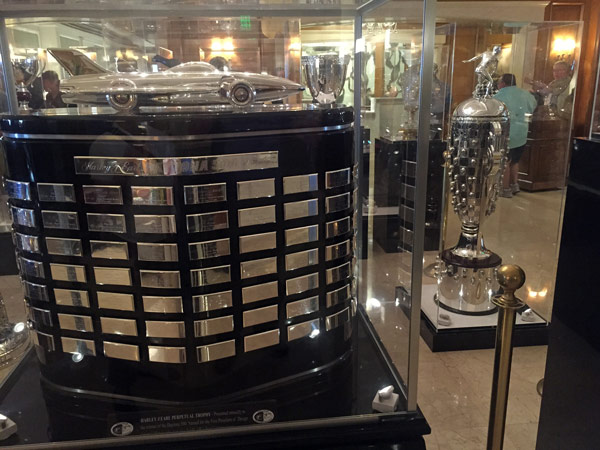 |
|
#1513 - On March 11-13, 2016,
the golf course at the elegant Ritz Carlton
Hotel on Amelia Island in northern Florida
turned into the stage for one of the most
magnificent car shows of the year, the Concours
d’Elegance. In an event that stretched over
three full days, hundreds of hot rods, customs,
and magnificent vintage street and racing cars
were seen by hundreds of thousands of guests.
The hotel lobby was turned into part of the show
with a display of trophies from around the
world. Included were the trophies of America’s
two most important races, the Daytona 500
(Harley J. Earl Trophy) and the Indy 500 (Borg
Warner Trophy) which sat nearly side by side.
Others in the display were from the Monza “Race
of Two Worlds” event that pitted Indy cars and
drivers against their counterparts in F-1. There
was a trophy from Indy that was retired in the
1930s and stood nearly six feet tall. The last
winner was Harry Hartz. The stars of the show,
however, were the cars. (Dick Berggren caption
and photo) |
|
a |
|
 |
|
#1512 - Tom Steiner, who raced
in the 1960s and ’70s, was said to be one
top-notch pavement Midgeteer. Along the way he
won URARA, NAMAR, and BADGER championships. On
this day in the mid-’70s at Indiana State
Fairgrounds Coliseum’s indoor twin 35-lappers,
he hustled his dad’s VW to the front. He had
three reasons to look so pleased with himself.
First, it was his first-ever USAC indoor win.
The other two are obvious. After the show, Tom
was off to
Florida
with his traveling companion at the time, none
other than Kevin Olson. Later he had a horrid
highway crash that essentially ended his career.
(Stan Kalwasinksi Photo, Cal Lane Collection) |
|
A |
|
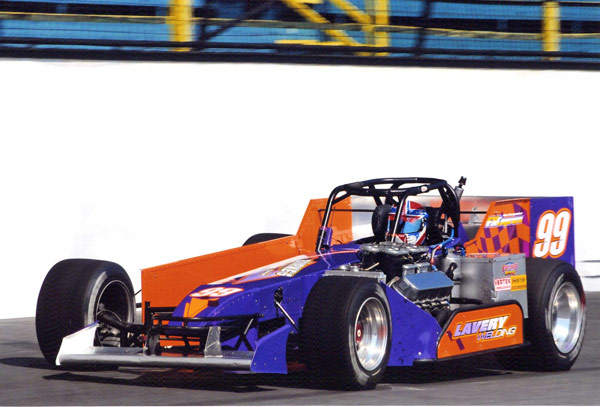 |
|
#1511 - Joey Payne had quite
the Classic at Oswego last fall. Shown above, he
started in 24th and slid back to a conservative
32nd. Then, late in the race, he started a
world-class run to the front, ending up in an
impressive third place. It was emotional on the
podium. Joey announced he would not be back.
Today he recalls, “I was thinking I had lost my
focus. You see, my son Anthony was off somewhere
else in the process of winning the NEMA Lites
Championship, and I couldn’t get my mind off of
him. I was texting every ten minutes. I’d raced
all my life. It seemed like time.” But the next
day was pretty emotional, too. That’s when the
family had a meeting and told him to get real;
his wife said there was no way he was going to
quit until after she joined him in victory lane
at the Classic. So, “I changed my mind. My other
son has started racing too, so now I’m
concentrating on when all three of us will be on
the track at once.” (Chris Burgess Photo) |
|
a |
|
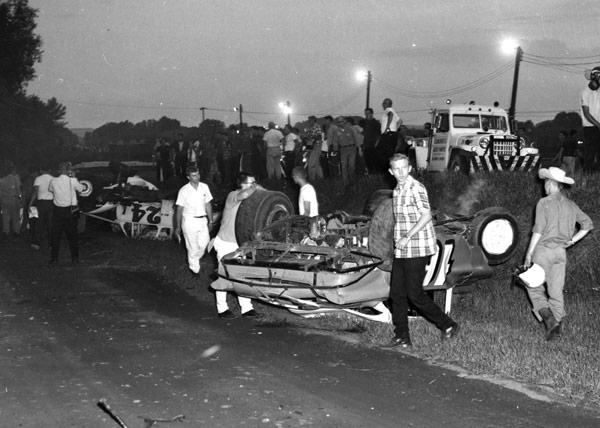 |
|
#1510 -
This Photo of the Day first ran as
#1373.
Duncan Clark, son of big block Modified star
Dick Clark, came by the Coastal 181 booth at the
Gater Motorsports Expo in New York last weekend,
and we chuckled about it. Duncan said, “I bet
that was the night that my Dad and Kenny
Shoemaker both flipped on the backstretch at
Fonda and landed upside down. Both still hanging
in their cars, Kenny yelled over, ‘Dick, did you
hit me?’ Of course Dad hollered back, ‘No,
Kenny, you hit me!’ The conversation ended when
Kenny said, ‘Never mind. Now comes the part I
hate most.’” He was unbuckling his belts, about
to land with a thud on the inside of the roof.
Kenny had to be approaching 300 pounds in those
days. Tremors were likely felt the along the
entirety of the Mohawk River Valley. (Coastal
181 Collection) |
|
a |
|
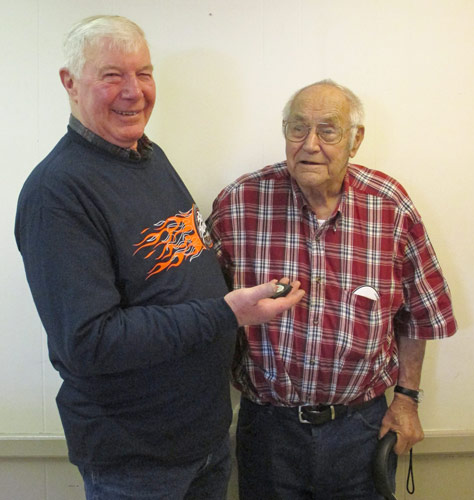 |
|
#1509 -
Adrian Flath (L) and perennial Langhorne winner
Dutch Hoag, two upstate New York racing greats,
reunited at the Coastal 181 booth at the Gater
Motorsports Expo in Syracuse last Saturday.
Naturally, they got to reminiscing. Turns out
that 50 years ago, Adrian hauled down to
Langhorne with his car and struggled a bit. He
met Dutch and asked if he could come to visit
back in New York for some advice. When he did,
Dutch opened his garage fully. Adrian picked up
an A-frame and asked Dutch how big it was. Dutch
responded. “Adrian, there’s a tape measure in
that tool box. And don’t you put it back until
you leave. You should never be without a tape
measure.” When Adrian got home, he bought one –
and it’s been in his pocket ever since. Yup, as
you can see, he pulled it right out to show
Dutch at the show. (Coastal 181 Photo) |
|
a |
|
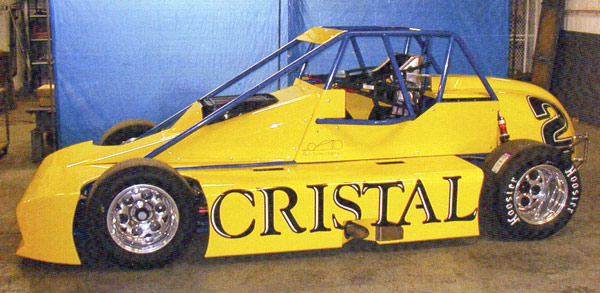 |
|
#1508 -
“When NASCAR Chairman Bill France, Jr. and USAC
got together to create a new Silver Crown car,
Riley Tech [Bob Riley’s world-class motorsports
design firm] was hired to design and build it.
We met all the criteria, but, when the fans did
not like the appearance, USAC decided the car
looked too different from the traditional cars.
It was a tough lesson. You must pay attention to
the appearance for an established category.”
Quote and Photo from
THE ART OF RACE CAR
DESIGN, by Bob Riley with Jonathan Ingram. |
|
A |
|
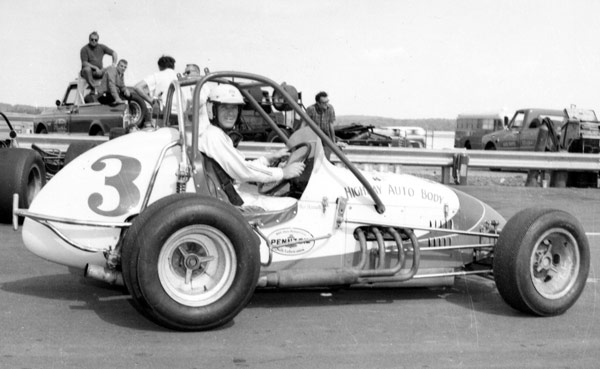 |
#1507 - Things
were just getting started in Pocono,
Pennsylvania. On September 28, 1969 a formidable
wide-open competition was held, bringing all
kinds of open-wheel machines, including Hank
Rogers in the Highway Auto Body Sprinter. The
big track wasn’t complete at the time, and so
the racing was held on the three-quarter-miler.
There were upright Supers, rear-engine cars, and
former Indy roadsters. It all turned savagely
tragic. Eighteen-year-old Troy Ruttman Jr., in
just his first race, pierced the fence and
perished. (Dale Snyder Photo)
|
|
a |
|
 |
|
#1506 - A crew member taped a pad on
Lloyd Ruby’s knee to make the inside of the
cramped Daniel’s Cablevision Indy Car more
comfortable before running the 200 at Trenton in
1970. Folks were watching Ruby, wondering if his
horrid luck on the 1.5-mile oval would continue.
He had dropped out of 13 of 18 starts in New
Jersey, mostly for mechanical gremlins. And, on
this day, things were ominous. Al Unser had
already snatched the pole position from under
Ruby’s nose. But the duct tape ergonomics did
its job. Ruby won it, his final USAC
Championship victory. From
HARD LUCK LLOYD, by John Lingle
(Racemaker Press Archives) |
|
a |
|
 |
#1505 - Some of the delight of the old
time marquee races was that you never knew who
would tow in. Case in point was the National
Open at Williams Grove, PA. On October 29, 1967,
Larry “Boom Boom” Cannon was in town with Kenny
Weld (#91), both with war wagons bearing scars
of the season past. Bobby Adamson won. (Walter
T. Chernokal Photo, North East Motor Sports
Museum Collection)
|
|
a |
|
.jpg) |
|
#1504 - The summer after we published
our book
As A Matter Of Fact I AM Parnelli Jones,
Parnelli (L) and Jimmy Dilamarter (his long-time
crew chief and current business manager) came
out to New Hampshire Motor Speedway. They were
trying out a drop-dead beautiful Modified that
Jimmy had built. (Jimmy also ran it around
Indianapolis - see the
8-7-14 Tearoff ). Of course, while there,
they were obliged to look around at some pretty
modest other equipment…. |
|
A |
|
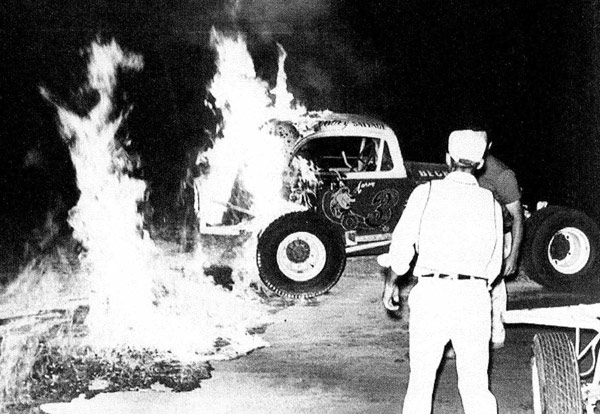 |
|
#1503 - There was a glorious era of
dirt track racing in the greater Milwaukee area
from the late 1950s into the 1970s. The cars,
cutdowns of every flavor, were fast, and all the
drivers became local heroes. During the summer
of 1970, racer Aaron Solsrud reached his
pinnacle. He was red hot, though never more so
than on the night of August 25 at Beaver Dam
Speedway. Early on in the feature he got mixed
up in a multi-car episode. Things went downhill
from there. Coming back through the pack, he
flipped right over Wally Jors’ car and tore his
own fuel line off in the process. He did land on
all four, but the fuel was sparked and flames
lit the nighttime air. Solsrud was able to
spring to safety, but the drama was not over.
Safety crew workers were unable to get the pin
out of their fire extinguisher, and the blaze
burned on. Finally someone cruised over with the
track water truck to douse the inferno, but you
can imagine what shape the car was in. From
THE MILWAUKEE MODIFIED ERA 1959-1973,
by Fr. Dale Grubba. (Mike Buday Photo, Patrick
Heaney Collection) |
|
A |
|
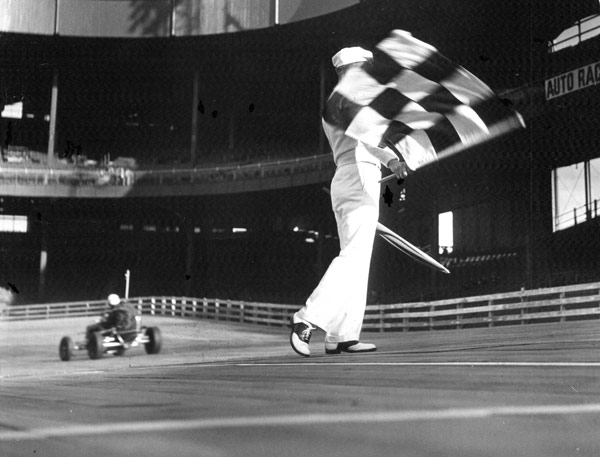 |
|
#1502 - This artful shot was taken at
the Polo Grounds in New York in 1948. A group of
visionaries had built a portable indoor board
track for Midgets. A disappointment in New York,
it would subsequently be dismantled and moved to
San Jose, CA. Unfortunately, it drew no bigger
crowds out west and it sallied forth no further.
(RA Silvia Collection) |
|
a |
|
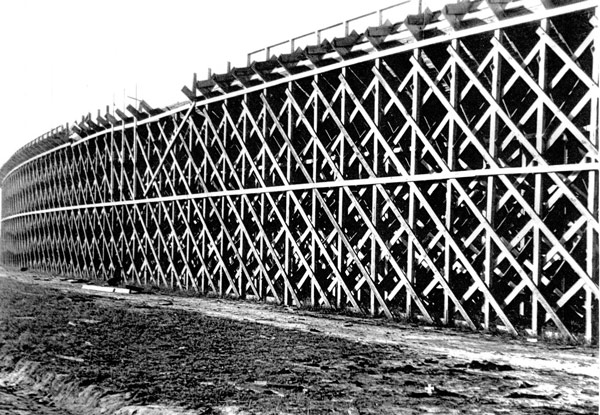 |
|
#1501 - A grim reminder of the
darkness of the board-track era of the 1920s.
This was the Kansas City Speedway, a 1.25-mile
oval with turns banked 35 degrees. On September
17, 1922 Roscoe Sarles, a respected racer with
six AAA feature wins and four starts at Indy,
broke a steering knuckle on his Durant, tangled
with Pete DePaolo, and flew over the guard rail.
The car landed far below, upside down and on
fire on the spot marked in the lower right. Sarles was trapped beneath and did not
survive. (RA Silvia Collection) |
|
A |
|
|
a |
 Previous
Photos of the Day - PAGE 7 Previous
Photos of the Day - PAGE 7
 Previous
Photos of the Day - PAGE 6 Previous
Photos of the Day - PAGE 6
 Previous
Photos of the Day - PAGE 5 Previous
Photos of the Day - PAGE 5
 Previous
Photos of the Day - PAGE 4 Previous
Photos of the Day - PAGE 4
 Previous
Photos of the Day - PAGE 3 Previous
Photos of the Day - PAGE 3
 Previous
Photos of the Day - PAGE 2 Previous
Photos of the Day - PAGE 2
 Previous
Photos of the Day - PAGE 1 Previous
Photos of the Day - PAGE 1 |
|
|